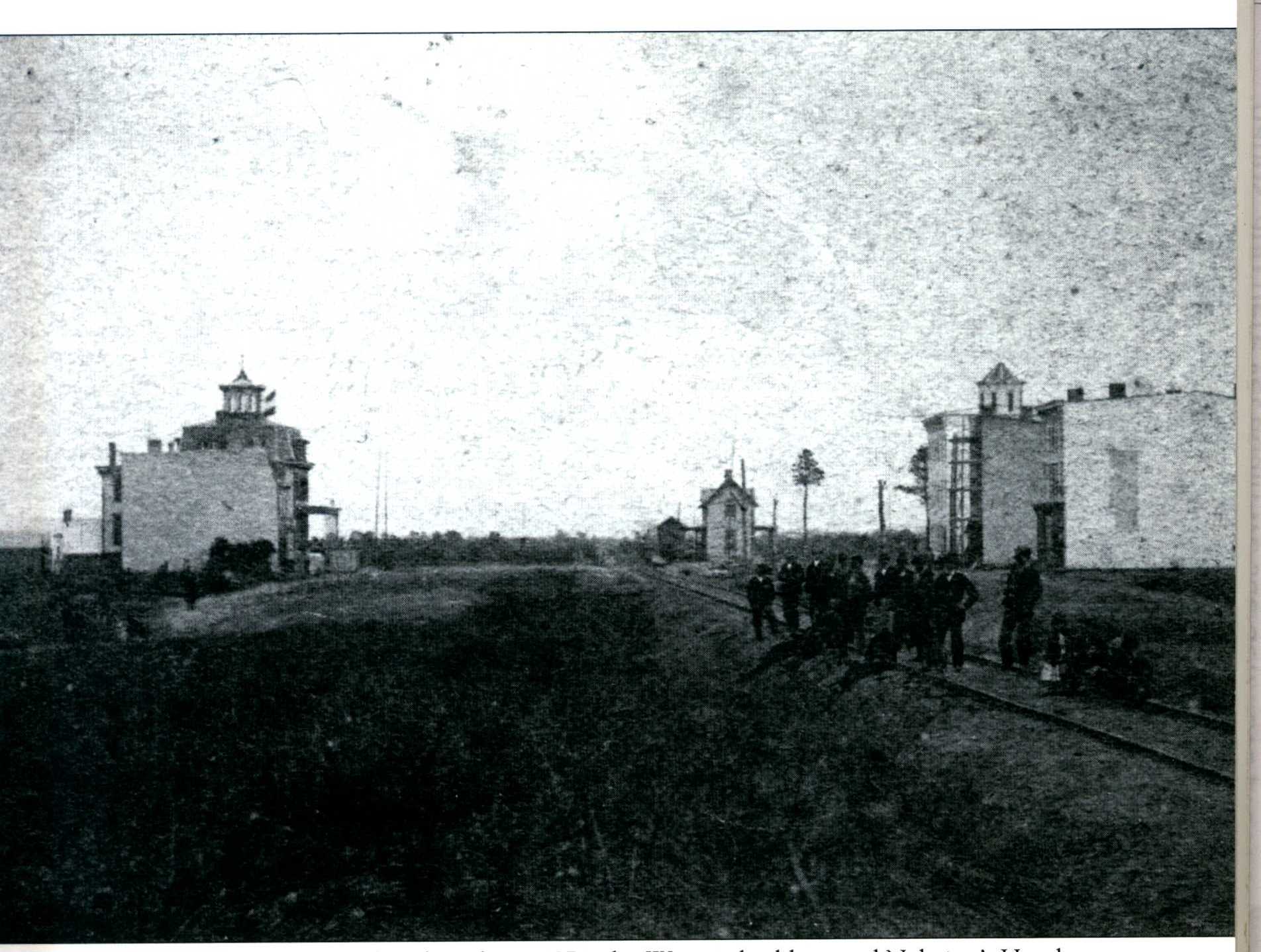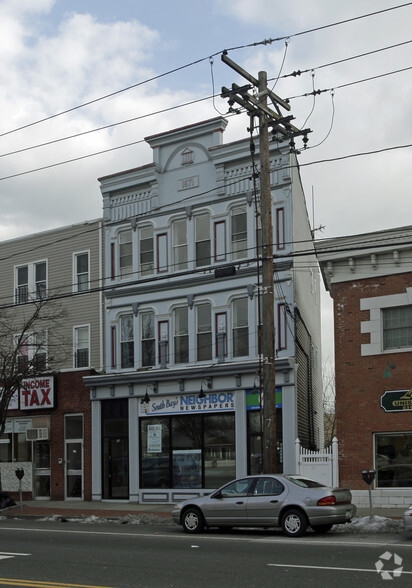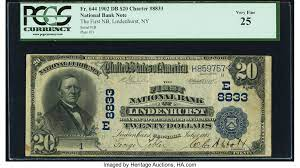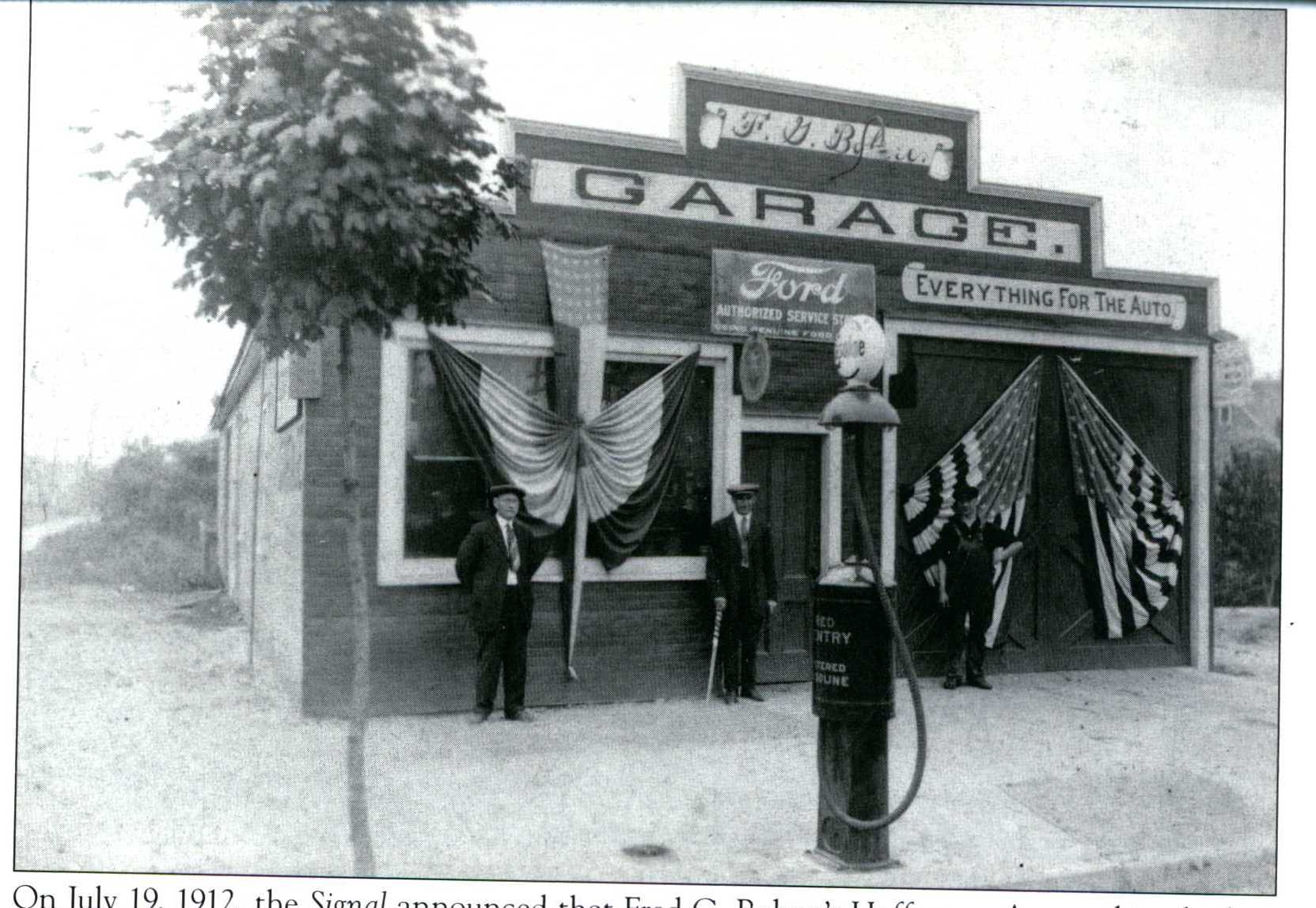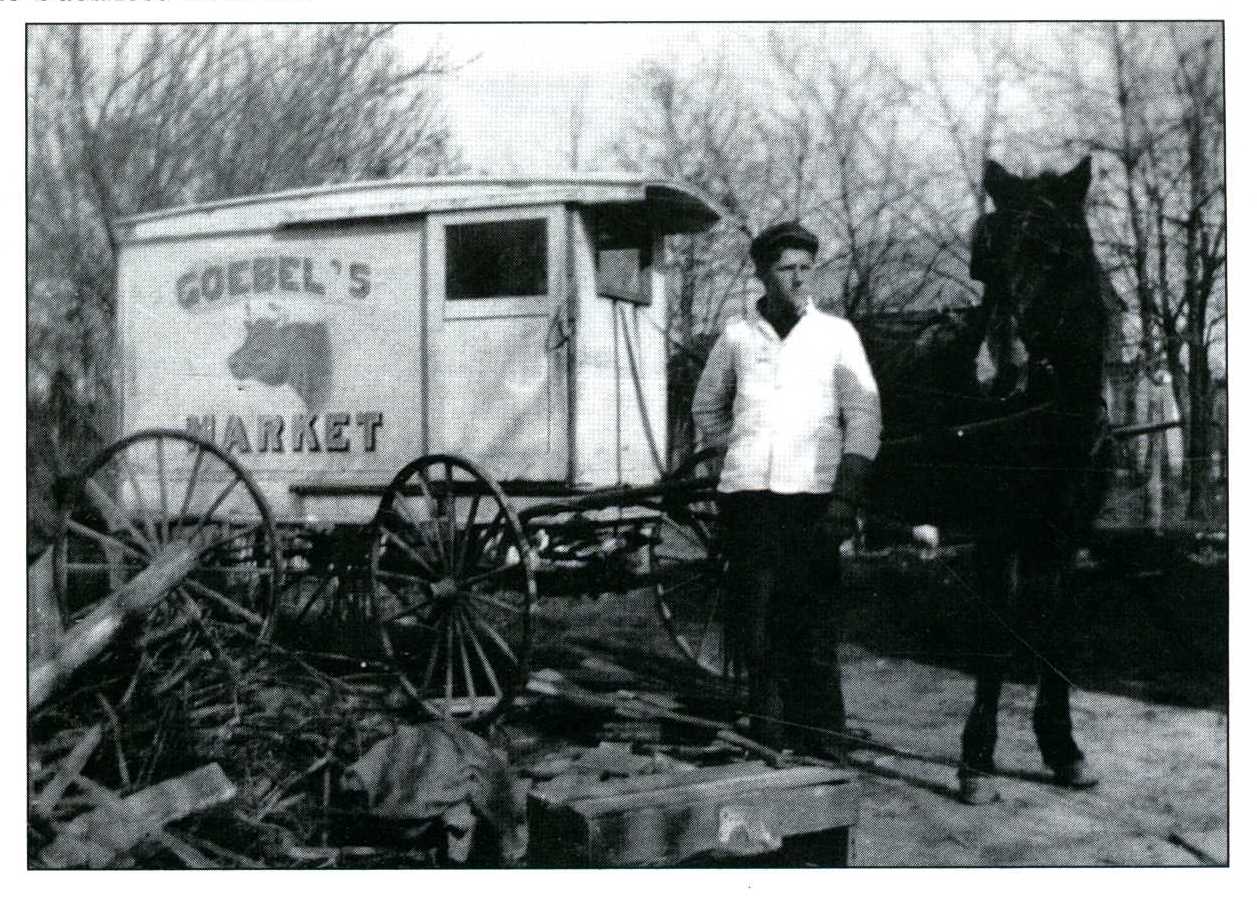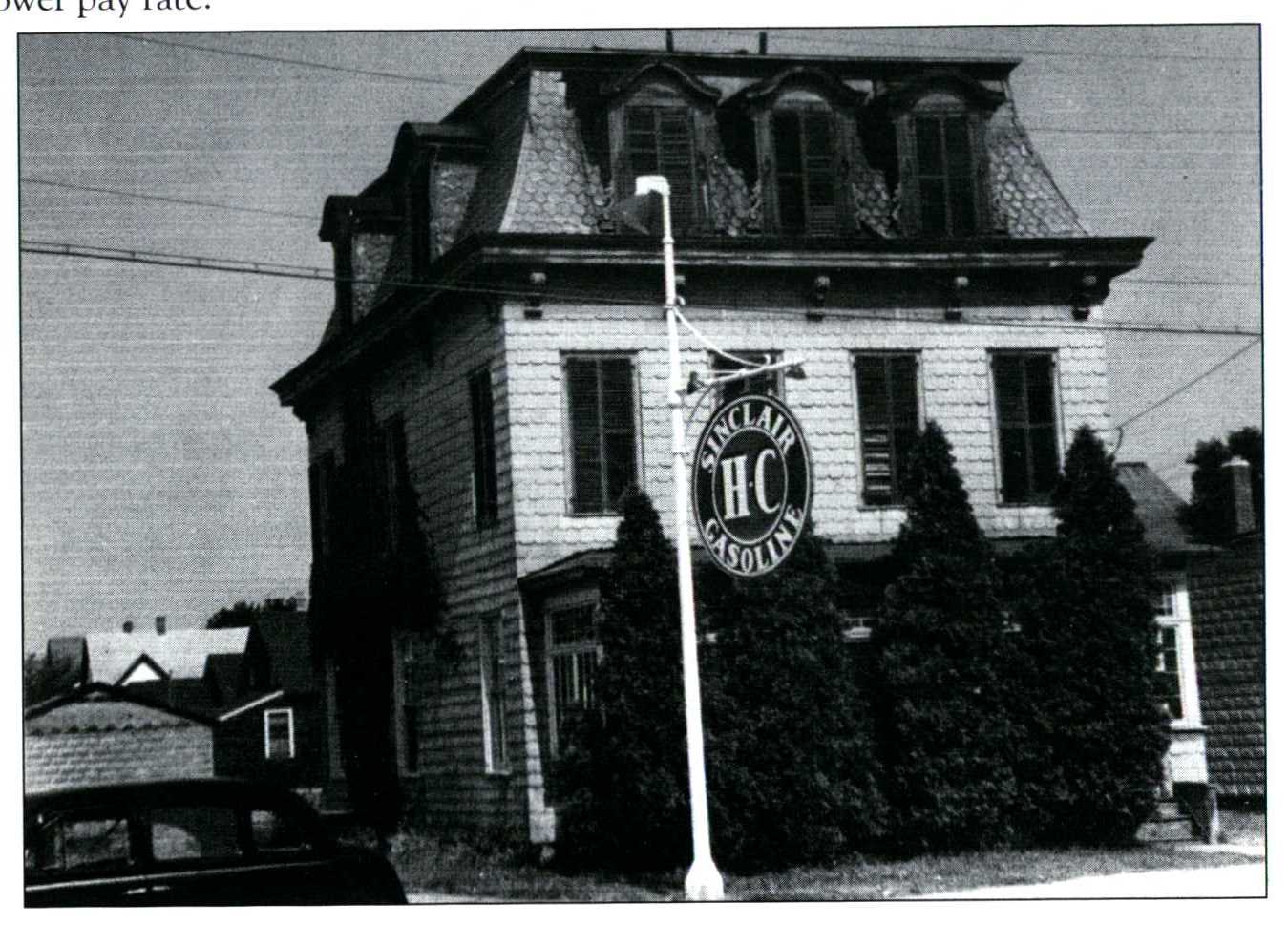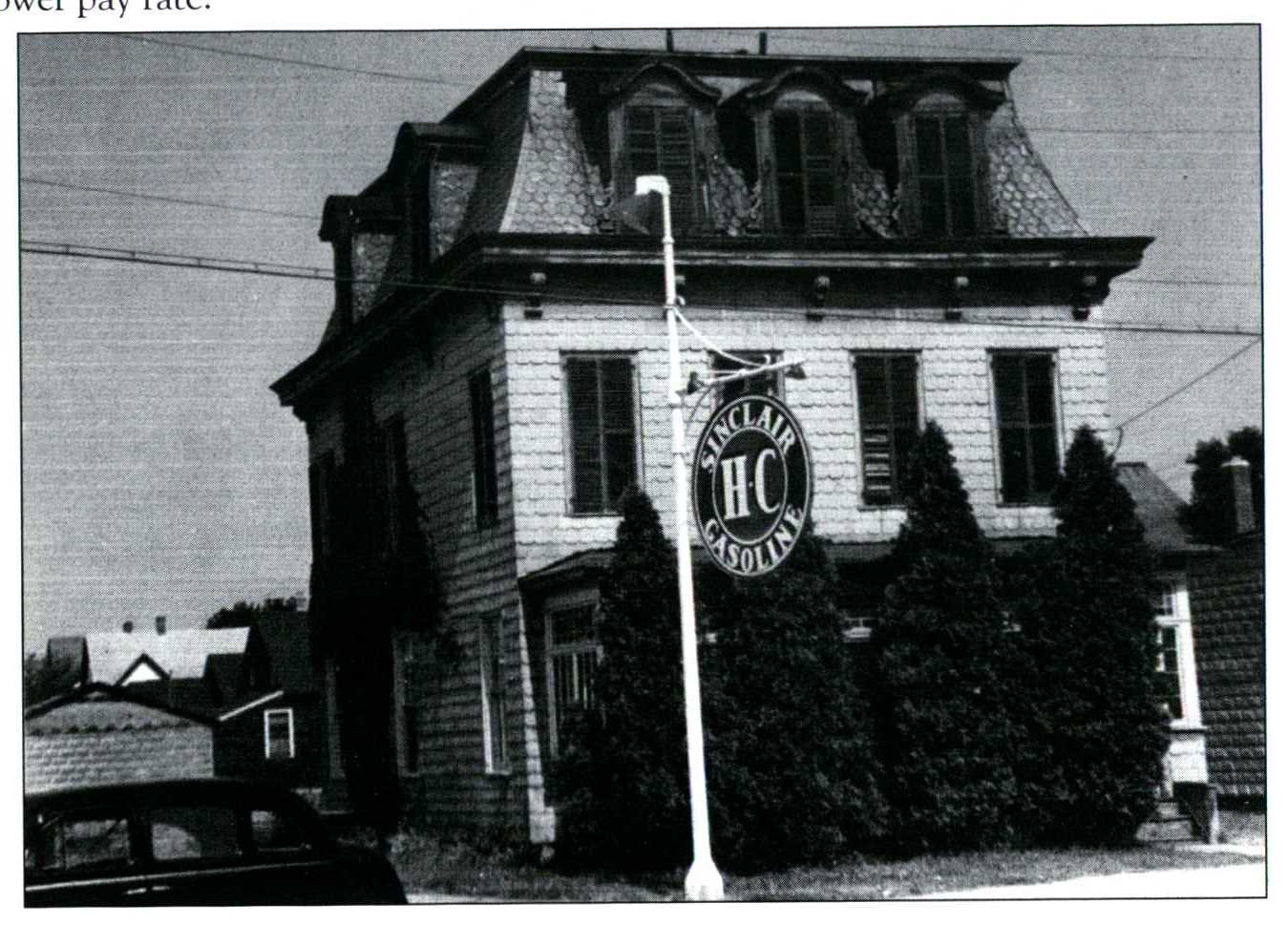"Downtown" Lindenhurst (Breslau) in 1871, from Hoffman Avenue looking east toward the intersection with Wellwood Avenue. On the left are the Wagner building & Nehring's Hotel, in the middle are the South Side Railroad depot & freight house & on the right are Gleste's Hotel & the bank building, all having been built & opened within the past year. To the right of Hoffman Avenue are the railroad tracks.
Additional Items
Gleste's Hotel (left) & Bank Building, 1871
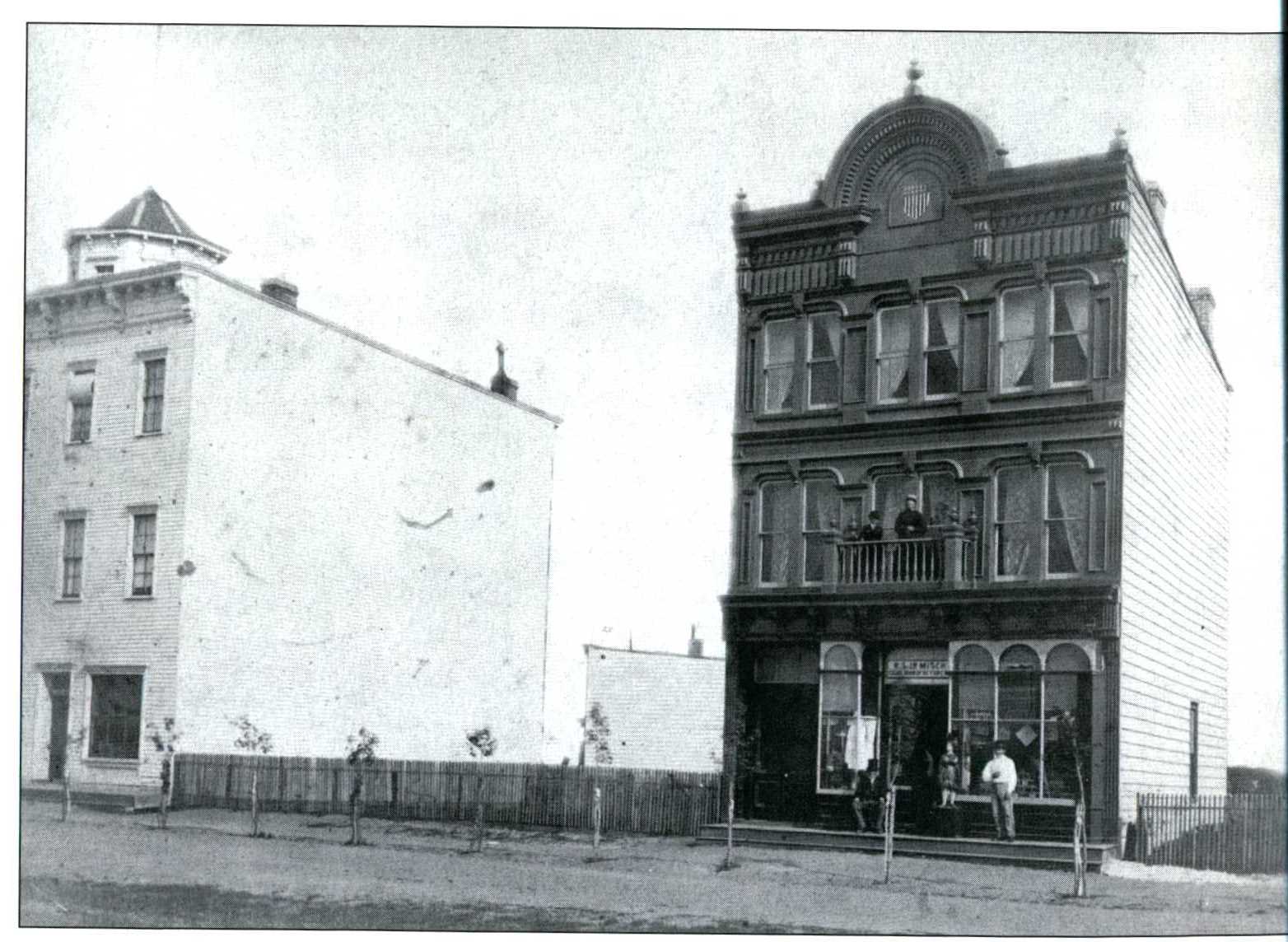
Welwood & Schleier intended Breslau to have a bank. Construction & selection of officers were completed by March 1871, but the bank did not come to fruition. Although occupied by other businesses, the building was known as "the bank building". In 1907, a group of residents established the First National Bank of Lindenhurst. The 1st floor of the old bank building, owned by Judge George W. Irmisch, was rented annually for $180.
Bank Building, 1907
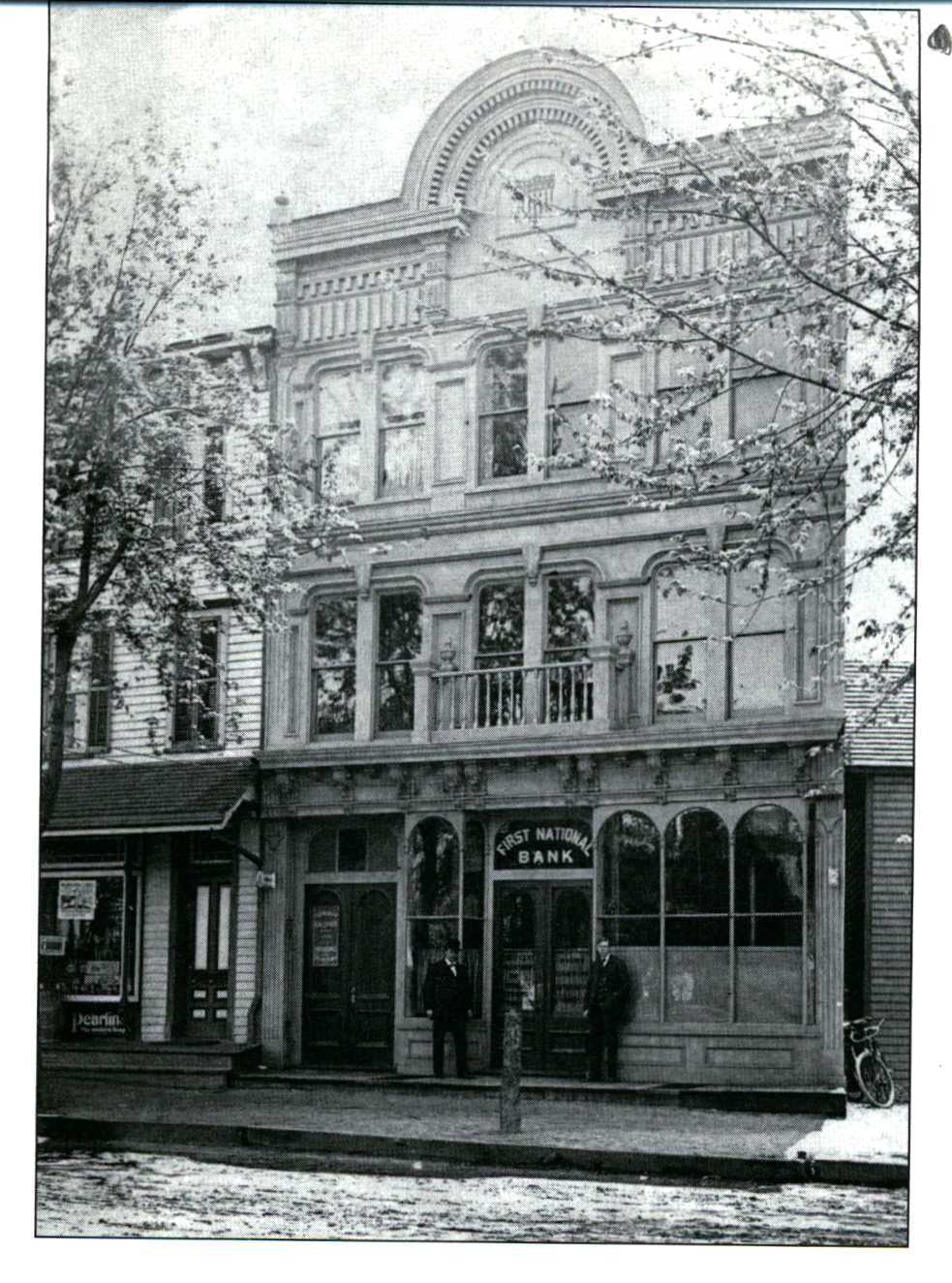
Wilbur C. Abbot, Vulcanite Manufacturing Co. superintendent, was selected as the 1st bank president. A 3-ton safe was installed, & the new East Hoffman Avenue bank opened on Monday, September 9, 1907. The 1st day's deposits were 100,099.48. The Signal reported that "Miss Lottie Irmisch was the 1st depositor & others lined up in rapid succession". The thriving institution soon expanded, purchasing a Wellwood Avenue plot in 1911.
First National Bank of Lindenhurst, 1912
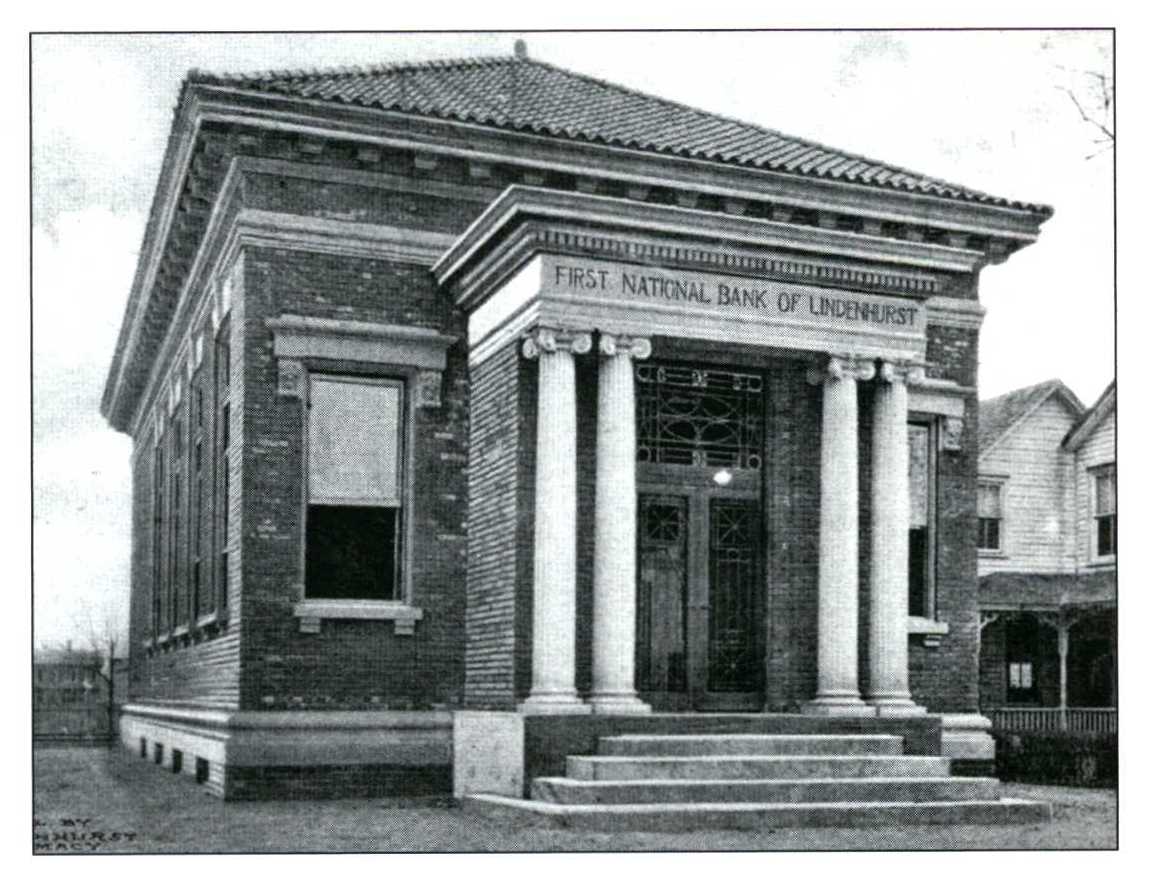
The new bank opened on July 20, 1912, a brick stronghold with tile roof, granite columns, and marble interior lighted by gas and electricity. It was touted by the Signal as "one of two bank buildings on Long Island... equipped with an electric bank protection device." Its "fireproof" designation was tested by a 1914 business district fire. The Signal declared, "Lindenhurst Bank building acted as a fire wall saving the south side of the village."
1st National Bank of Lindenhurst after 1914 Fire
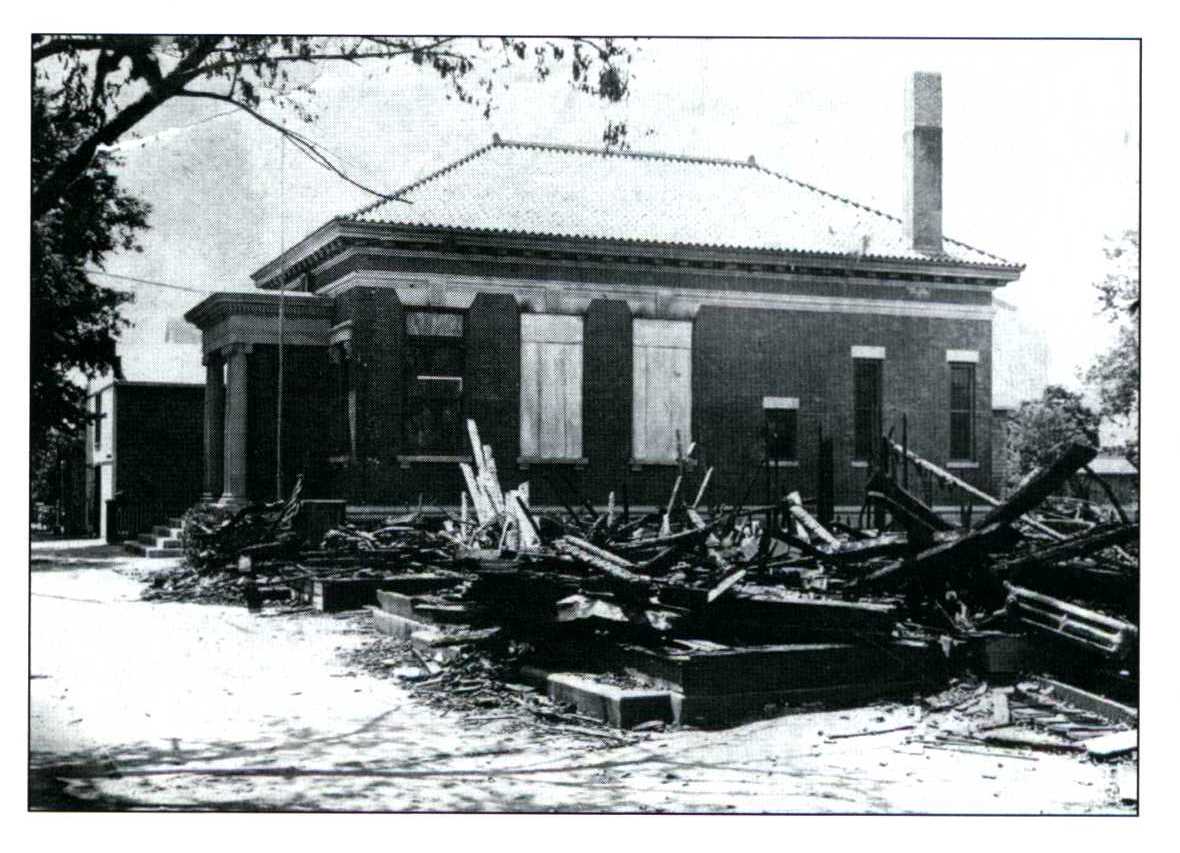
Edward & Flora Gleste's Wellwood Avenue home was destroyed by fire on June 20, 1914, along with that of neighbors Frederick & Anna Kienle, 5 barns, & a windmill. George Gleste lost his 2nd fireman's uniform in the house fire, having lost his 1st uniform 2 years prior in the hotel. The brick bank building reportedly acted as a fire wall, keeping the fire from spreading.
Charles Wild, barber
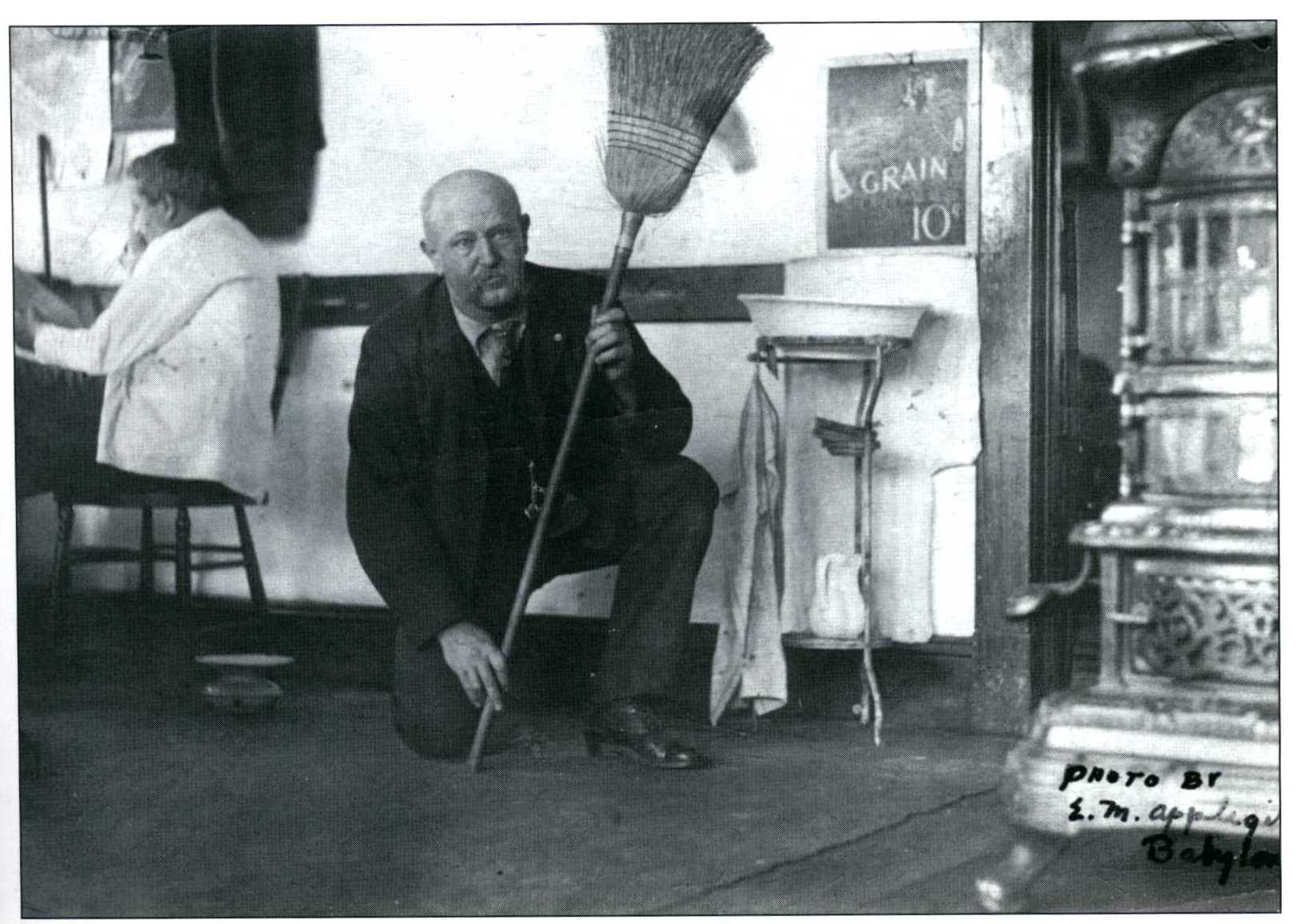
Charles Wild opened his barbershop in 1902 at East Hoffman Avenue & South High Street. On busy Sunday mornings, his wife, Anna, assisted by lathering customers for their shave. A haircut & shave was 25 cents (2 bits); children's haircuts were 10 cents. Also a local constable who could be called to duty in the middle of a haircut, Wild retired in 1922. Other early barbers included George Oelhoff, Peter Kiefer, Henry Strack & George Pearsall.
Zeilner Barbershop
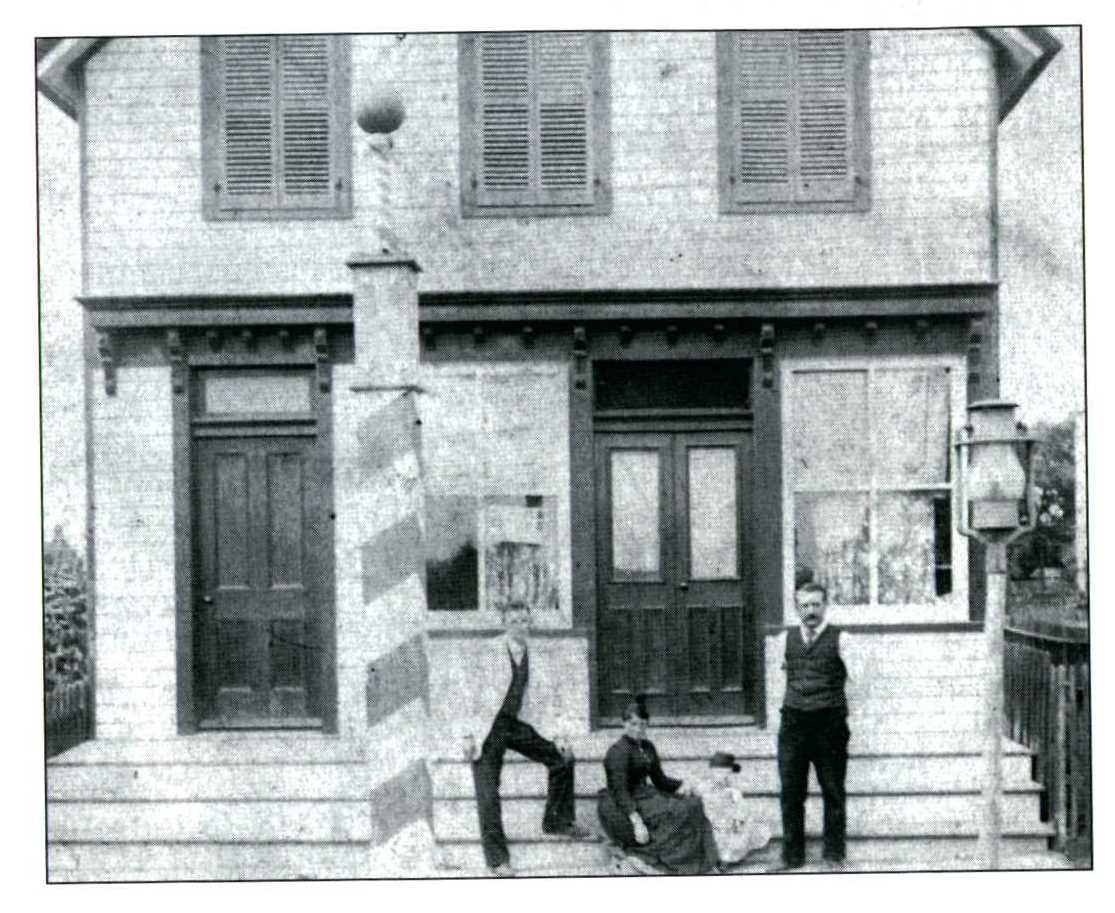
The barbershop of Marcus J. Zeilner, at the northeast corner of School Street & West Hoffman Ave., is pictured around 1890. His wife, Caroline, operated a candy shop next door. In 1962, long after the shop's closing, resident Emily Hirsch recalled, "The children used to sing a rhyme about shaving a pig when they passed Zeilner's Barber Shop. He used to get very angry & come out to scold them & chase them away.
Bendheim Cigar Factory
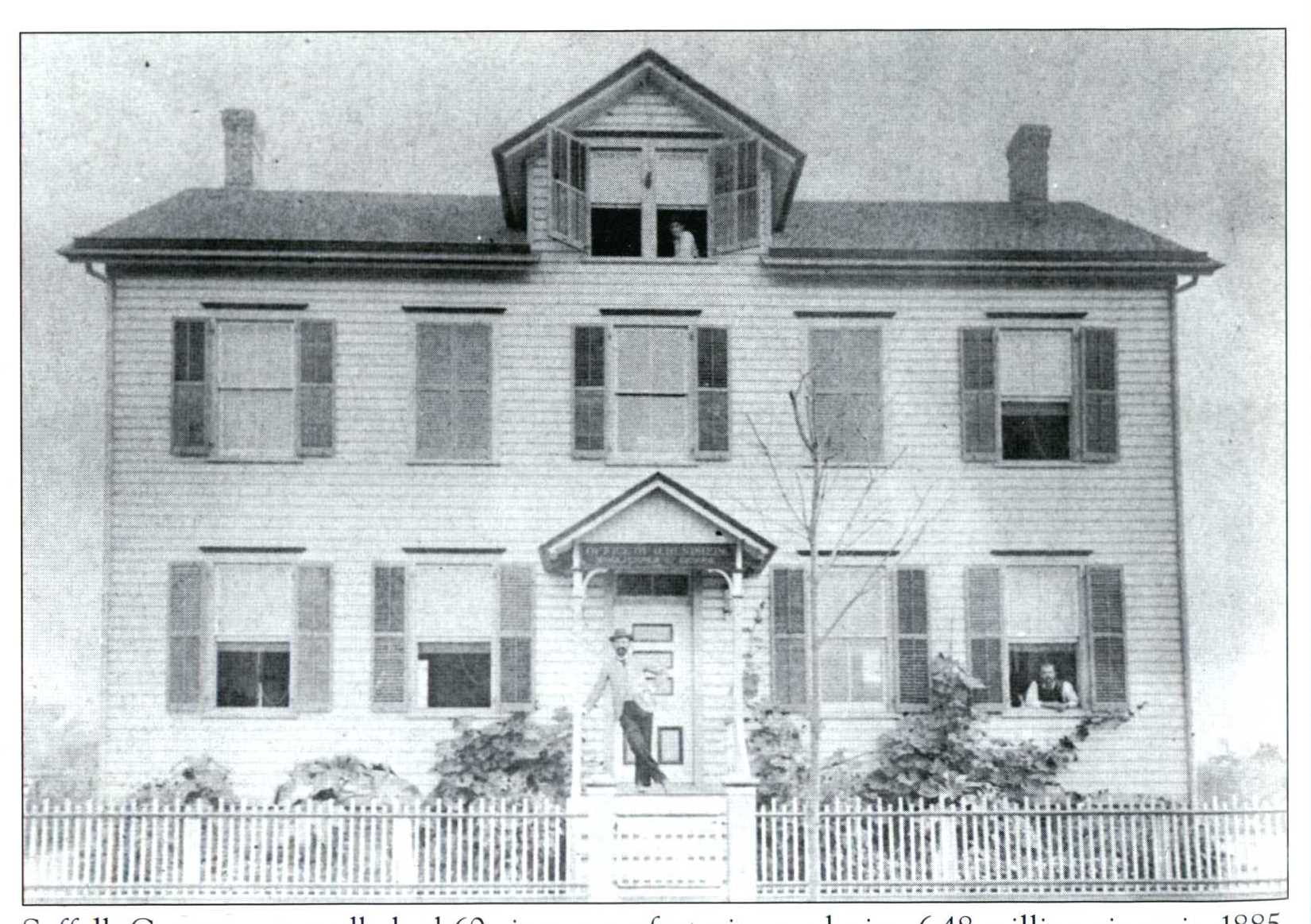
Suffolk County reportedly had 60 cigar manufactories producing 6.48 million cigars in 1885. 20 of those businesses were in Breslau, 6 of which made over 120,000 cigars. In 1886, the top Breslau manufacturer was David Bendheim, with 759,950 cigars. The building was later used by the Catholic church as a school. Several ladies mastered the trade as well. Christina Gries learned to make cigars at the age of 12 in New York City, where she worked until she married Max Gnilka & they moved to Breslau. Christina worked for a few local manufacturers before establishing her own business from her home. She had tobacco shipped from Connecticut & manufactured her brands Wy-not & El Triumpho.
Kaune Blacksmith Shop.
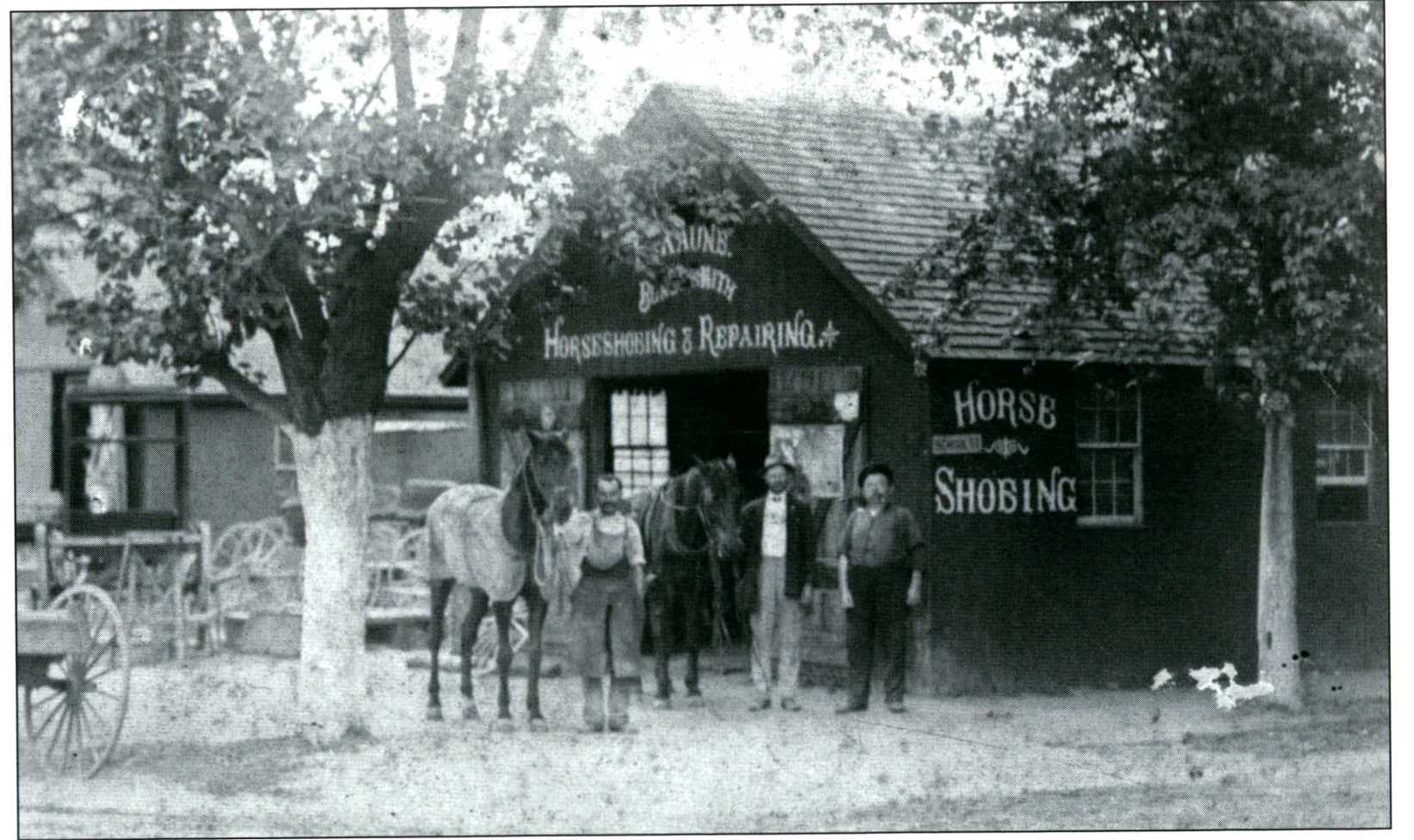
The blacksmith shop of Ernest Kaune, pictured in 1910, stood next to the wheelwright shop of Frederick Minneker at the northwest corner of School St & W. Hoffman Ave. An important tradesman in 19th-century communities, a blacksmith made more than just horseshoes. From iron & steel, he fashioned metal fittings for carriages & sleds, along with nails & tools, including plows, shovels & pitchforks, needed by local farmers. Around 1918, Kaune also served as a watchman at the Wellwood Ave. railroad crossing; the trains ran at ground level, & crossing signals were manually operated.
Minneker Wheelwright Shop

The wheelwright shop of Frederick Minneker, next to Ernest Kaune's blacksmith shop at the northwest corner of School St. & W. Hoffman Ave., pictured in 1910. As their name suggests, wheelwrights built wheels for carts & wagons, but they also made wheels for steam-powered, belt-driven machinery. These skilled craftspeople were eventually phased out by assembly line manufacturing & the increasing popularity of automobiles.
Boeckh Harness & Upholstery Shop
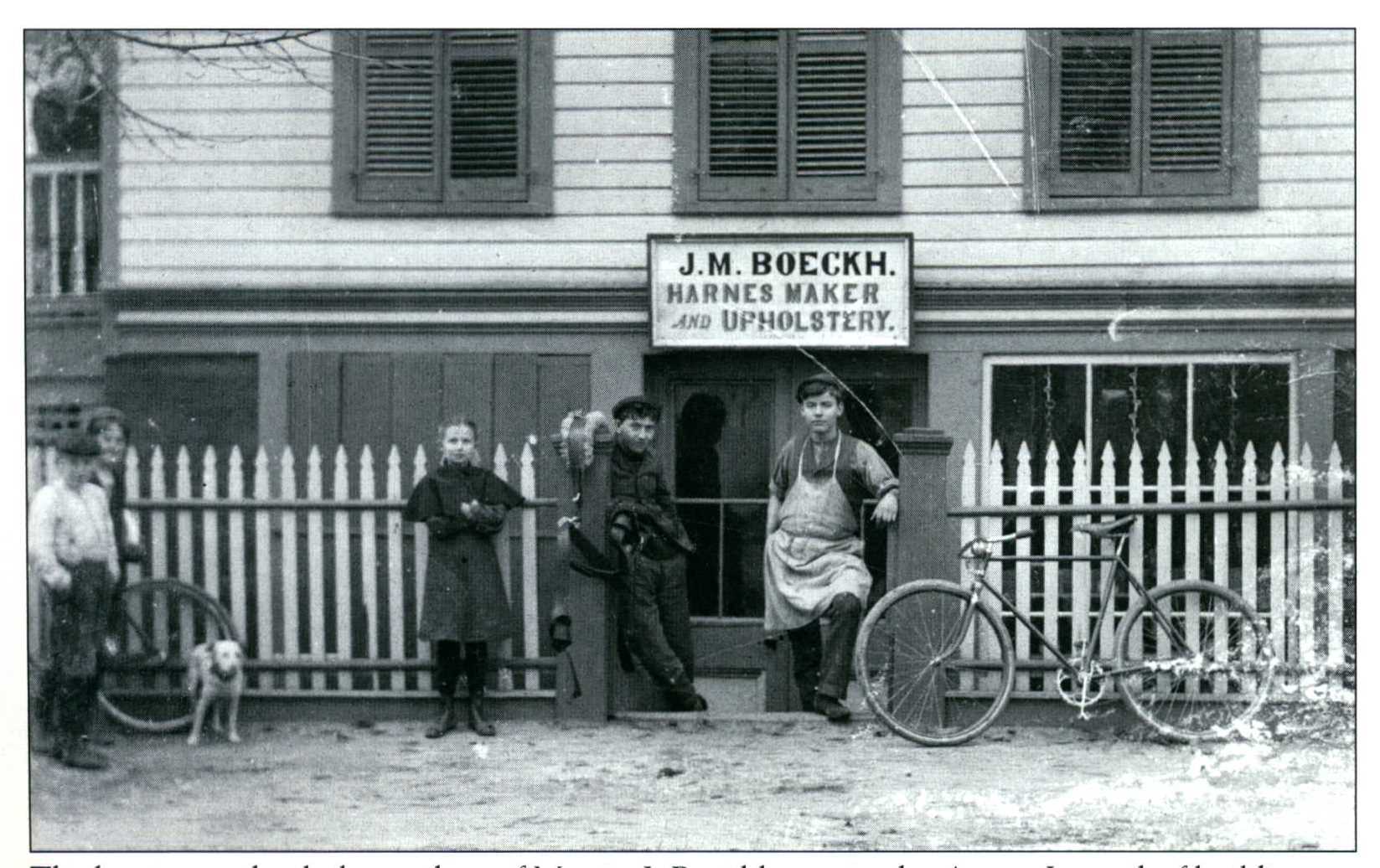
The harness & upholstery shop of Martin J. Boeckh was in the Anton Langsdorf building on North Wellwood Ave. Boeckh emigrated from Germany as a young boy, moved to Lindenhurst 1t 18 around 1904, & married Johanna Tanner, a Swiss immigrant whose father, John Tanner, worked in silk embroidery. The Boeckhs operated an embroidery factory for several years until Martin's untimely death at 33 from pneumonia.
Bohne Bicycle & Auto Garage
Bologna John's Restaurant

German native & butcher John Benkert moved to Lindenhurst in 1923. Stepson Paul Benkert recalled, "The people would ask for bologna sandwiches, instead my father would take a plate & put all sorts of bologna, bread & pickles on it & served it that way - that is how the people named the place Bologna John's. During prohibition, Bologna John's was a popular speakeasy. Similar to other Long Island establishments, Bologna John's was periodically raided by federal agents. In a 1931 bust, the bartender was held on $2000 bail & charged with sale & possession of liquor, & agents "seized 80 half-barrels of alleged beer....four of the barrels were on tap, 36 on ice & 40 stored in another building", as reported by the Brooklyn Daily Eagle. After John's death in 1932, his widow, Anna, & sons Paul & John continued the restaurant, which stood at 38th St. & DeKalb Ave. until it burned in 1956.
Butcher Fred Torns, Jr.
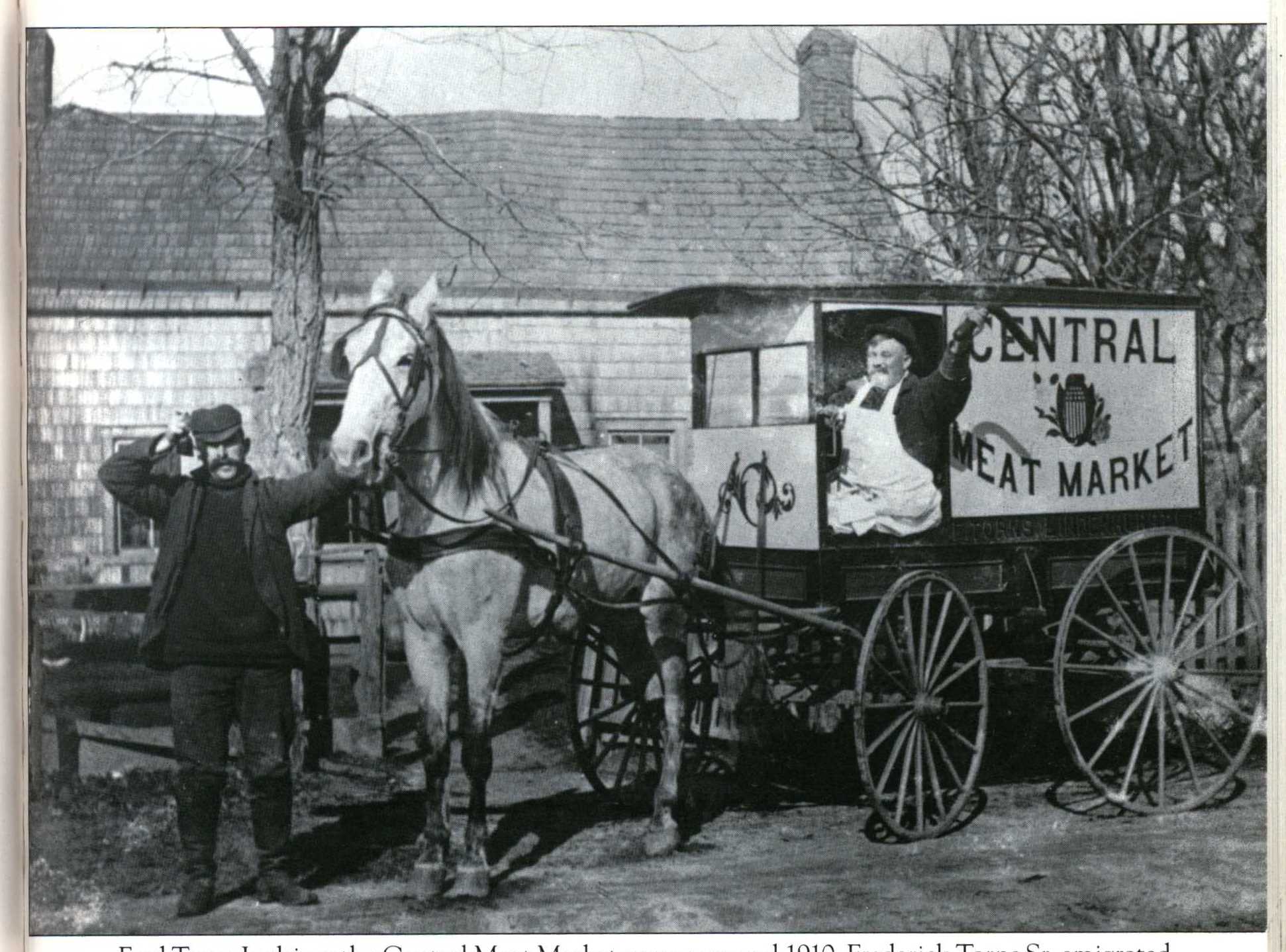
Fred Torns, Jr. drives the Central Meat Market wagon around 1910. Frederick Torns Sr. emigrated from Germany around 1862 & later settled in Breslau, opening a butcher shop in 1873. Torns had learned the butchering trade in his fatherland, where his father practiced the same avocation. The Signal frequently bestowed praise on Fred Torns, noting in 1883 that "the butcher had provided amply for the holiday trade. Torns knows the wants of our people." A decade later, the paper wrote, "Mr Torns is one of the best-known businessmen in the place, & one of the most successful. If you are not acquainted with him in a business way, call at his market & purchase from his stock, & you will not fail to be pleased. If you have stock of any kind for sale, you will find a purchased in him." Fred Torns Sr. operated his Central Market for over 30 years. When he retired in 1905, Fred Jr. continued the Wellwood Ave. business.
Butcher Valentine Goebel

Butcher Valentine Goebel, pictured on the left with Ed Gleste, opened his meat market in 1907. After he leased Kruger's icehouse in 1911, the Signal reported that Goebel "was fortunate in filling it the past week with ice from 5 to 7 inches in thickness." While ice was good for food storage, it was dangerous for driving, as the paper reported: "A horse driven by Jake Boehl on Butcher Goebel's wagon fell on the icy road while turning the corner at South 8th St. It was thought at 1st the horse was badly hurt. The wagon was slightly damaged." Goebel's Wellwood Ave. shop succumbed to the 1914 fire that destroyed the Gleste & Kienle homes, although he was reportedly able to save meat from the refrigerator. He reopened the shop but gave up the business in 1915.
Schneider Carriage Factory
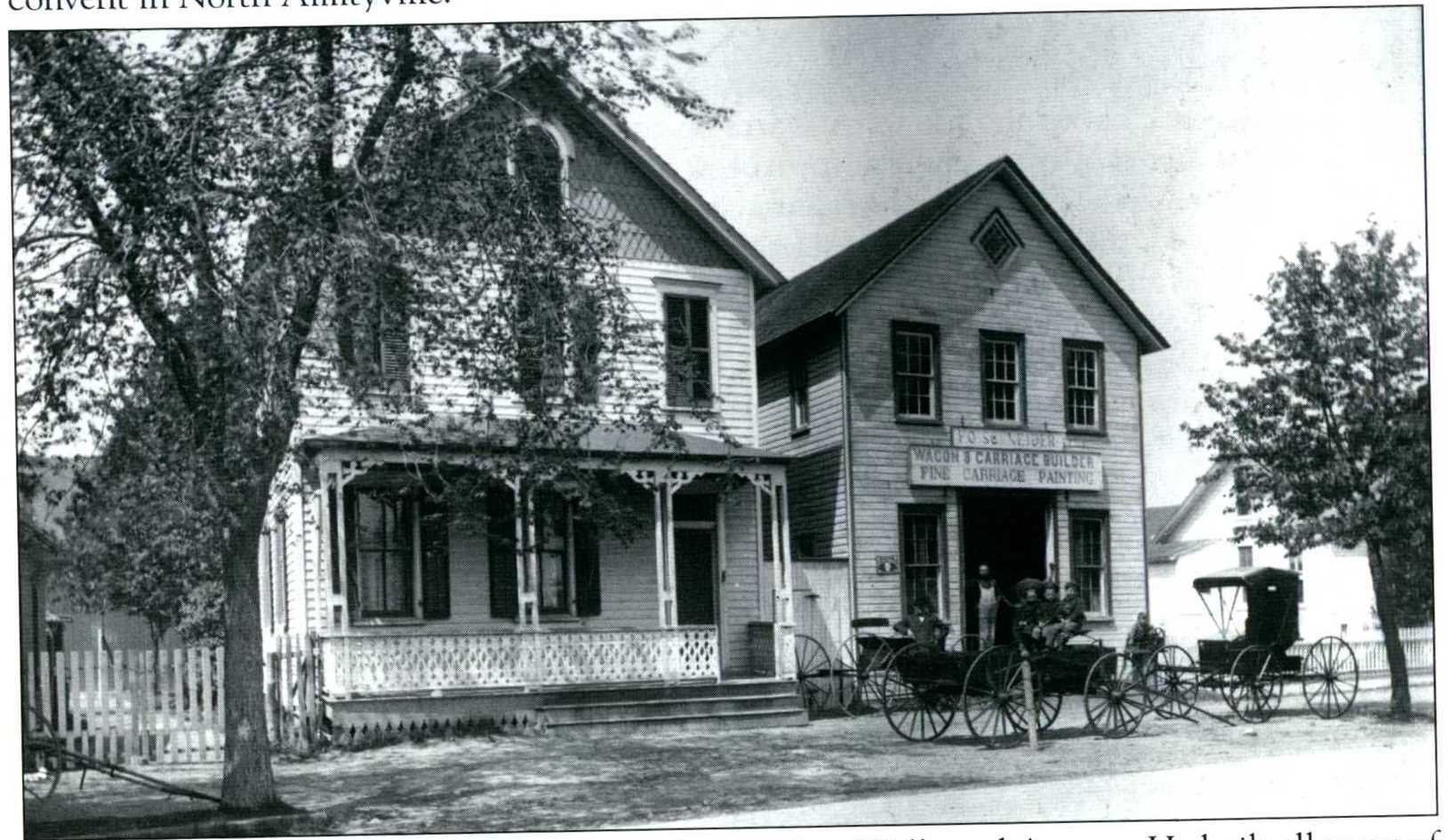
The carriage factory of Frederick O. Schneider stood on Wellwood Ave. He built all types of wagons 7 carriages for residents & businesses. In 1901, the Signal reported construction of a substantial delivery wagon for the Sheide Bottling Co.: "It is to be a covered vehicle, intended to be drawn by 2 horses, & will be like all the output of Mr. Schneider's factory - 1st class." Schneider was also a popular local musician.
Weierter Embroidery Shop
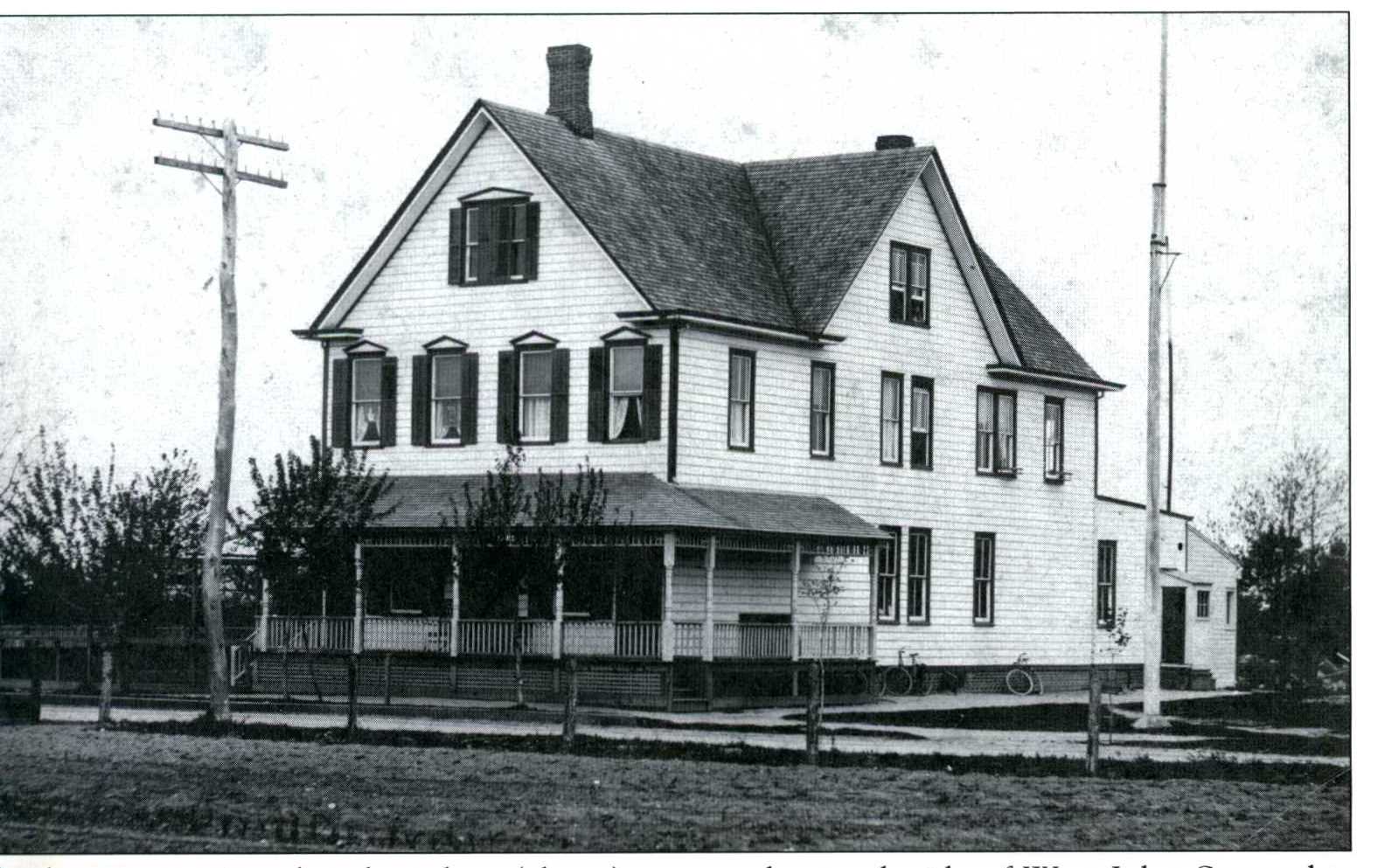
Charles Weierter's embroidery shop was on the north side of West John St. The shop was among those profiled in the Brooklyn Daily Eagle's 1903 summary of Lindenhurst manufacturing businesses, "Manufacturing Plants May Aid Village Growth - They Need Not Necessarily Prove Unsightly of Interfere with Other Interests." Weierter stated that he learned the trade from a friend of his father, & employed about 35 people during the busy sample season. Embroidery work was described as "clean" & well-paying.
Weierter Embroidery Shop employees
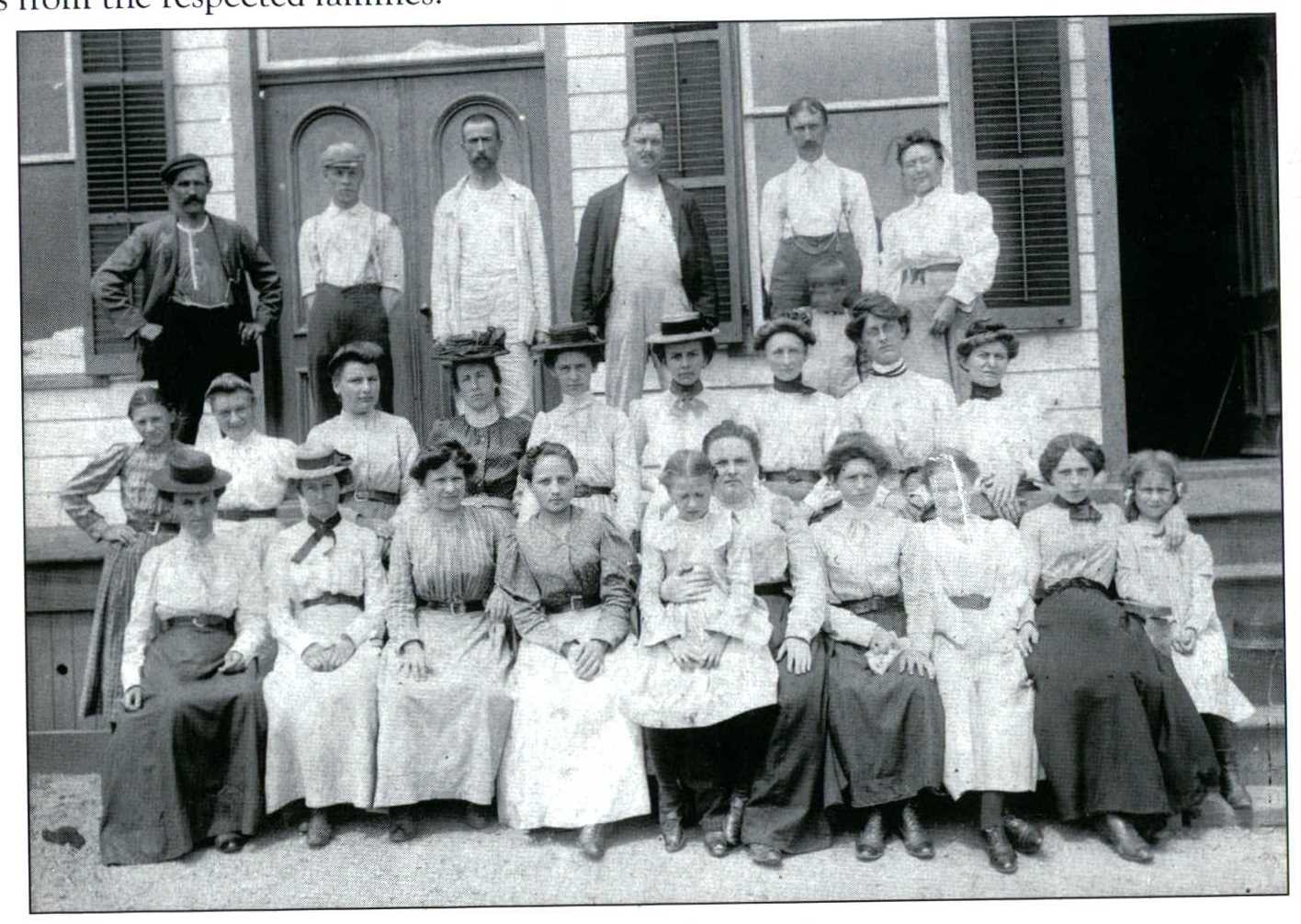
The workers of the Weierter embroidery shop in front of the shop around 1905. Skilled stitchers earned $15 to $20 weekly, while less skilled girls earned about $5. Emphasizing the wholesomeness of the local industry, readers were assured, "all the factories for embroidering are located in substantial home-like buildings and the help comes from the respected families."
Weierter Embroidery Shop interior
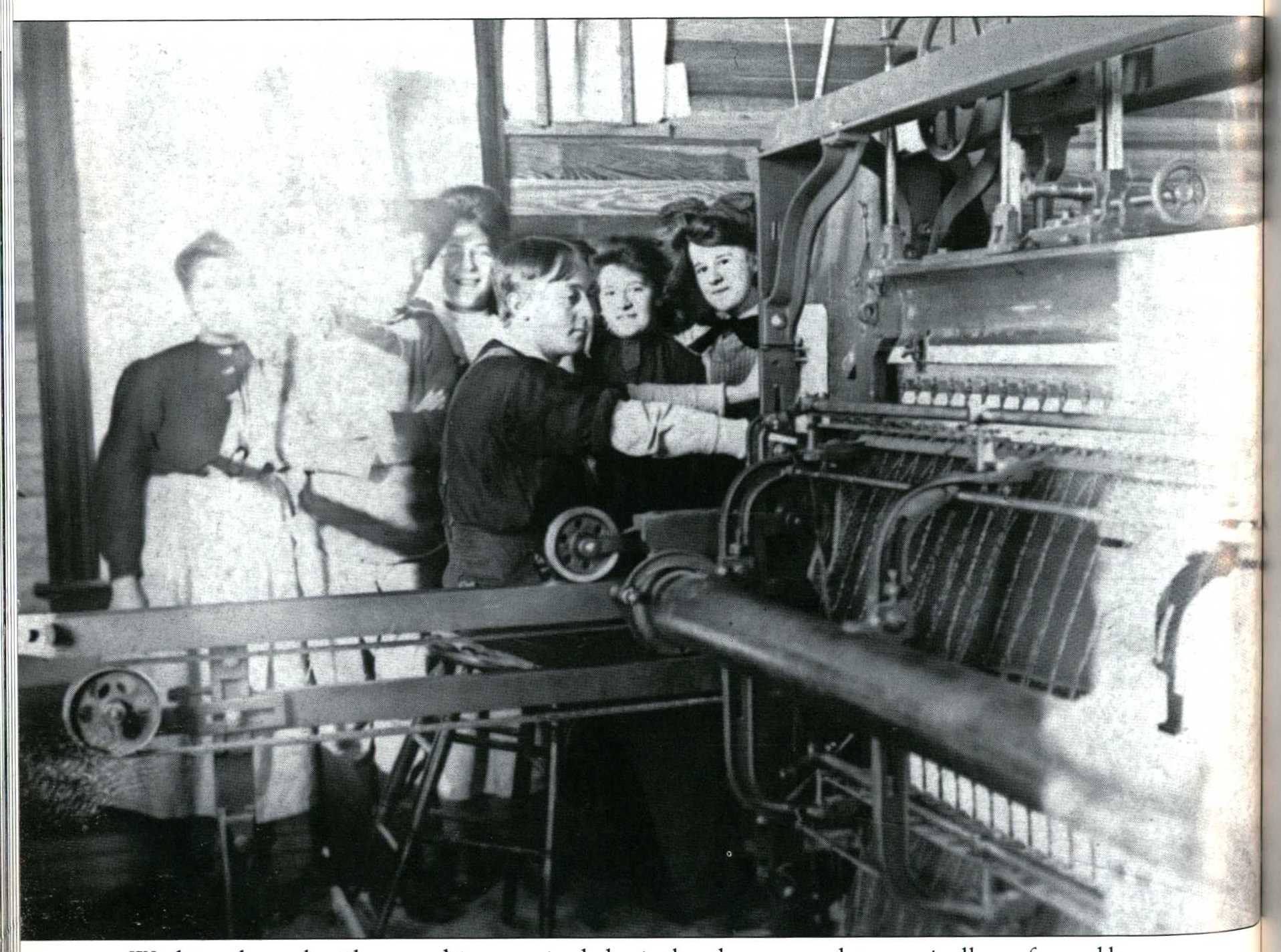
Working the embroidery machine required physical endurance & was typically performed by men. The Eagle described the work: "The operator sits at one end of the machine on a stool, leaning slightly forward. There are 2 foot treadles (levers), one for each set of needles on the machine. Before him is the pattern to be worked, an initial or border. The operator or stitcher uses a tracing needle with his left hand while his right has to grip the crank connected with the set of cogs, governing the needle & thread carriage. Thus, in operating the machine, the stitcher has his hands & feet employed, his eyes & brain. He must watch the tracing of the pattern, release the needle carriage at the proper time, see that too much tension is not given the stitching & observe that no threads break. The pattern placed before the stitcher is 6 times larger than when worked, being reduced from the tracer by a pantograph. In border work, a variety of colored silk or just plain white can be used....Some patterns require an extra day to work."
Leemann Embroidery Shop interior, 1915
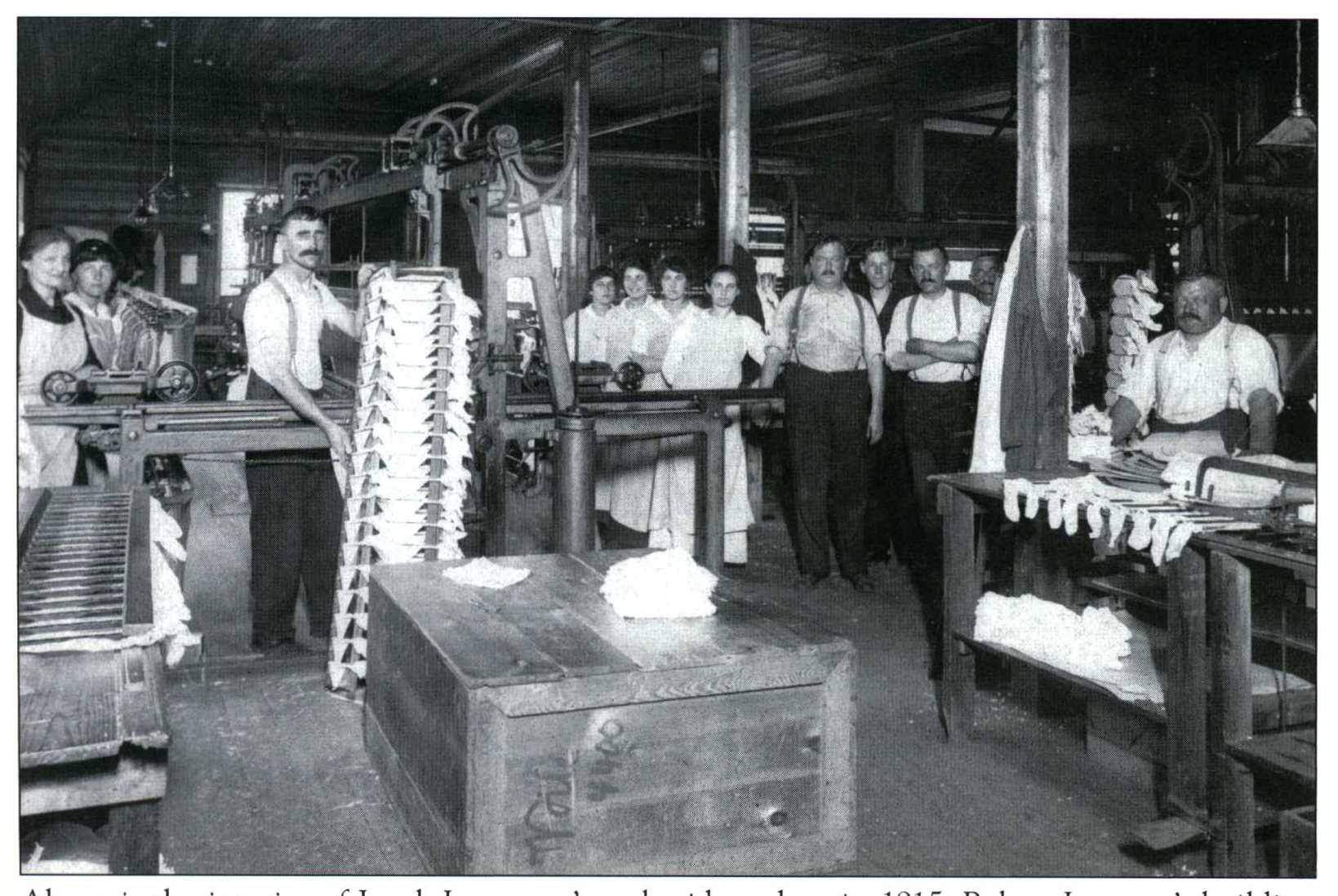
The interior of Jacob Leemann's embroidery shop in 1915. In 1912, New York amended the labor law, limiting women & minors to a 9-hour work day & 54 hours per week. The new work hours caused tension in some stitching shops. About 20 young women went on strike. They asserted that they had completed the same amount of work in 9 hours that they had dome in the old 10-hour days, & they wanted to compensated at the rate of a 10-hour work shift. The workers were losing an hour's pay each day. The strikers lost their fight, returning to work the following week at the lower pay rate.
Vulcanite Factory (Breslau Manufacturing Company)
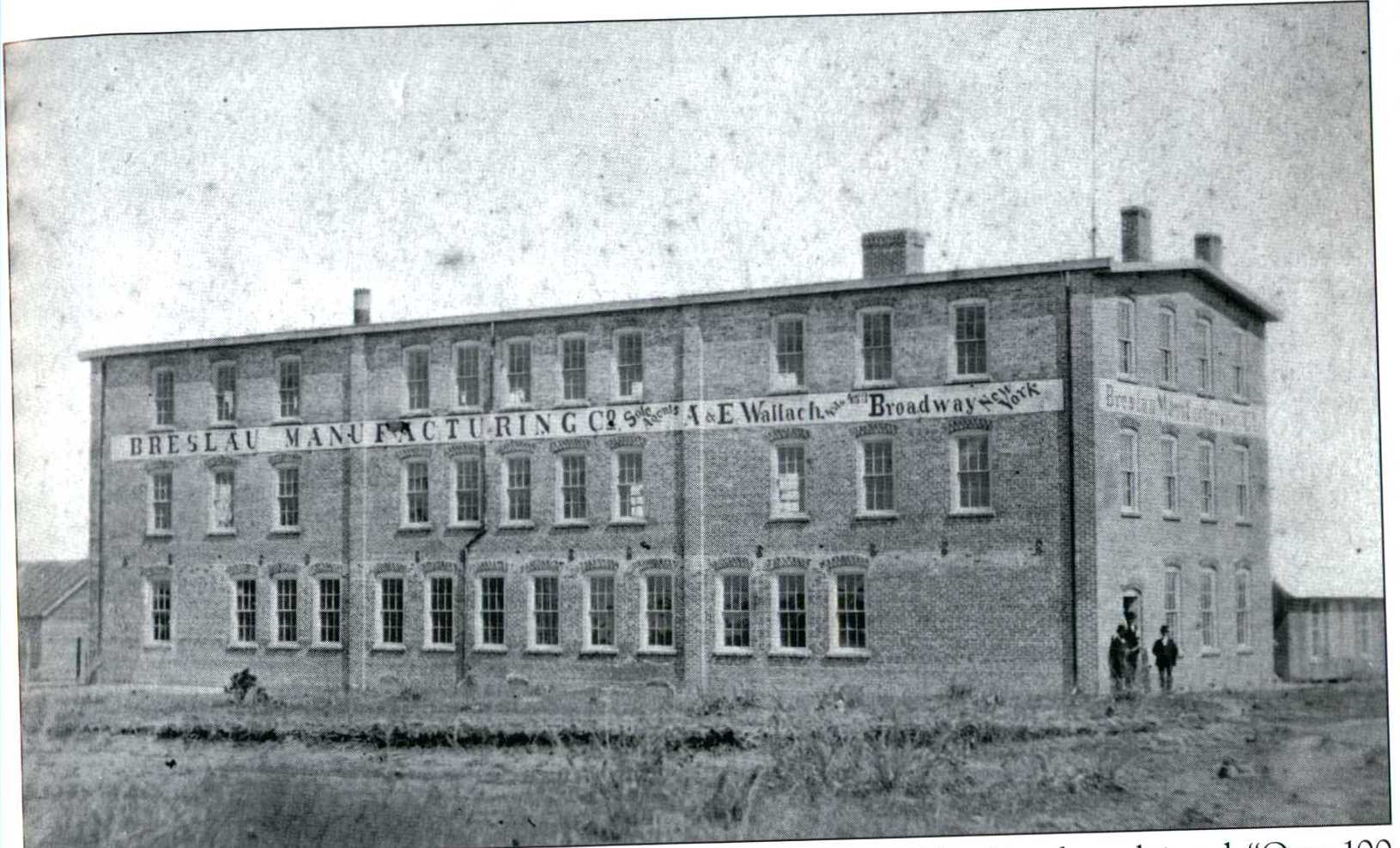
The Breslau Manufacturing Company opened on July 29, 1872. The Signal proclaimed, "over 100 different articles are manufactured from saw dust, by patent process, including picture frames, match boxes, clocks, jewelry & ornaments of different kinds. This will be a great benefit to Breslau, & add materially to the welfare of the place.
Vulcanite Factory add
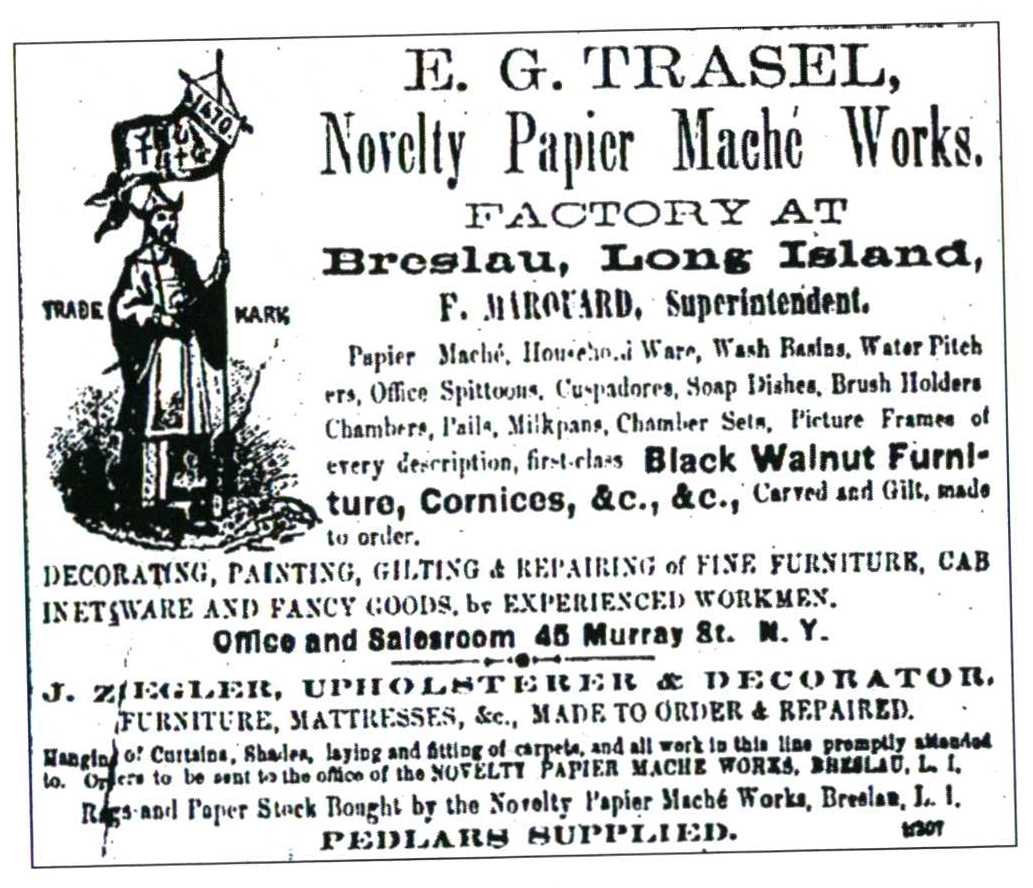
A patent for vulcanized rubber was filed in 1869 by Frank Marquard of Massachusetts. His composition consisted of sawdust, sulphur, starch, color, & water, which was mixed, dried & pulverized. Heated to 300 degrees, the molded compound hardened, or vulcanized. Once lacquered, the material was water resistant & suitable for wash basins, spitoons, pails, & picture frames. The Breslau Manufacturing Company was commonly known as the papier-mache factory of the Novelty Papier Mache Works, as depicted in this 1875 advertisement.
Vulcanite Factory interior
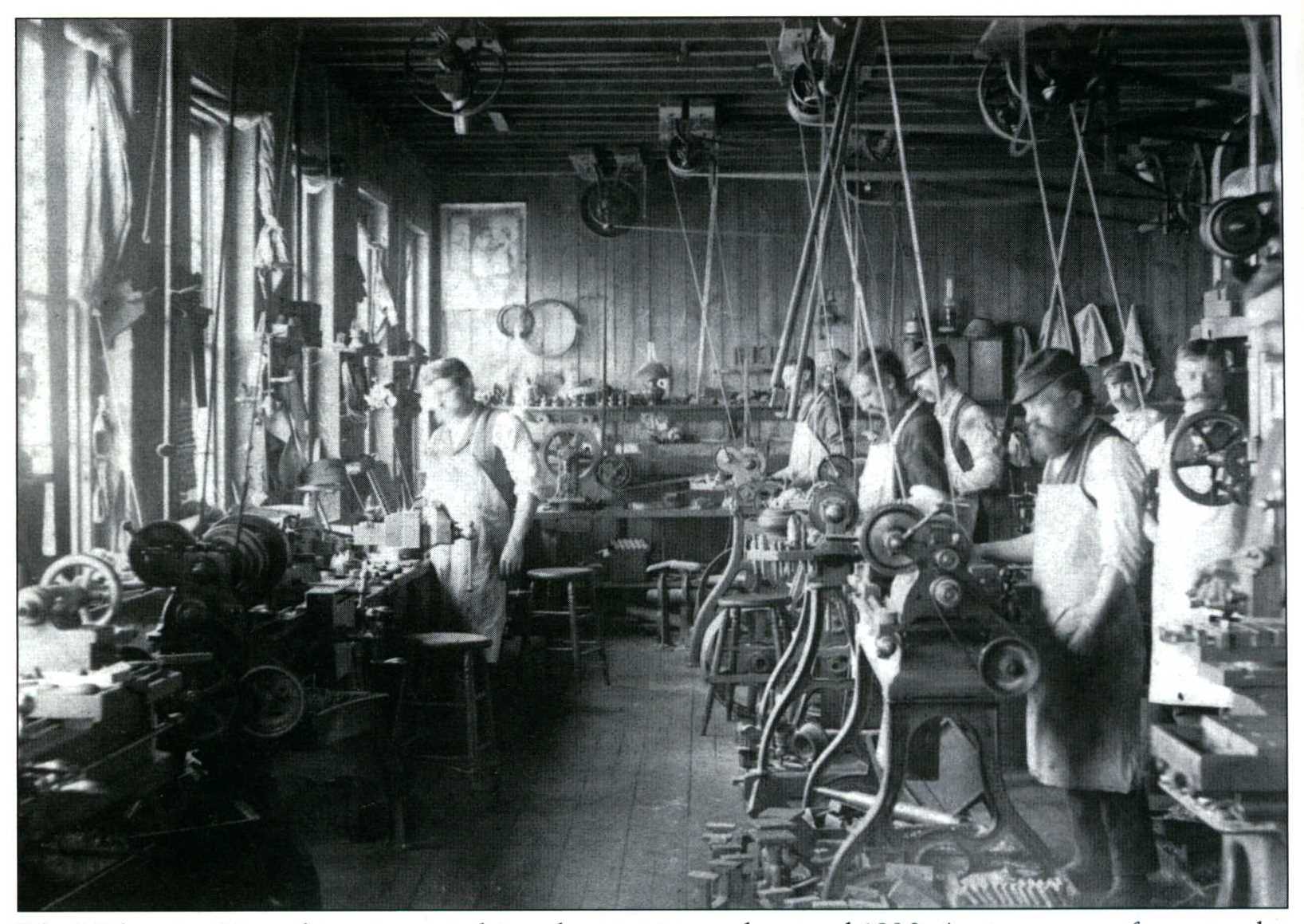
The Vulcanite Manufacturing machine shop is pictured around 1890. An important factor in the development of Breslau was the creation of local jobs. Encouraging business growth, community developers offered free land to businesses that agreed to build or relocate operations in Breslau. In 1880, the Vulcanized Horn & Rubber Button Manufacturing Company of Massachusetts acquired the papier-mache factory & moced its operations to the Breslau factory, employing 200 boys, girls, men & women.
Vulcanite Factory sewing room
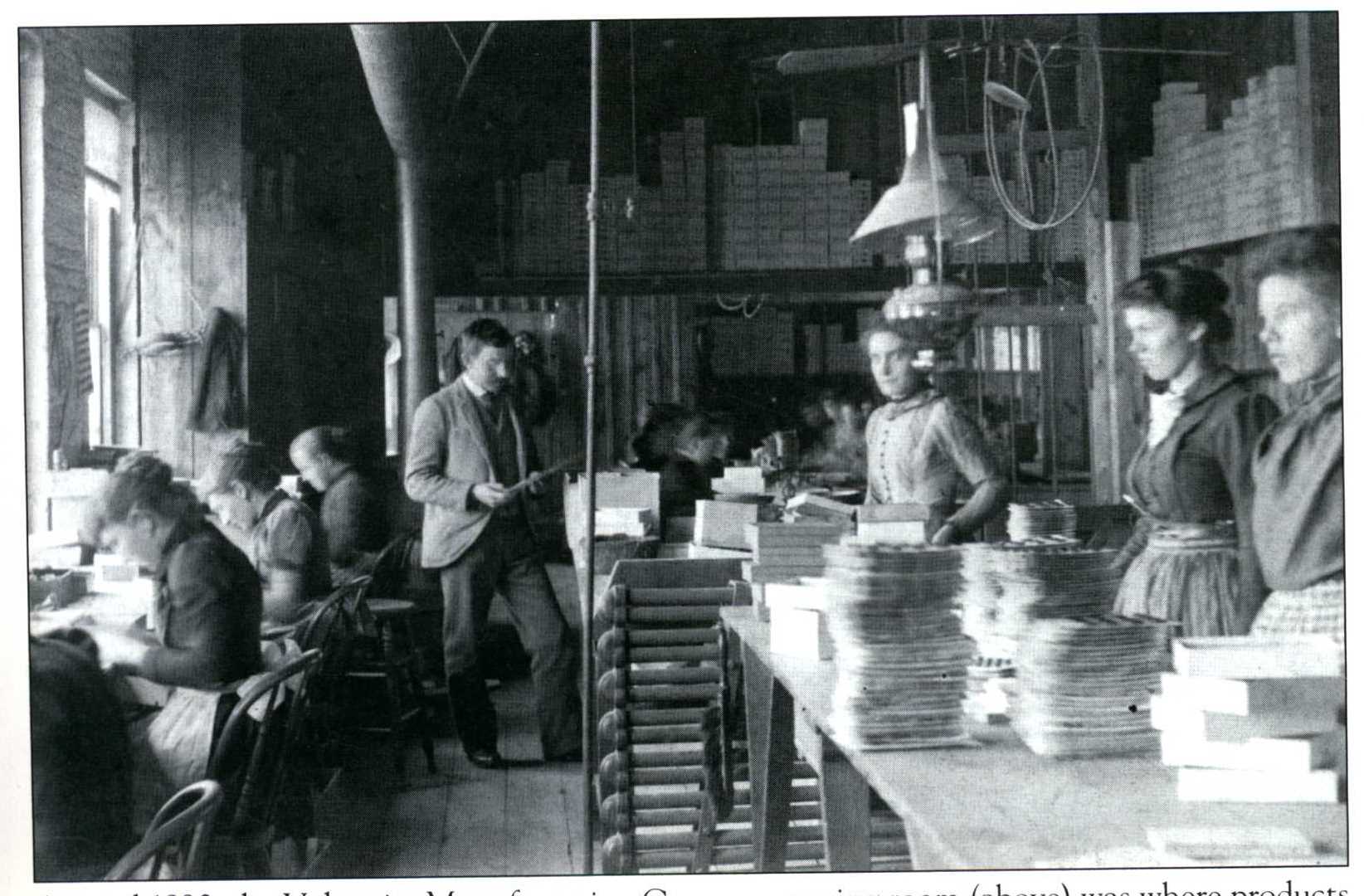
Pictured around 1890, the Vulcanite Manufacturing Company sewing room was where products were sewn onto display cards. Accompanying the factory's settlement in Breslau, a Massachusetts merchant, Wilbur C. Abbot, relocated his family to Breslau & was appointed superintendent of the Vulcanite factory. Active in community & business affairs in Babylon & Lindenhurst, Abbot held the position of superintendent until his retirement in 1936.
Vulcanite factory box shop
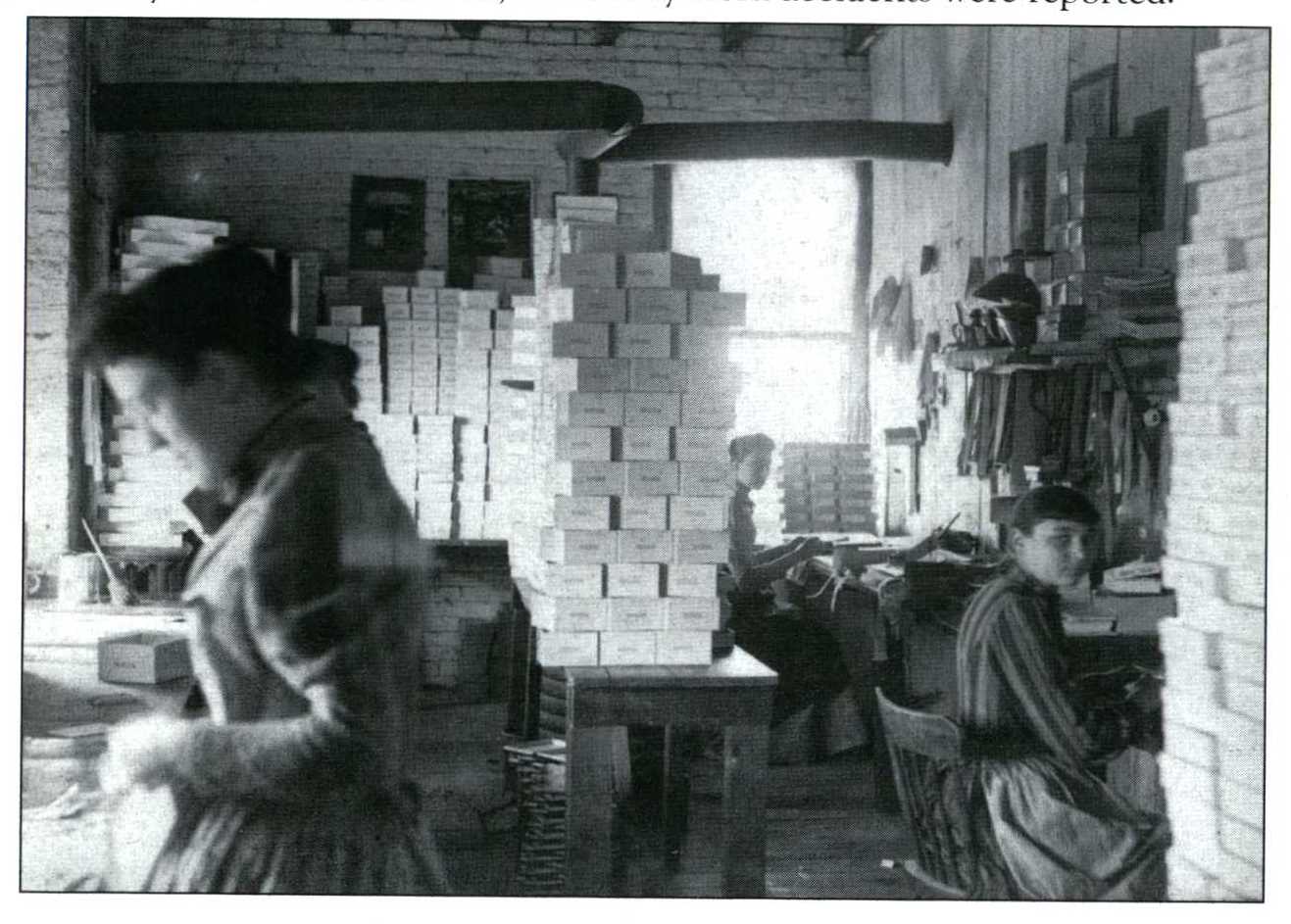
The Vulcanite Manufacturing Company box shop was where finished items were packed for sale & shipment. In addition to producing a variety of buttons & sewing notions, the factory began fabricating electric insulators for the Edison Electric Light Company in 1888. The factory itself was not equipped with electric lights until the end of 1892, when the Signal proclaimed that the factory "presents a brilliant appearance, after nightfall." Factory work was hazardous, & many work accidents were reported.
Vulcanite factory 1895 fire

On Sunday, June 2, 1895, the day before the community was poised to celebrate Pfingst Monday & the 25th anniversary of Breslau, the Vulcanite factory was completely destroyed by a fire that originated in the drying room around 11:30 a.m. A telegram wired to Babylon brought reinforcements by noon, & 200 firemen battled the blaze, which rendered hundreds of residents unemployed.
Vulcanite factory 1895 fire
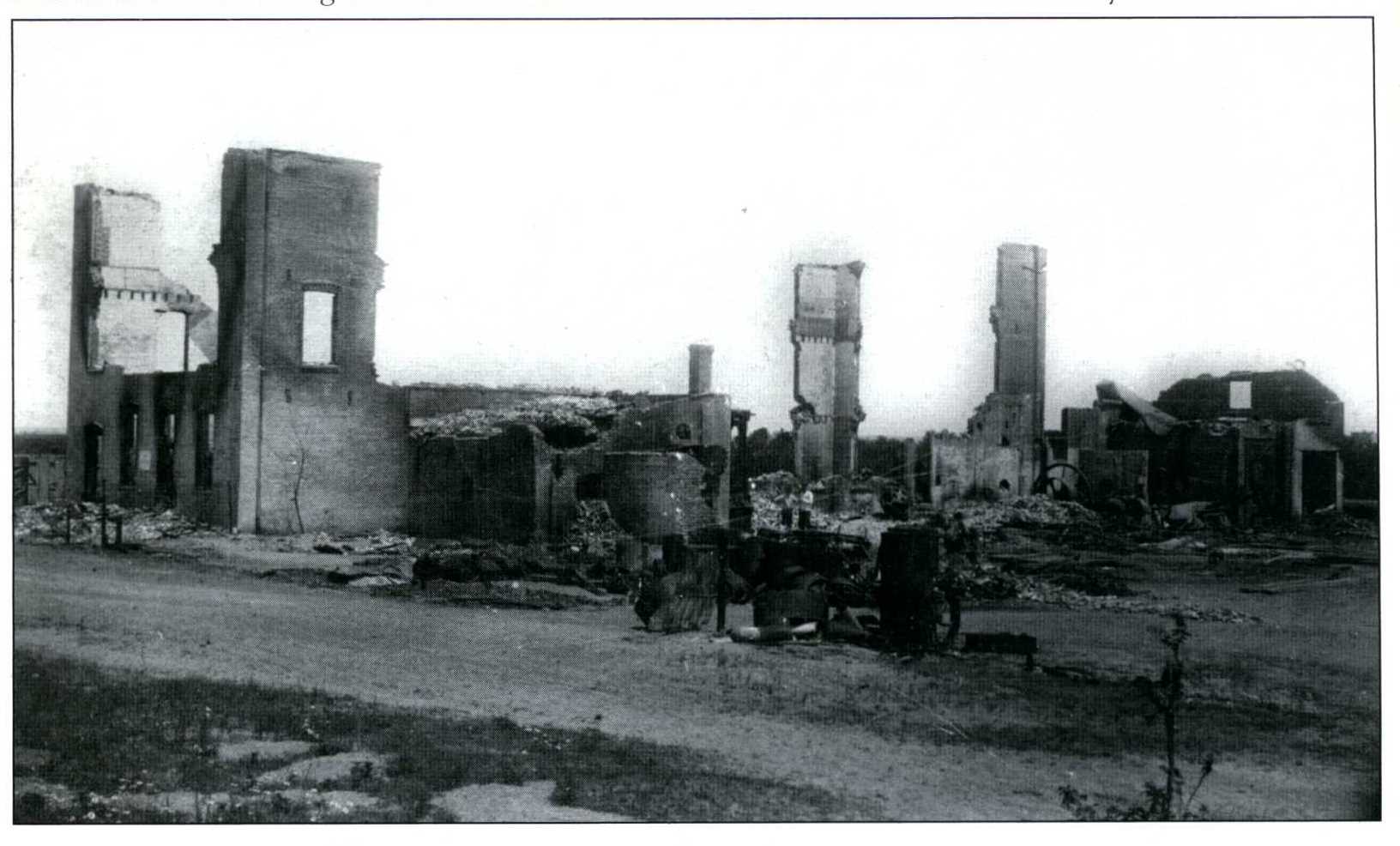
The Brooklyn Daily Eagle recalled, "The whole interior of the structure was soon a mass of roaring flame fed by the highly inflammable material used in the manufacture of the goods turned out by the company. As the floors gave way section by section the heavy machines fell through the cellar with a crash. Everything capable of being burned was destroyed in about 4 hours....nothing left but a few sections of brick wall & 3 chimneys.
Rebuilt Vulcanite factory, 1895
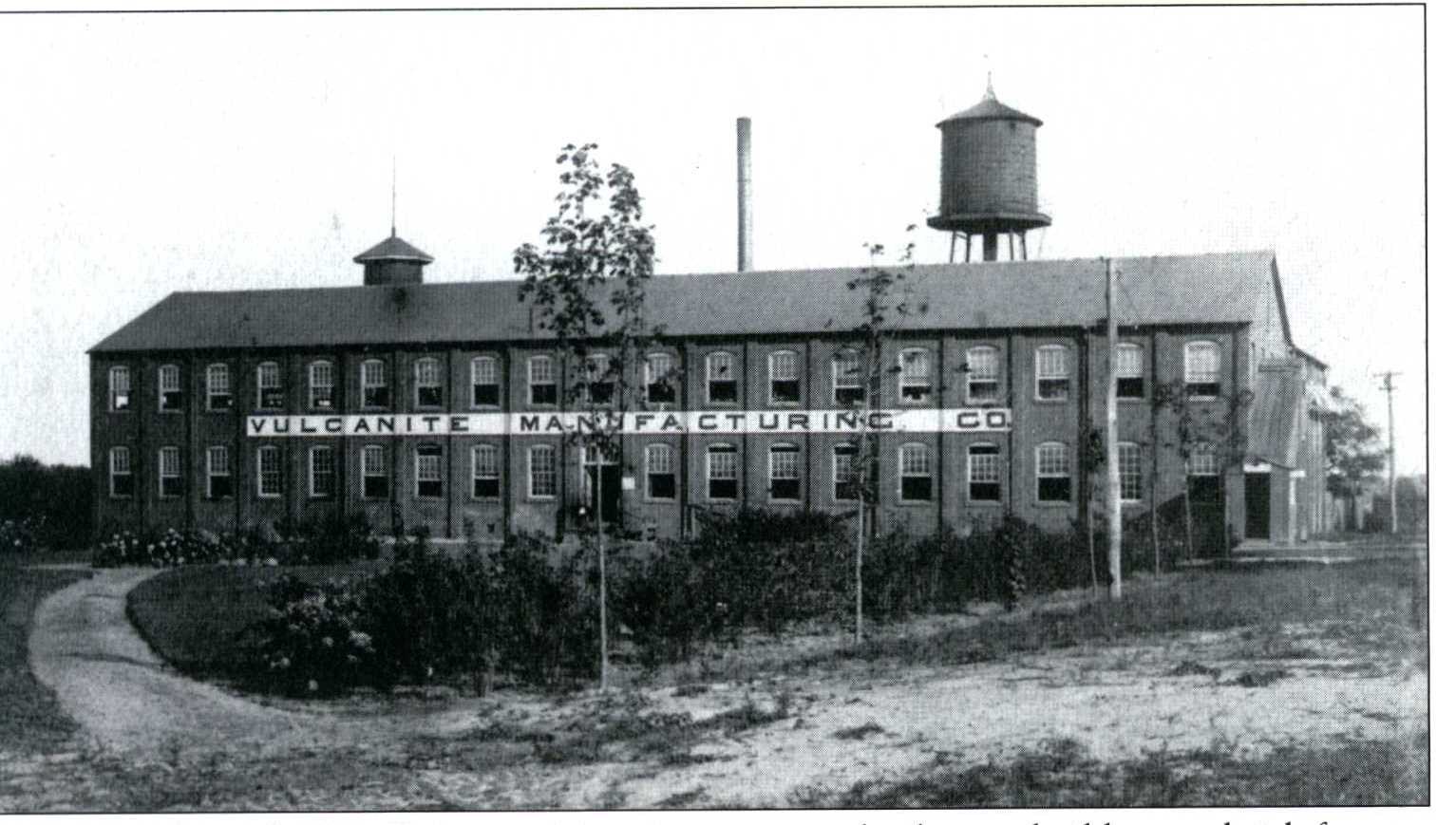
Within 2 weeks of the fire, Vulcanite Manufacturing made plans to build a new brick factory, "nearly fireproof as possible", according to the South Side Signal. Some employees took up work at a nearby factory, while others worked to clear the site. The Signal reported that the new factory was "equipped with all modern appliances for convenience & economy, including electrical power, electric lights, hydraulic elevators, heating by exhaust steam from the engine & pumps, fire proof vaults for dies & tools (which) will enable them to fill their orders more promptly & satisfactorily than before". In 1870, Charles Hirsch Sr. blew the 1st whistle for the Breslau Manufacturing Company; 25 years later, his son Charles Jr. blew the 1st whistle for the new Vulcanite factory on October 22, 1895.
Button factory employees

Employees of Lindenhurst Manufacturing Company are pictured around 1907. Around 1920, the factory extended employment for work from home. Wooden boxes with 25 to 50 gross of buttons were delivered to home workers, who strung groups of buttons on a pin & rolled them in paper, earning 2 cents per gross. Home workers, mainly women, were also assigned to hand sort buttons, separating defects, odd sizes, & ones to be polished, & could process 14,000 to 20,000 buttons per day. The photo also provides evidence that it was taken before the 1913 child labor laws were passed in New York State.
Liebl Embroidery Shop
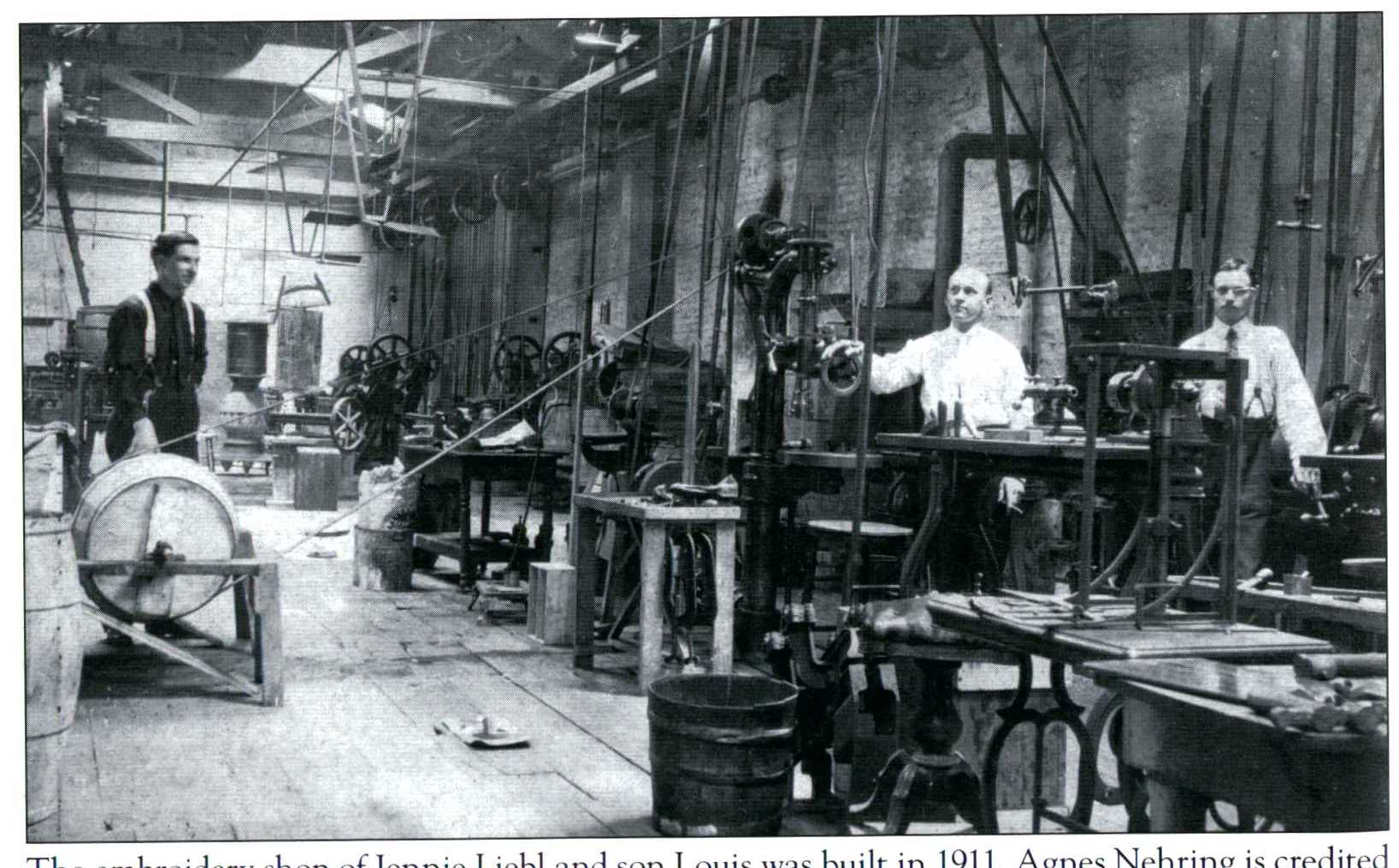
The embroidery shop of Jennie Liebl & son Louis was built in 1911. Agnes Nehring is credited with introducing Swiss embroidery to Lindenhurst. In 1886, she purchased a machine using 208 needles for openwork embroidery & 70 for slipper work. Nehring engaged an experienced machine operator, along with several assistants, to fulfill orders received from New York City shops. A myriad of embroidery shops soon followed, many owned & operated by women.
Tanner embroidery shop employees
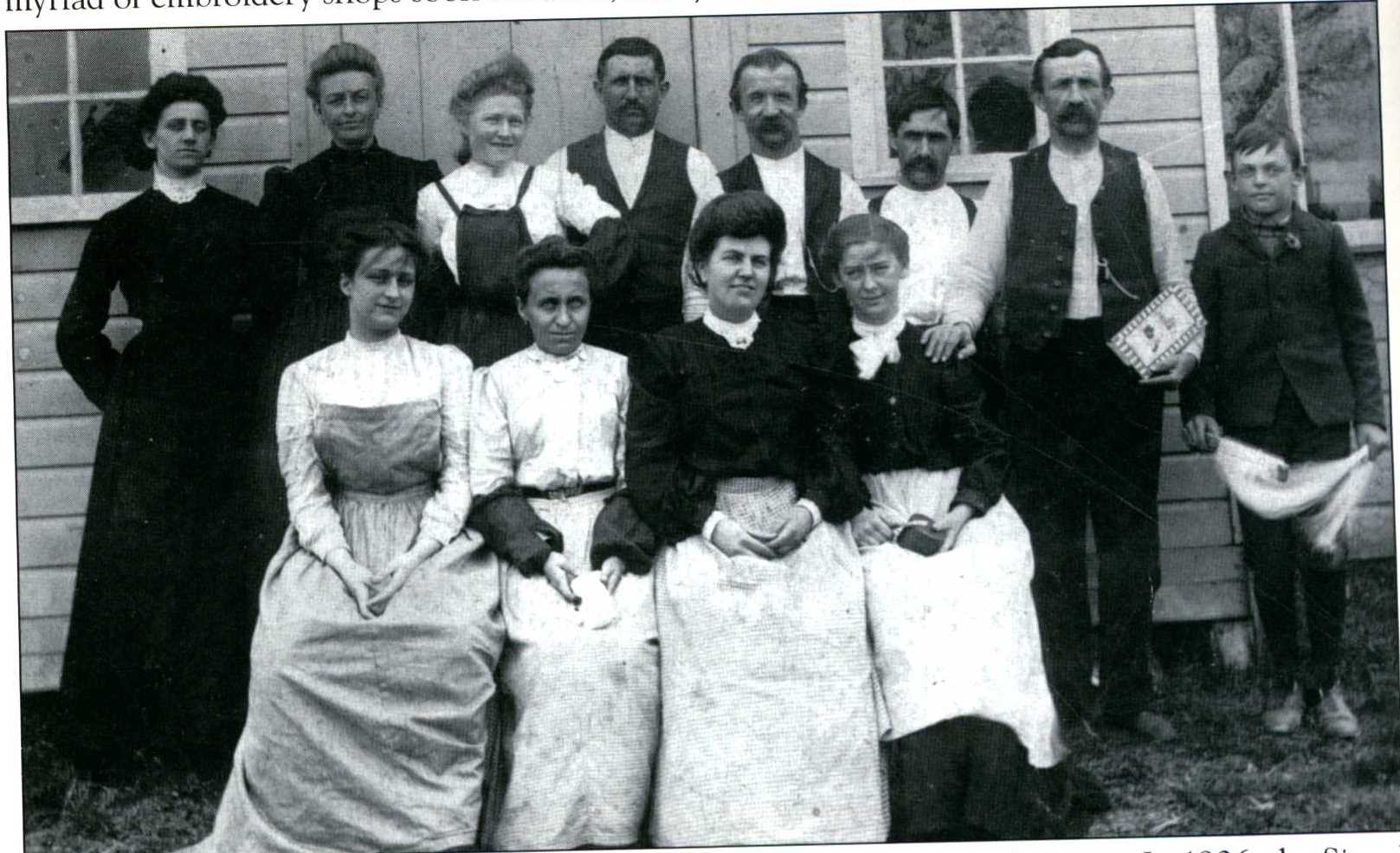
Workers are pictured at John Tanner's embroidery shop on South High Street. In 1906, the South Side Signal described the Swiss native's industriousness: "As an indication of what thrift, industry & frugality will accomplish it is well to recall the fact that Mr. Tanner came here less than a decade ago, worked at his trade in one of the local embroidery works for a year or 2, saved his money, married, purchased a pleasant home & purchased an embroidery machine".
Weierter embroidery shop

Charles Weierter's embroidery shop was on the north side of West John Street. Weierter's shop was among those profiled in the Brooklyn Daily Eagle's 1903 summary of Lindenhurst manufacturing businesses, "Manufacturing Plants May Aid Village Growth - They Need Not Necessarily Prove Unsightly or Interfere with Other Interests." Weierter stated that he learned the trade from a friend of his father, & employed about 35 people during the busy sample season.
Weierter embroidery shop employees

Charles Weierter's embroidery shop employers pictured in front of the shop around 1905. Embroidery work was described by the Brooklyn Daily Eagle as "clean" & well-paying. Skilled stitchers earned $15 to $20 weekly, while less skilled girls earned about $5. Emphasizing the wholesomeness of the local industry, readers were assured, "all the factories for embroidering are located in substantial home-like buildings & the help comes from respected families".
Weierter embroidery shop interior

Working the embroidery machine required physical endurance & was typically performed by men. The Brooklyn Daily Eagle described the work: "The operator sits at one end of the machine on a stool, leaning slightly forward. There are 2 foot treadles (levers), 1 for each set of needles on the machine. Before him is the pattern to be worked, an initial of border. The operator or stitcher used a tracing needle with his left hand while his right hand has to grasp the crank connected with the set of cogs, governing the needle & thread carriage. Thus, in operating the machine, the stitcher has his hands & feet employed, his eyes & brain. He must watch the tracing of the pattern, release the needle carriage at the proper time, see that too much tension is not given the stitching & observe that no threads break. The pattern placed before the stitcher is 6 times larger than when worked, being reduced from the tracer by a pantograph. In border work, a variety of colored silk or just plain white can be used...Some patterns require an entire day to work."
Leemann embroidery shop interior

The interior of Jacob Leemann's embroidery shop in 1915. In 1912, New York amended the labor law, limiting women & minors to s 9-hour work day & 54 hours per week. The new work hours caused tension in some stitching shops. About 20 young women went on strike. They asserted that they had completed the same amount of work in 9 hours that they had done in the old 10-hour days, & they wanted to be compensated at the rate of a 10-hour work shift. The workers were losing an hour's pay each day. The strikers lost their fight, returning to work the following week at the lower pay rate.
Feller brewery
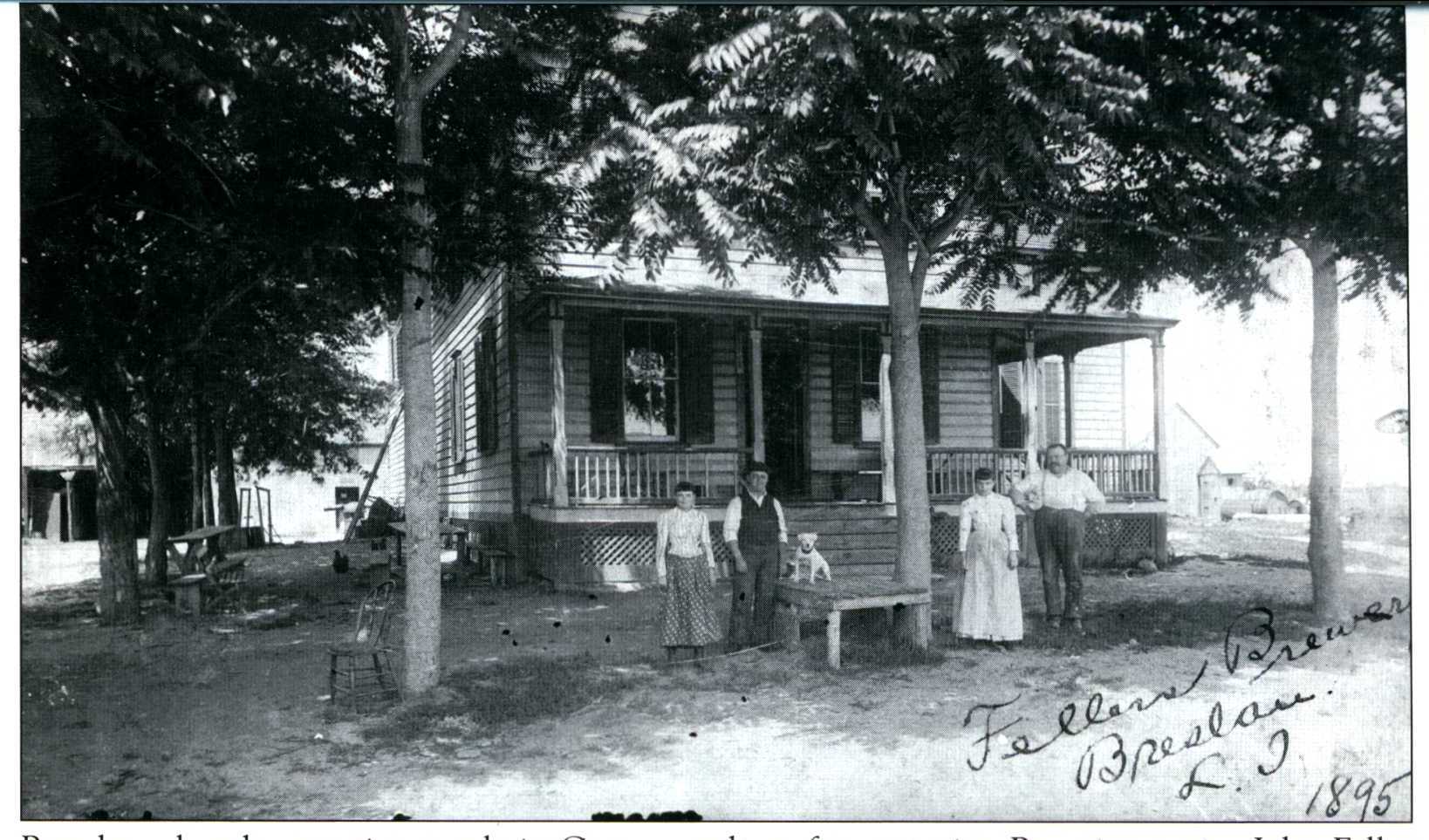
Beer has played a prominent role in German culture for centuries. Bavarian native John Feller was not the 1st Breslau brewer, but became well-known. He is pictured with his family at their East John Street residence in 1895. In 1881, Feller enlarged his establishment, & the South Side Signal proclaimed, "Feller's lager beer has already quite a reputation & his new vaults will enable him to brew an article which even the fastidious will praise.
Feller brewery
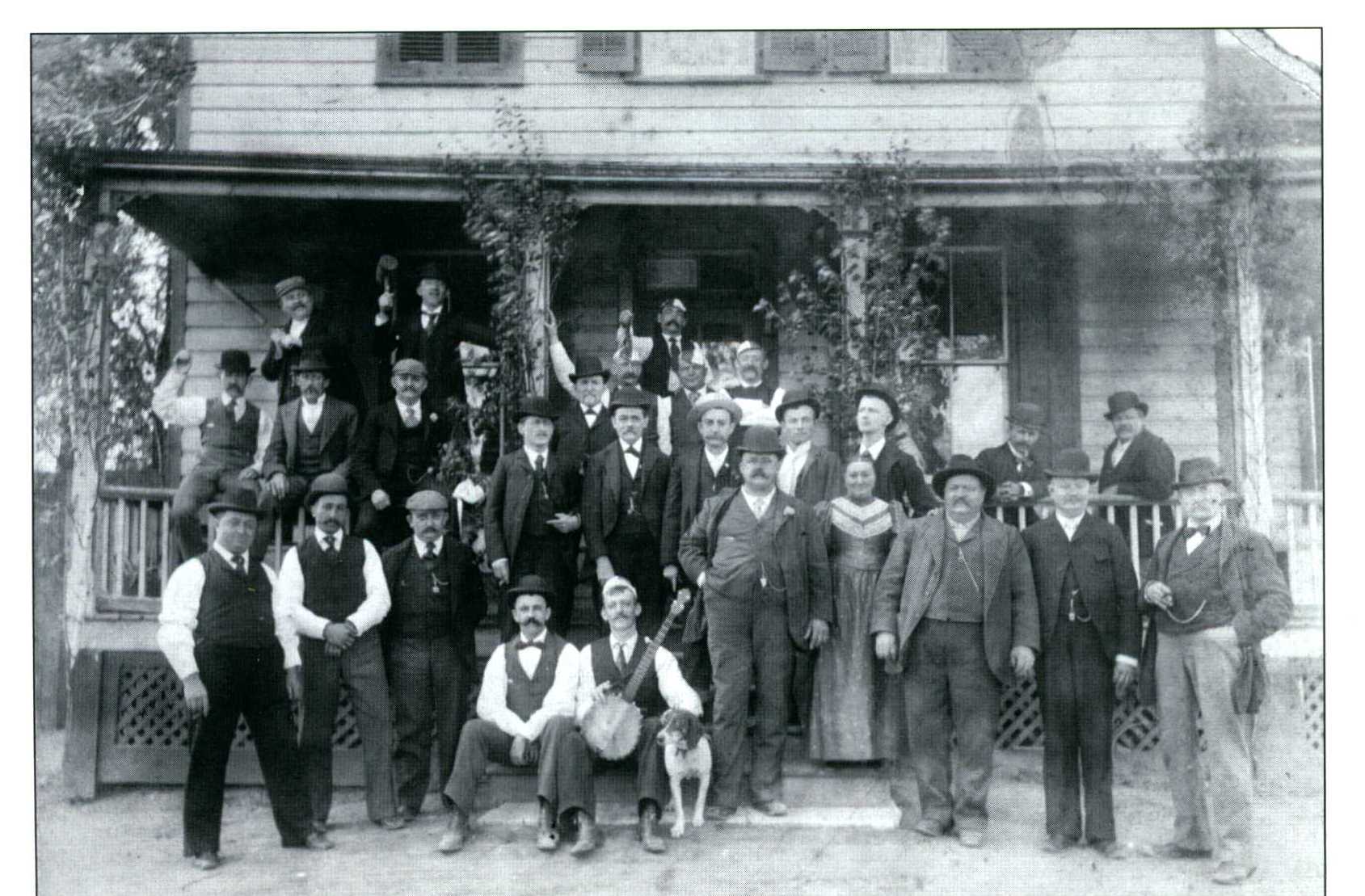
Except for "a few articles of furniture & a small quantity of beer," as reported in the South Side Signal, Feller's original home & brewery was destroyed by fire on June 2, 1883. The foundation for his new residence & brewery started within a few weeks. An 1887 advertisement peddled, "John Feller, Breslau, L.I. - Brewer & Bottler of A 1 Lager Beer - Hotels & families supplied with fresh-bottled lager on Mondays, Wednesdays & Fridays".
Feller icehouse
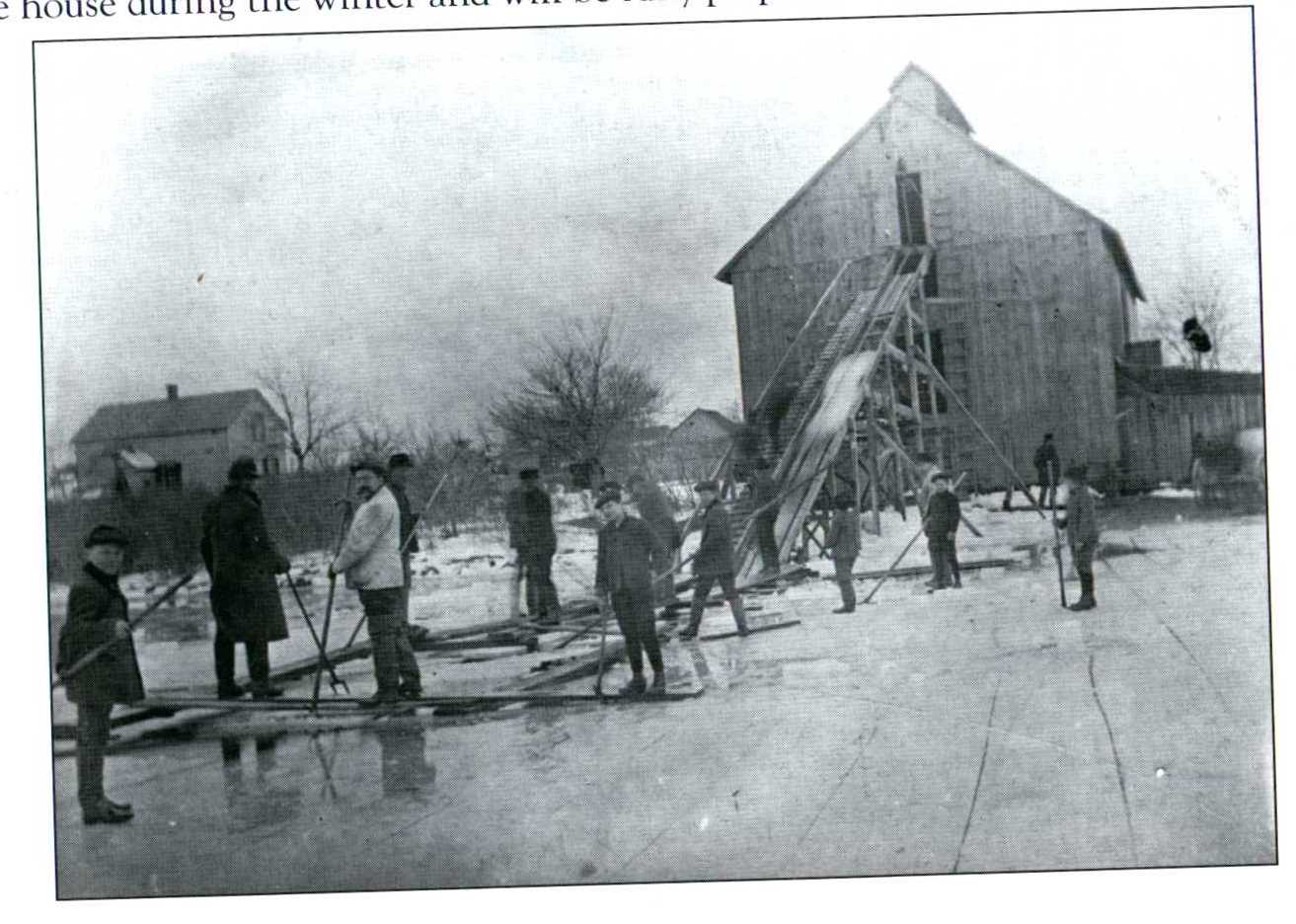
Another of John Feller's industries was ice supply. In 1882, the "enterprising brewer" leased from John S. Krueger "the sole right to produce the frozen commodity", according to the South Side Signal. In 1896, he enlarged the pond & the icehouse to hold over 3,000 tons. The Signal declared that Feller "harvested 6 wagon loads of 3 1/2 inch ice of very fair quality. He intends to fill the house during the winter & will be fully prepared for next summer's rush."
Feller ice house
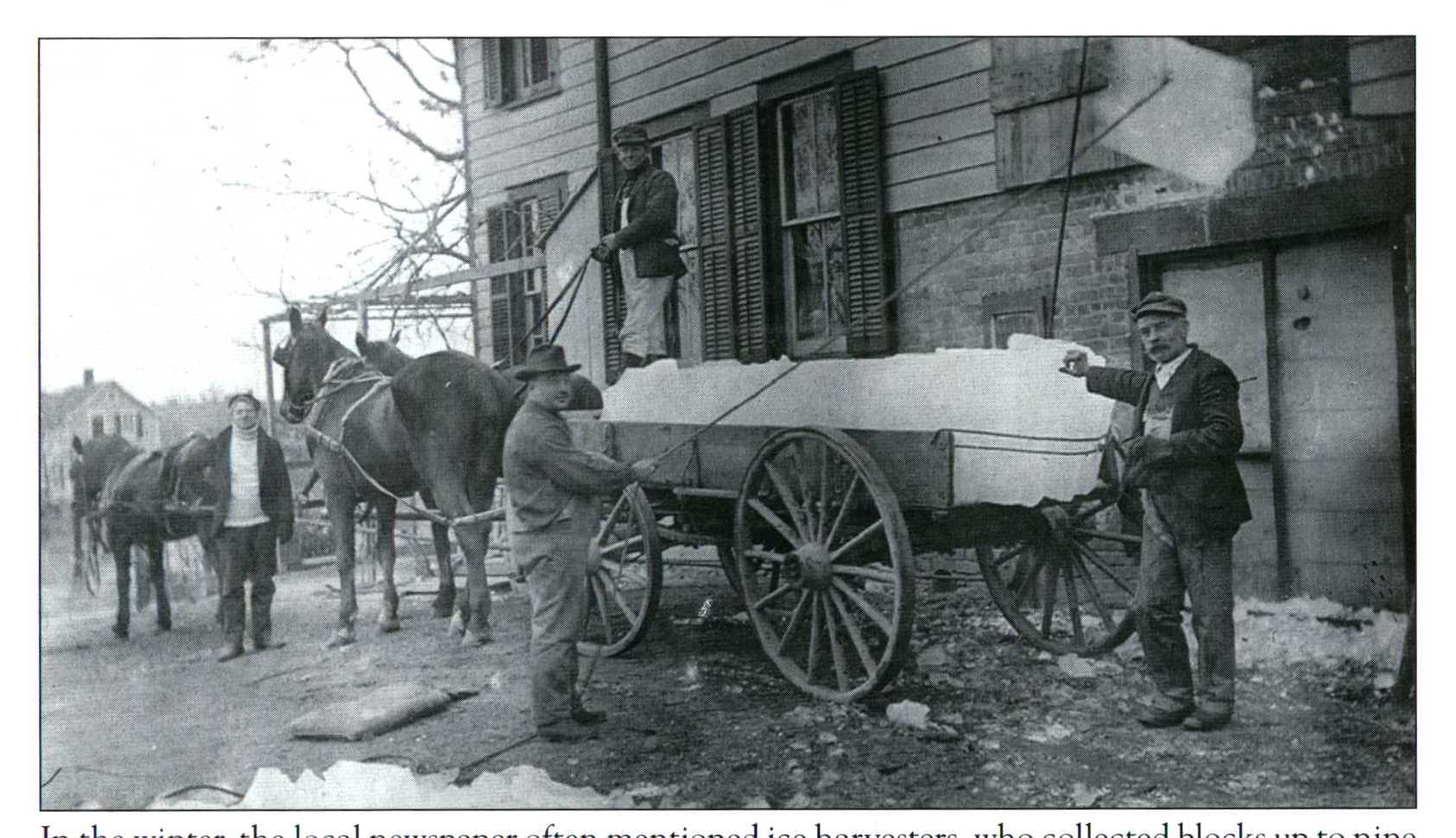
In the winter, the local newspaper often mentioned ice harvesters, who collected blocks up to 9 inches thick & filled their houses "so that during next summer there will be no lack of ice, & cool drinks can be had without difficulty." In 1906, citing a local "ice famine," Feller erected a $5,000 artificial ice plant with a daily capacity of 10 tons, & used it to cool the adjoining brewery.
Eichhammer brewery
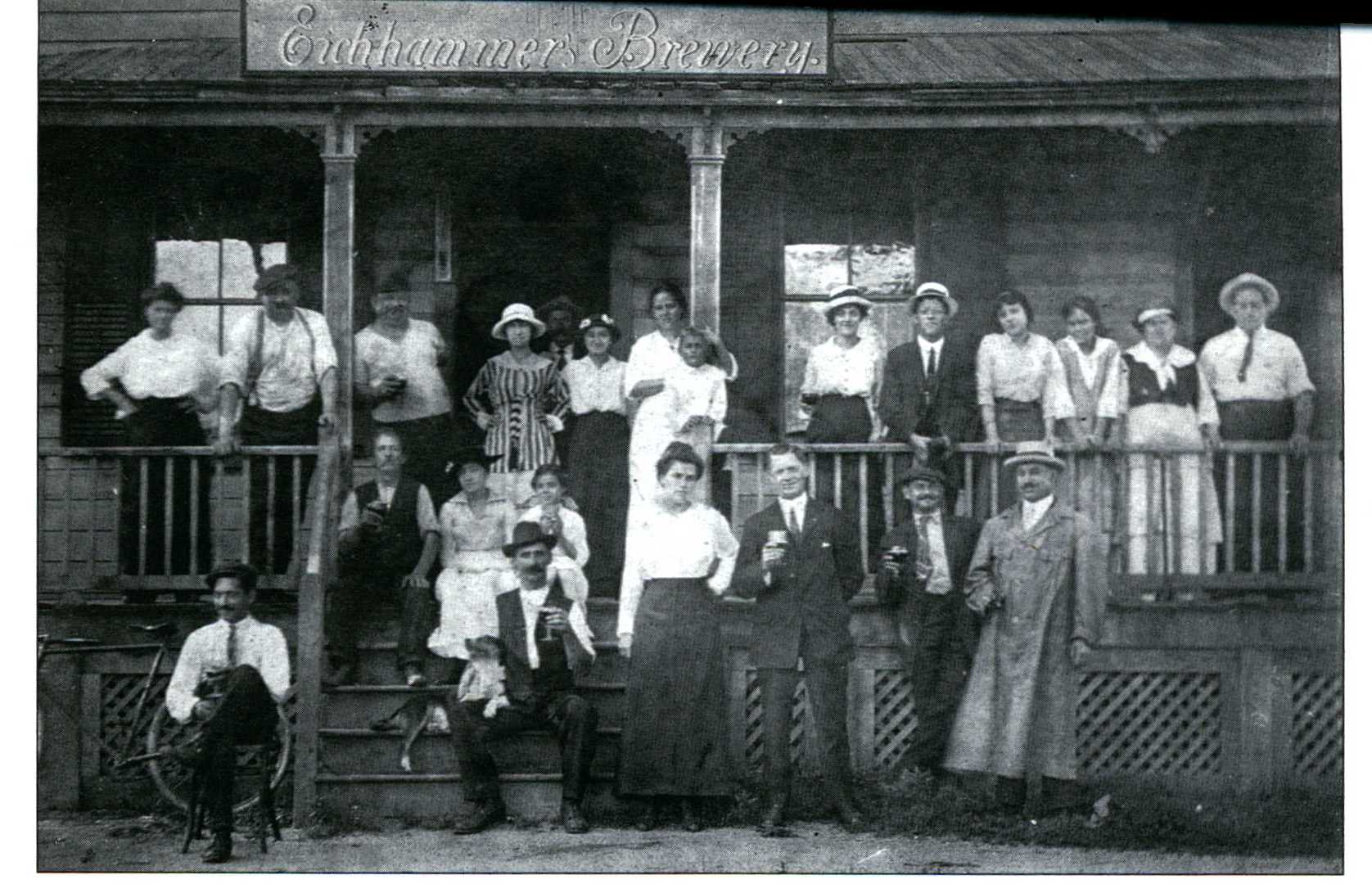
Around 1908, Joseph Hastreiter acquired Feller's brewery, which was later purchased by Otto F. Eichhammer, pictured in 1915. Eichhammer learned the brewing trade in Germany & often bought distressed taverns, fixed them up, & sold them for profit. His granddaughter, Johanna Sandy, recalled that Otto & his daughter, Johanna, came to Lindenhurst from Brooklyn by horse & wagon after reading in a German newspaper that the brewery was for sale.
Eichhammer brewery
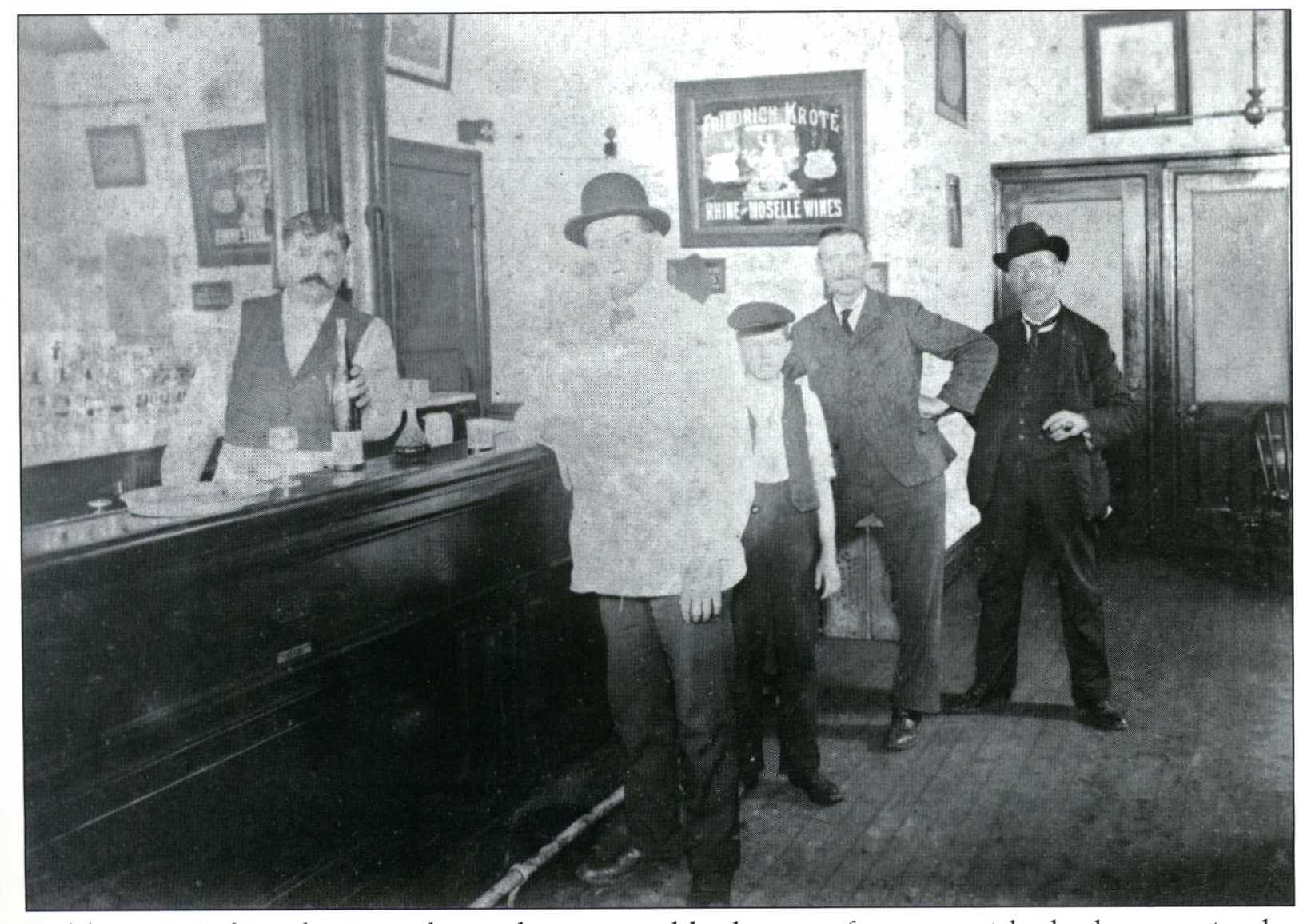
Otto Eichhammer's front house welcomed guests & had rooms for rent, with the brewery in the back. Otto Eichhammer is behind the bar in this photo. Otto's daughter, Johanna, learned the family business & married brewery employee Frank X. Graser. The old brewery site used by Feller & Eichhammer is now St. John's Lutheran Church. Once Prohibition was repealed, the brewery business was revived as Linden Brewery on Montauk Highway at Linden Avenue, not by Otto but by his daughter & son-in-law, in a still existing building.
Eichhammer farm
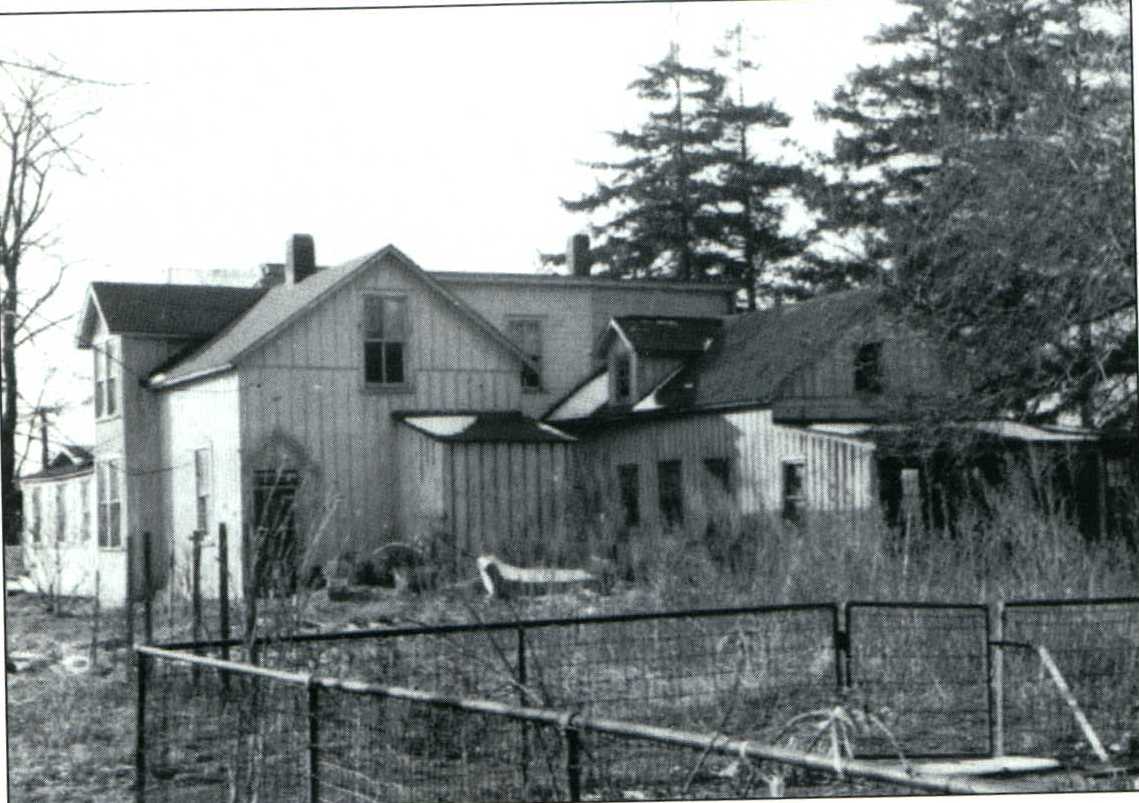
After Prohibition forced his brewery to close, Otto Eichhammer purchased Otto Krueger's Wellwood Avenue farm, near the present Library. Krueger had been a manufacturer of artificial flowers often used in making ladies' hats. The Eichhammer homestead, pictured here ca, 1930, had a large farmhouse, windmill, & icehouse, & Otto raised chickens, geese, ducks, cows, & horses & had an apple orchard for making cider.
Bendheim factory

Suffolk County reportedly had 60 cigar manufactories producing 6.48 million cigars in 1885. 20 of those businesses were in Breslau, 6 of which made over 120,000 cigars. In 1886, the top Brewlau manufacturer was David Bendheim, with 729,950 cigars. The building on Wellwood Avenue was later used by the Catholic church as a school.
Bendheim cigar factory employees
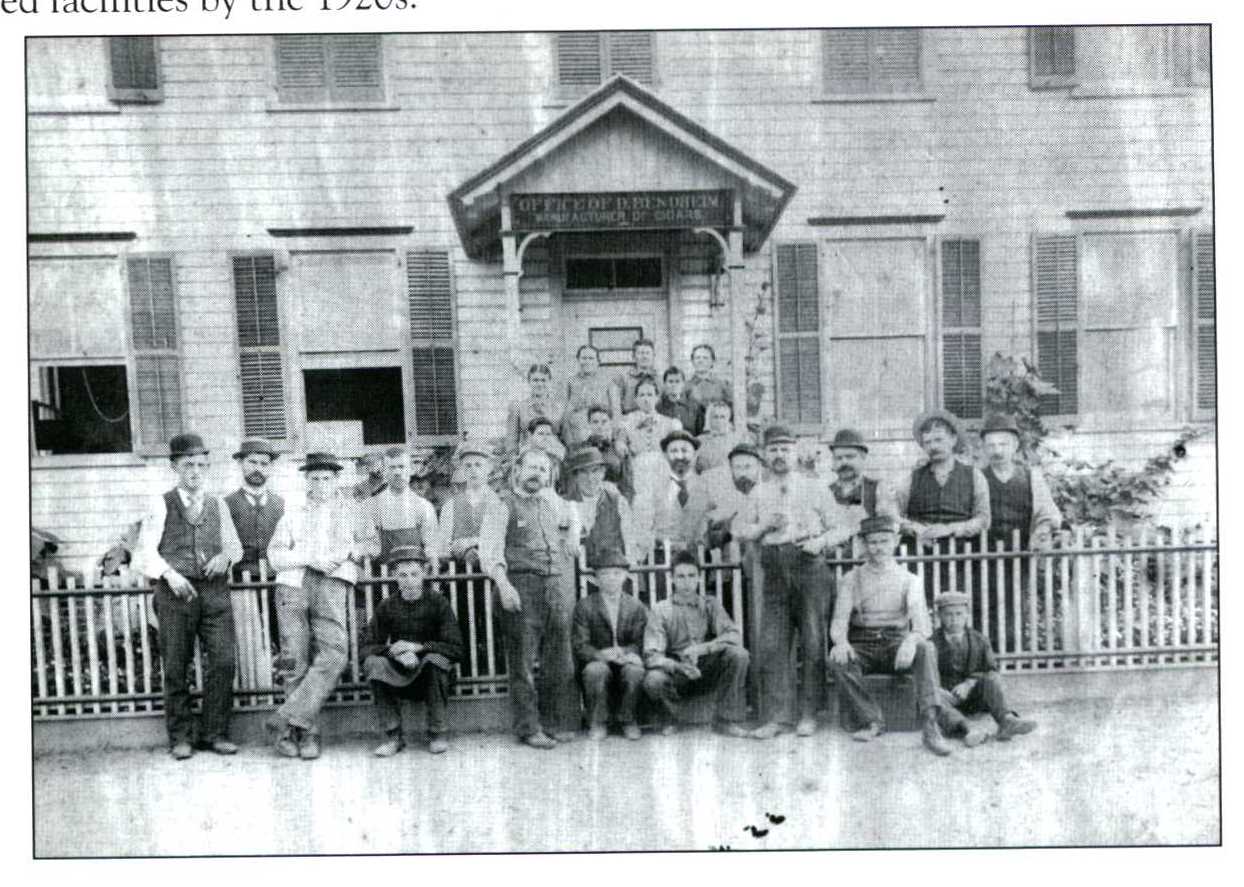
David Bendheim's Wellwood Avenue cigar factory is pictured around 1900 with his employees. Several ladies mastered the trade, as can be seen at the back in the photo. Christina Gries learned to make cigars at the age of 12 in New York City, where she worked until she married Max Gnilka & they moved to Breslau. Christine worked for a few local manufacturers before establishing her own business from her home. She had tobacco shipped from Connecticut & manufactured her brands Wy-not & El Triumpho. Local hand-rolled cigar businesses faded away with the advent of automated facilities by the 1920's.
Sheide Bottling Co. delivery wagon

Marie Sheide Crosgrove, daughter of Fred Sheide & Agnes Wessell Sheide, poses in a Sheise Bottling Co. delivery wagon, ca. 1910. In 1966, Marie shared the story of her parents' business with village historian Clara Kohmann. The business was started in 1900 after Agnes "learned the art of mixing the extracts for the soda in New York & used her talent in the business started by then in Lindenhurst. They started operations in the Dittmann building on New York Avenue & Pete Croce & his brother Charile were their early employees. My father helped with the deliveries which were made by horse & wagon. When their business expanded & larger quarters were needed, they purchased the house on School Street," a former depot, school & firehouse that still stands today. Sheide's was well known for its ginger ale & later bottled Ward's Orange-Crush.
Sheide Bottling Co.
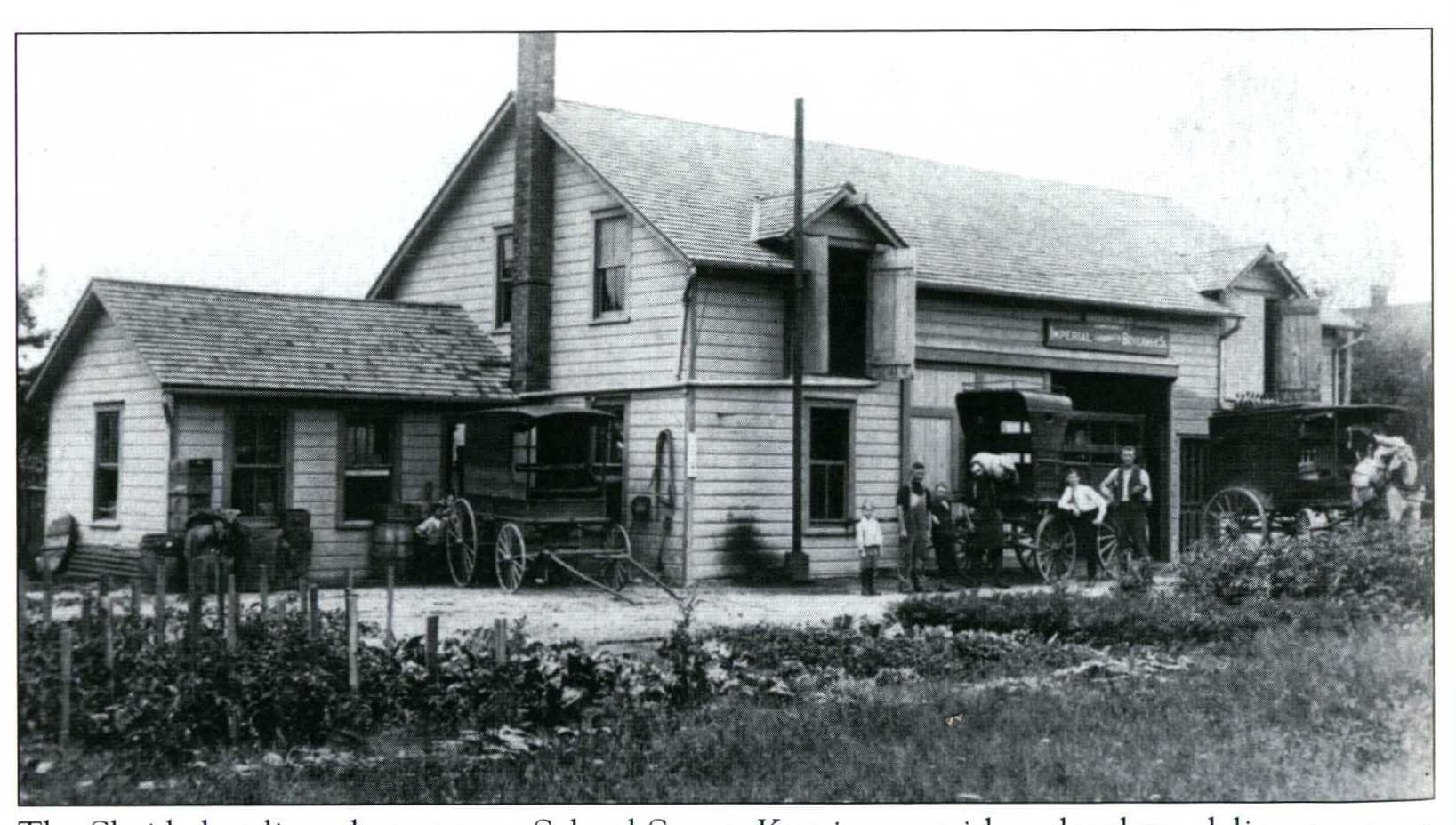
The Sheide bottling plant was on School Street. Keeping up with technology, delivery wagons were replaced by a motorized truck in 1913, &, according to the South Side Signal, "an up-to-date bottle-washing machine, the only one of its kind on the island outside of Brooklyn" was added in 1914, when the company advertised "Sheide Imperial Carbonated Beverages - Made of Pure Sugar & Under Sanitary Conditions. We invite inspection" The plant operated until 1933, closing after an increase in competition & Agnes's passing.
Sheide Bottling Co. delivery truck
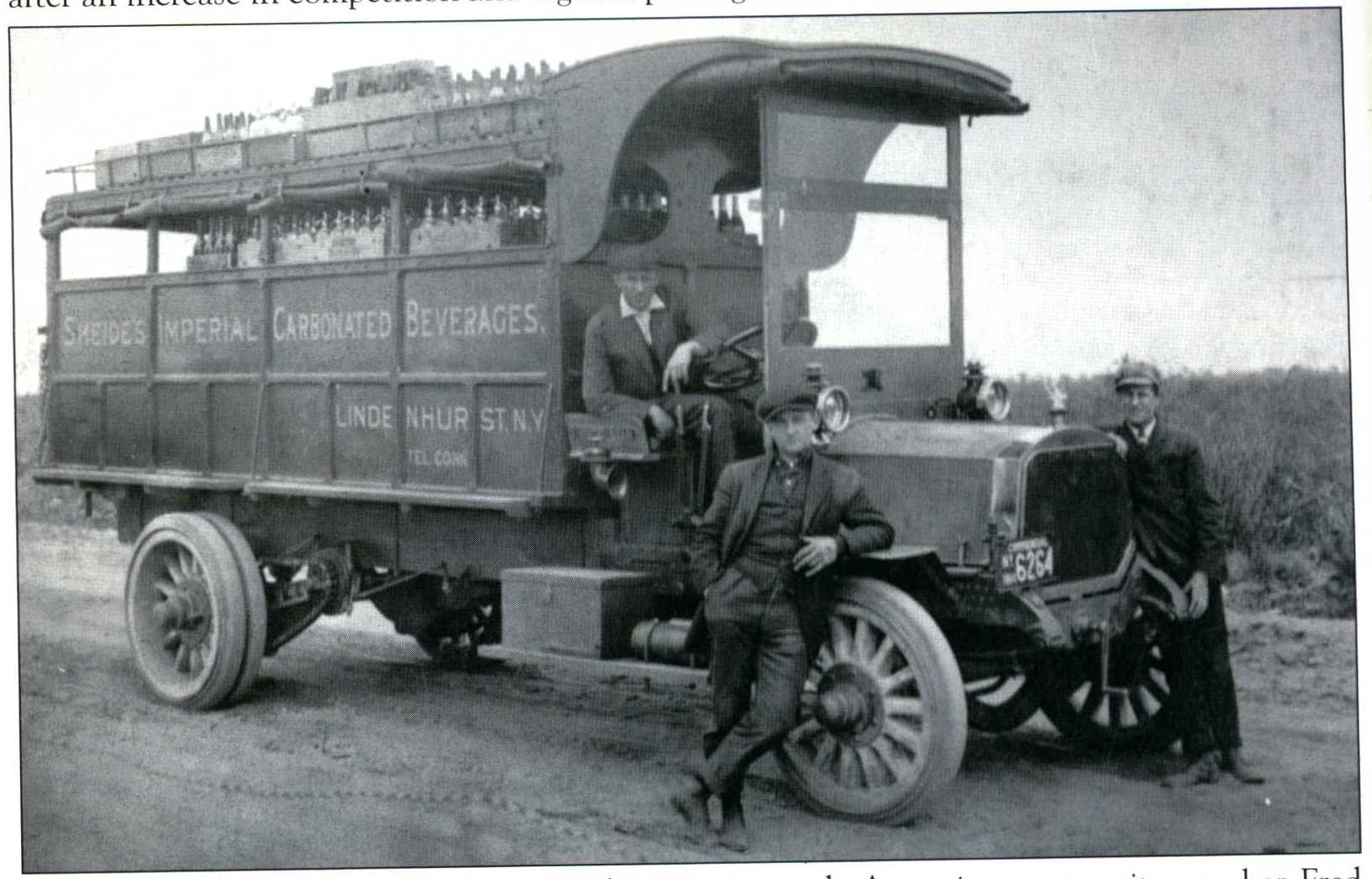
Pictured is a Sheide's Imperial Carbonated Beverages truck. An active community member, Fred Sheide was elected Babylon town clerk (1907-1911), to the state assembly (1911), & Babylon supervisor (1913-1917). In 1927, Sheide opened the Plaza restaurant & lounge on Montauk Highway at the head of Little Neck Creek, following the path of his in-laws, who owned hotels in Lindenhurst & at Linden Beach. In 1931, Prohibition agents raided the Plaza Hotel on a charge of beer running.
Heling Livery Stable
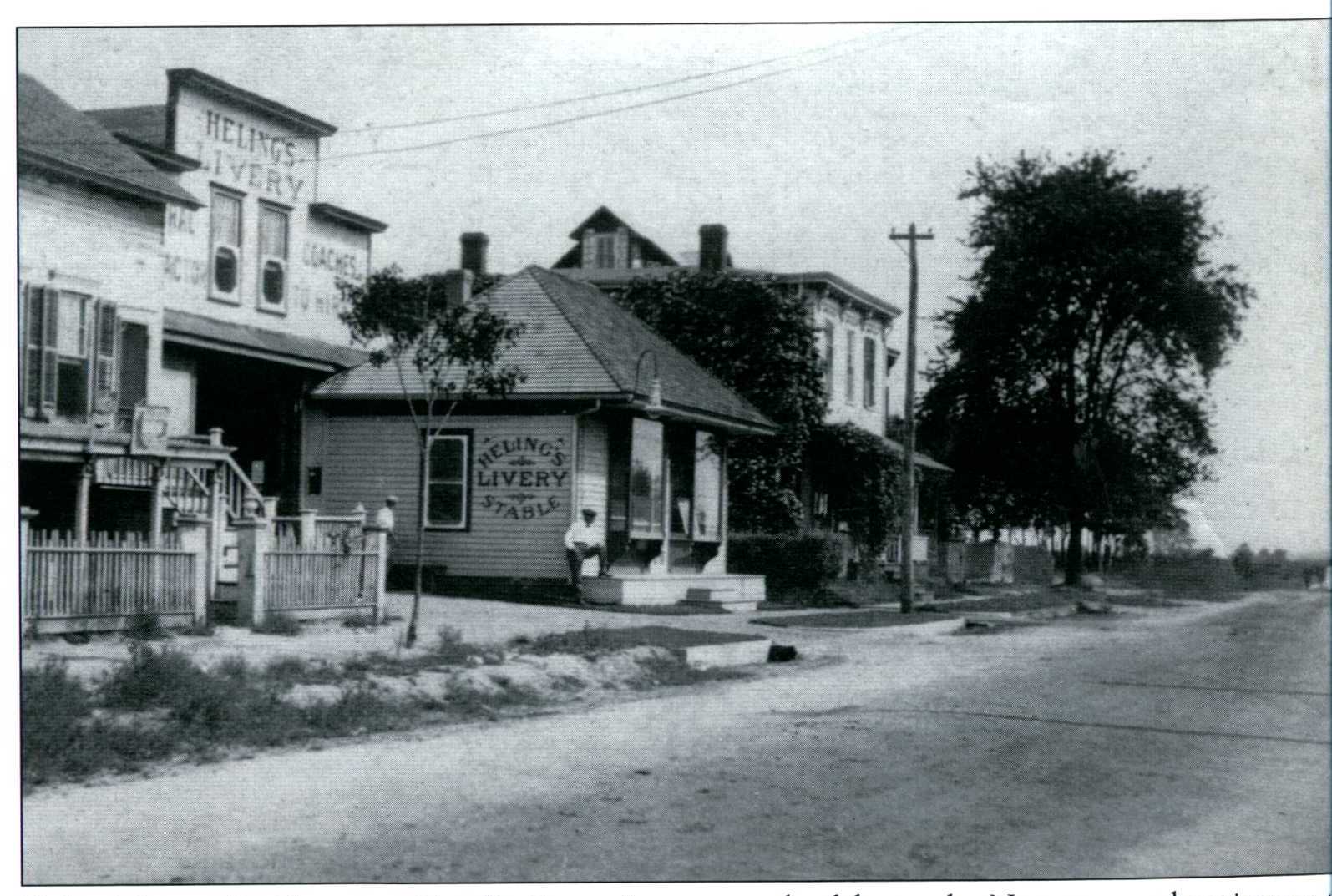
Heling's Livery Stable was on East Hoffman Avenue north of the tracks. Newspaper advertisements in 1905 boasted "Up-to-date rigs & turnouts to let at reasonable prices" & "Dealer in new & 2nd-hand wagons, harness, whips, blankets, etc." That same year, the livery stable was one of the 1st establishments in the village business district fitted with electric lights.
Heling Stage Wagon

Charles Heling (right) organizes passengers on his stage wagon, another service of the livery stable. Heling served as village mayor from 1931 to 1937. Mayor Heling initiated numerous local work projects, even making several trips to Washington, DC, to provide local employment, including road improvements & clearing village-owned land. He was also elected to terms as highway superintendent for the town of Babylon.
Heling Undertaking
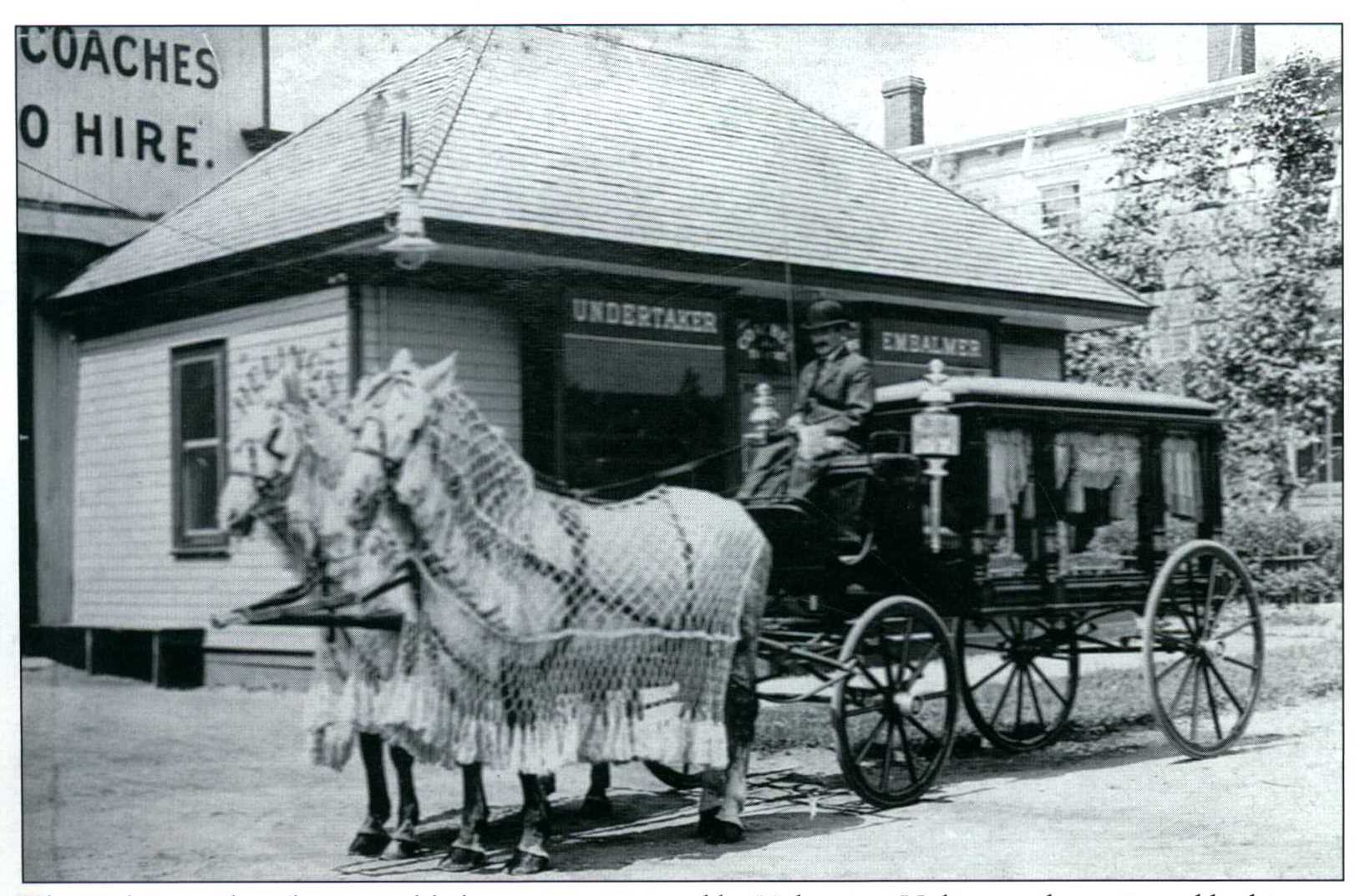
The Heling undertaking establishment was started by Valentine Heling & continued by his son Charles. It is pictured alongside the family-run livery around 1915. In November, 1896, the Helings' livery & mortuary office were destroyed by fire. Undeterred, they rebuilt the office, barns, & outbuildings within a couple of months. The mortuary building was razed for construction of the Hebal-Muller Inc. cheese factory on the present site of the Suffolk County District Court.
Heling Undertaking

The funeral procession for Charles Warta Jr. is pictured on July 12, 1914. He served as Babylon town clerk & Lindenhurst fire chief. Following private services at Warta's home, a public ceremony at the Odd Fellows Hall was described by the South Side Signal as "the largest ever in Lindenhurst", the casket "almost hidden by the many handsome floral tributes & a constant procession of friends." Wrieth's & Hirsch's bands led the funeral march to the cemetery. Charles Heling drove the funeral coach.
Dittmann Bros.
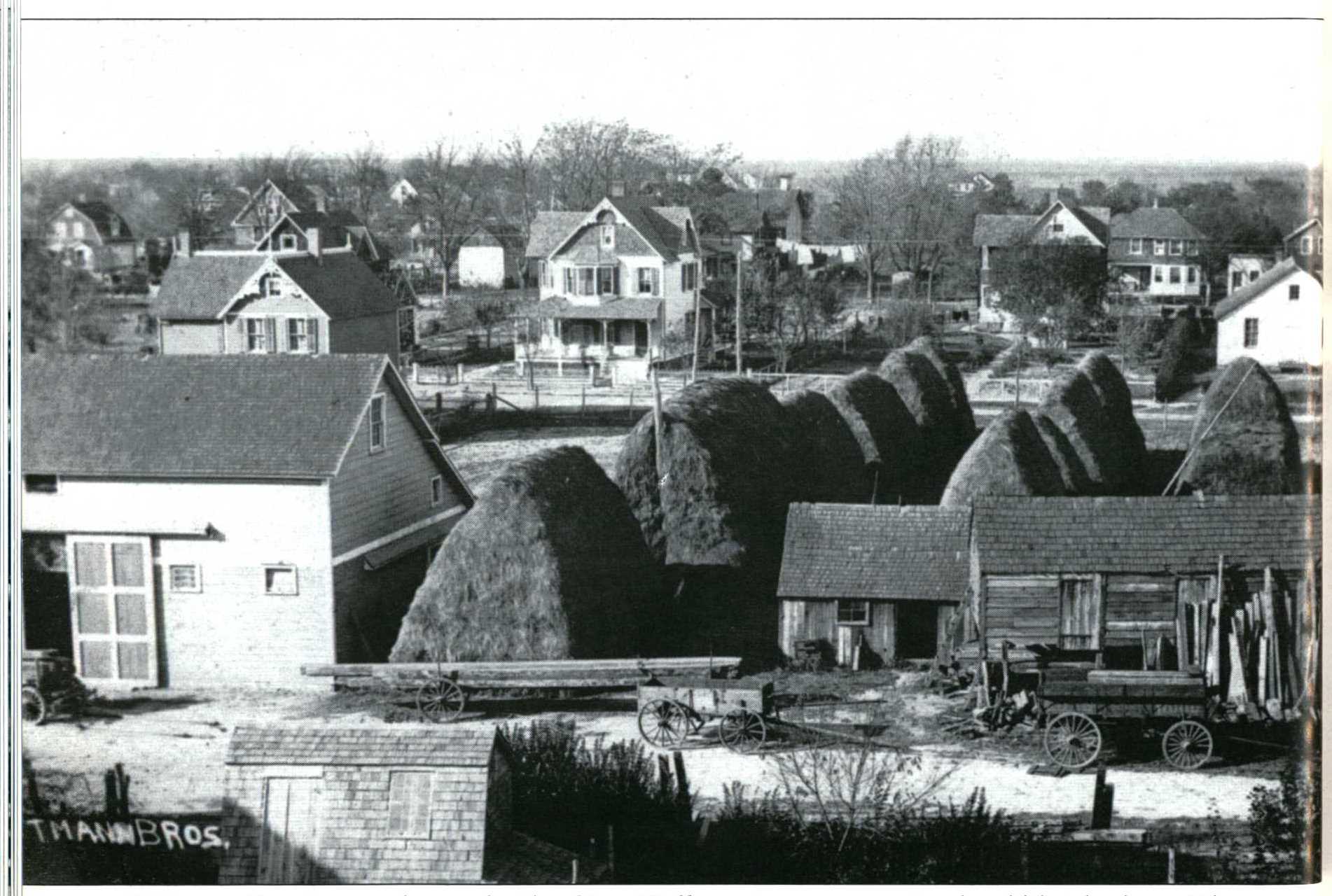
Dittmann Bros. was on the north side of East Hoffman Avenue, opposite the old freight depot. The firm moved everything from steam boilers & bank safes to entire buildings. In 1908, the South Side Signal announced, "Dittmann Bros. housemovers & truckmen, are having a truck built to order at their brother's shop at Amityville, to carry from 5 to 10 tons weight. The vehicle is so constructed that 2 or 3 horses can be harnessed abreast or as many as may be required to haul the load. The newly painted truck with the owners' 3 grays (horses) abreast will equal anything on the Island." The described vehicle was not motorized - the "truck" was a horse-drawn flat cart. The Dittmanns also constructed many local buildings & sold coal for heating homes. Serving the surrounding farming community, they also sold hay, hay balers, & farm wagons. By 1915, a railroad spur was laid to the Dittmann yard for the convenience of directly loading materials.
Mielke Lumber Company
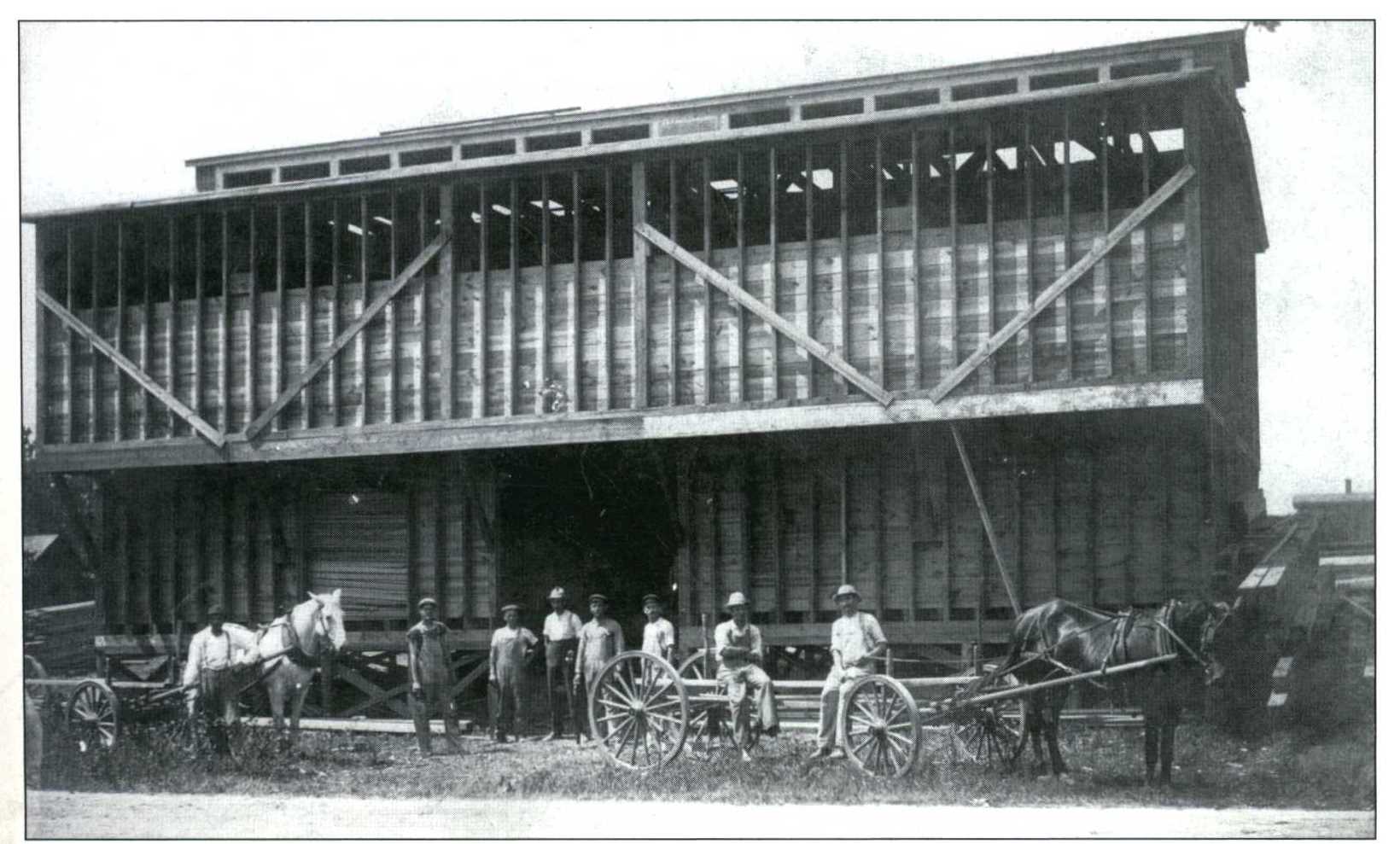
Ewald J.H. Mielke's lumber company was on West Hoffman Avenue, pictured around 1910. Also an insurance agent, Mielke advertised policies for fire, life, health, & personal accident. Ironically, the South Side Signal reported Mielke's own workplace accident in 1911: "while running a machine at the yard...(Mielke) caught the forefinger of his left hand in the swift moving saw, severing the finger at the 1st joint. Mr. Mielke ran to the office of Dr. (Walter) Wellbrook."
Wolter Grocery
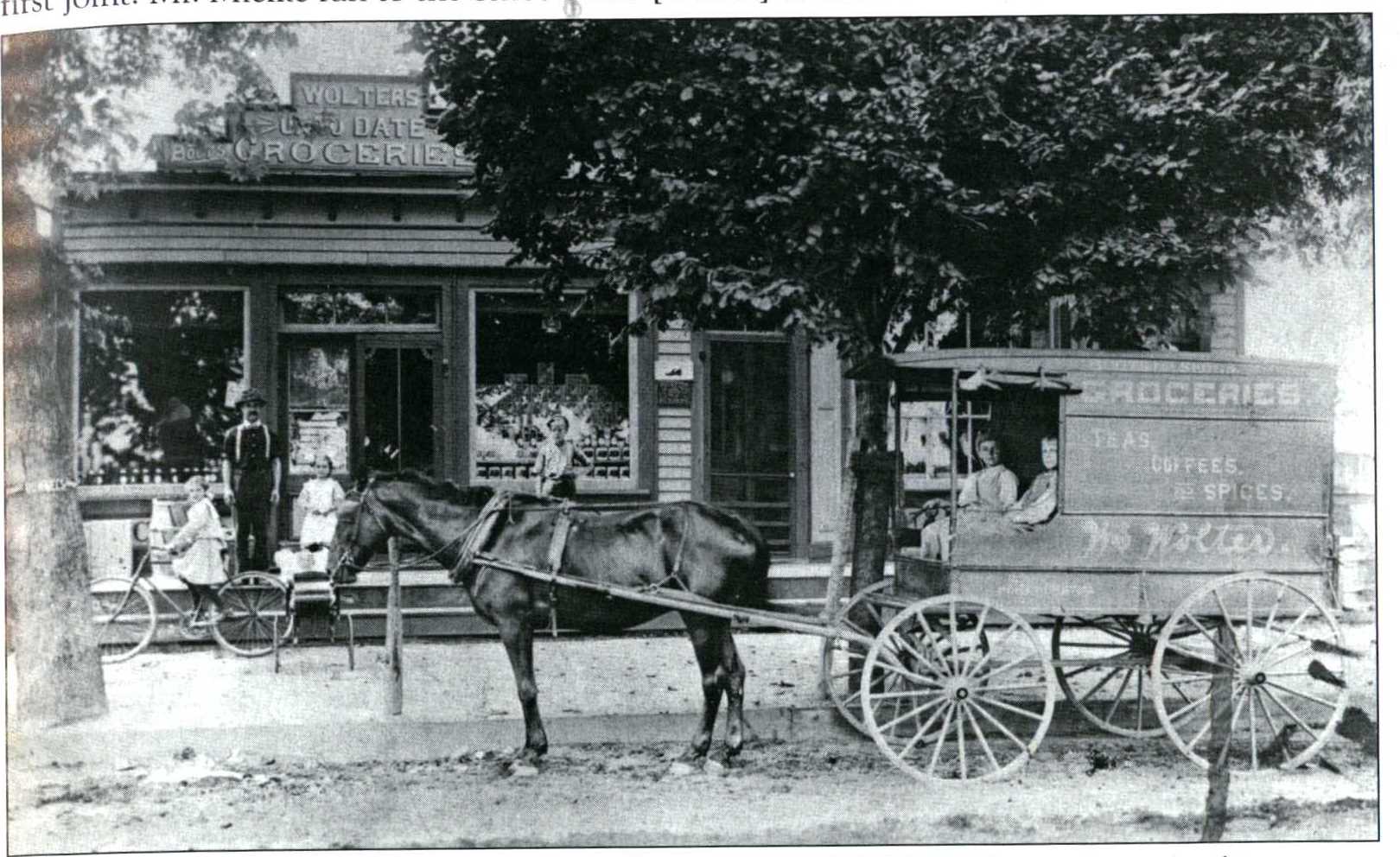
William Wolter is pictured with his 6 children around 1910. Upgrading to motorized transport, "Grocer William Wolter surprised his friends Saturday, when he came down the boulevard atop of a new late model 6-cylinder delivery wagon direct from West Street, Manhattan," according to a 1914 South Side Signal. Wolter's father, German immigrant William Sr., brought the family to Breslau in the 1870's & operated the City Hall Hotel at Wellwood Avenue near Dekalb Avenue.
Kienle Dry Goods Store
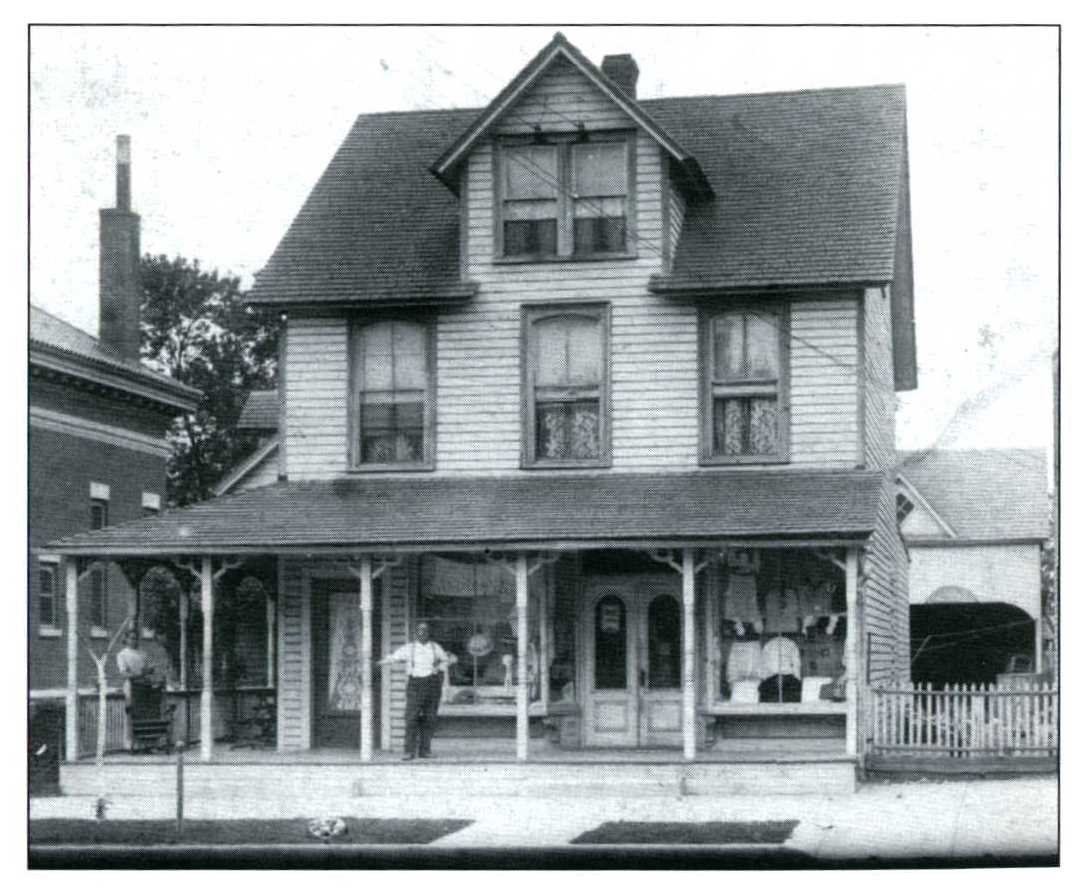
Kienle Dry Goods Store is pictured around 1908. Dry goods stores carried textiles ready-to-wear clothing, & accessories, as displayed in the store windows, with Fred Kienle (center) & daughter Margaret (left). This store was destroyed by fire on June 20, 1914. A temporary store was established in the lower level of the National Theater while a new brick store & living quarters were constructed at the old site & occupied that October.
Roulston Grocery Store
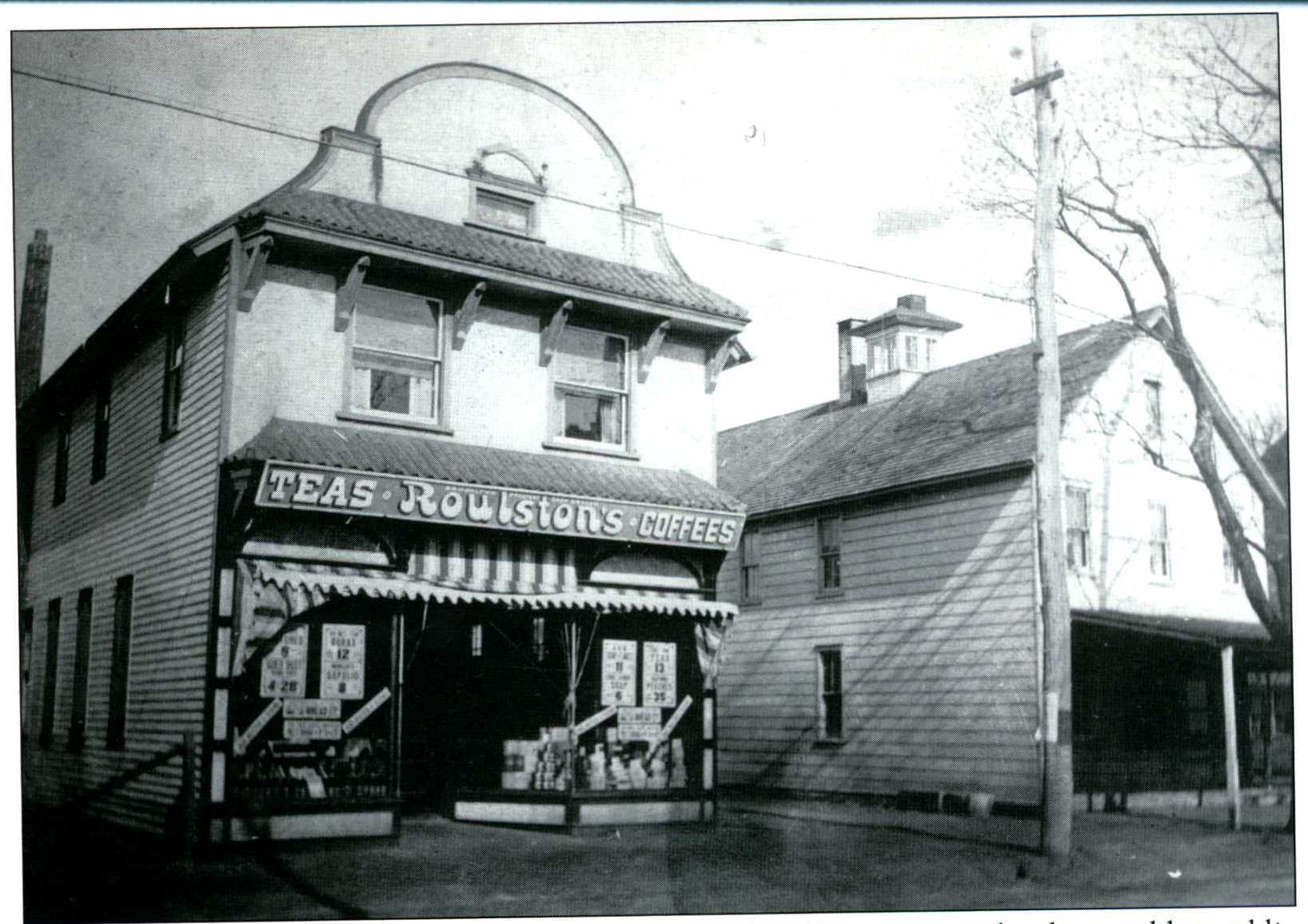
After construction of a larger Copaigue schoolhouse, the old one-room school was sold at public auction for $265. Dittmann Bros. moved the schoolhouse to its Wellwood Avenue property in 1912, adding a new storefront & 2nd story, as shown at the right. It was demolished around 1938. Roulston's store, at left, was part of a New York City & Long Island grocery chain founded by Thomas H. Roulston.
Pollini Grocery Store

This photograph was taken in 1896 on the northeast corner of Auburn Street & Wellwood Avenue. The building was constructed by the Dittman family, natives of Breslau. Angelo & Albina Pollini sold groceries here; they are shown with their 4 eldest children (from left to right), Edmund (in carriage), Mario, Santina, & Felix. Louis C. Pollini recalled in 1993 that they were the 1st Italian family to settle in Lindenhurst.
Irmisch Tobacco Shop
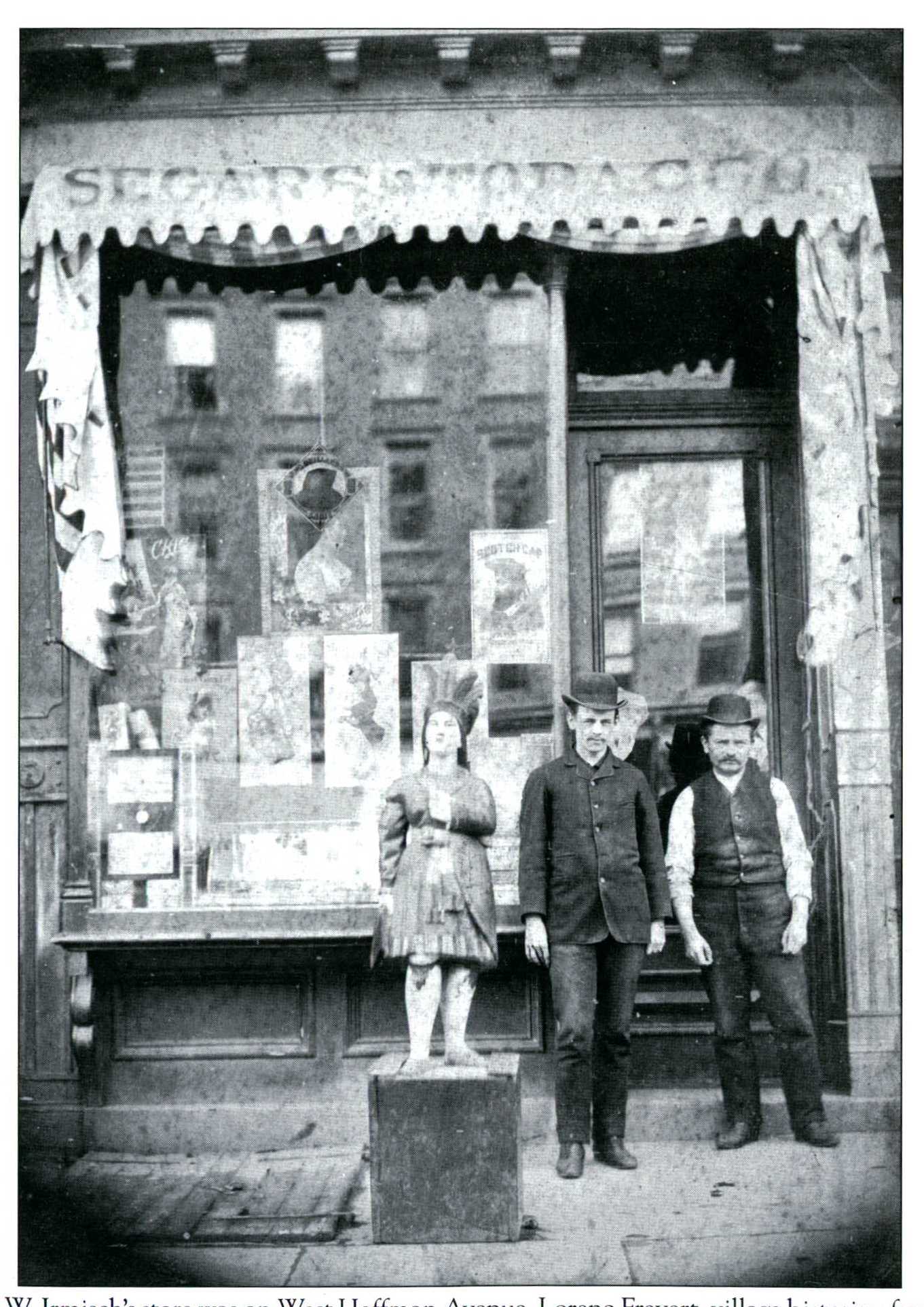
George W. Irmisch's store was on West Hoffman Avenue. Lorena Frevert, village historian from 1946 to 1961, wrote this profile: "George W. Irmisch, a prominent public figure in this community many years ago, was born in New York City on January 13, 1862 & came as a young lad to Lindenhurst with his parents. He attended the local public schools & pursued the cigar manufacturing industry, then a thriving occupation in Lindenhurst. Later, he opened a confectionery & stationery store on West Hoffman Avenue, a short distance west of South Wellwood Avenue & built up a large newspaper trade. At age 30, he was appointed postmaster by President Grover Cleveland. He was one of the founders of the First National Bank of Lindenhurst & served as its Vice-President from its organization in 1907. A volunteer fireman for 54 years, he was a Chief Engineer of the Lindenhurst Fire Department & served as the 1st presiding officer of the Lindenhurst Exempt Volunteer Firemen's Association. He was school tax collector & was a member of the Board of Education for School District #4 for 24 years.
Irmisch Tobacco Shop & Post Office
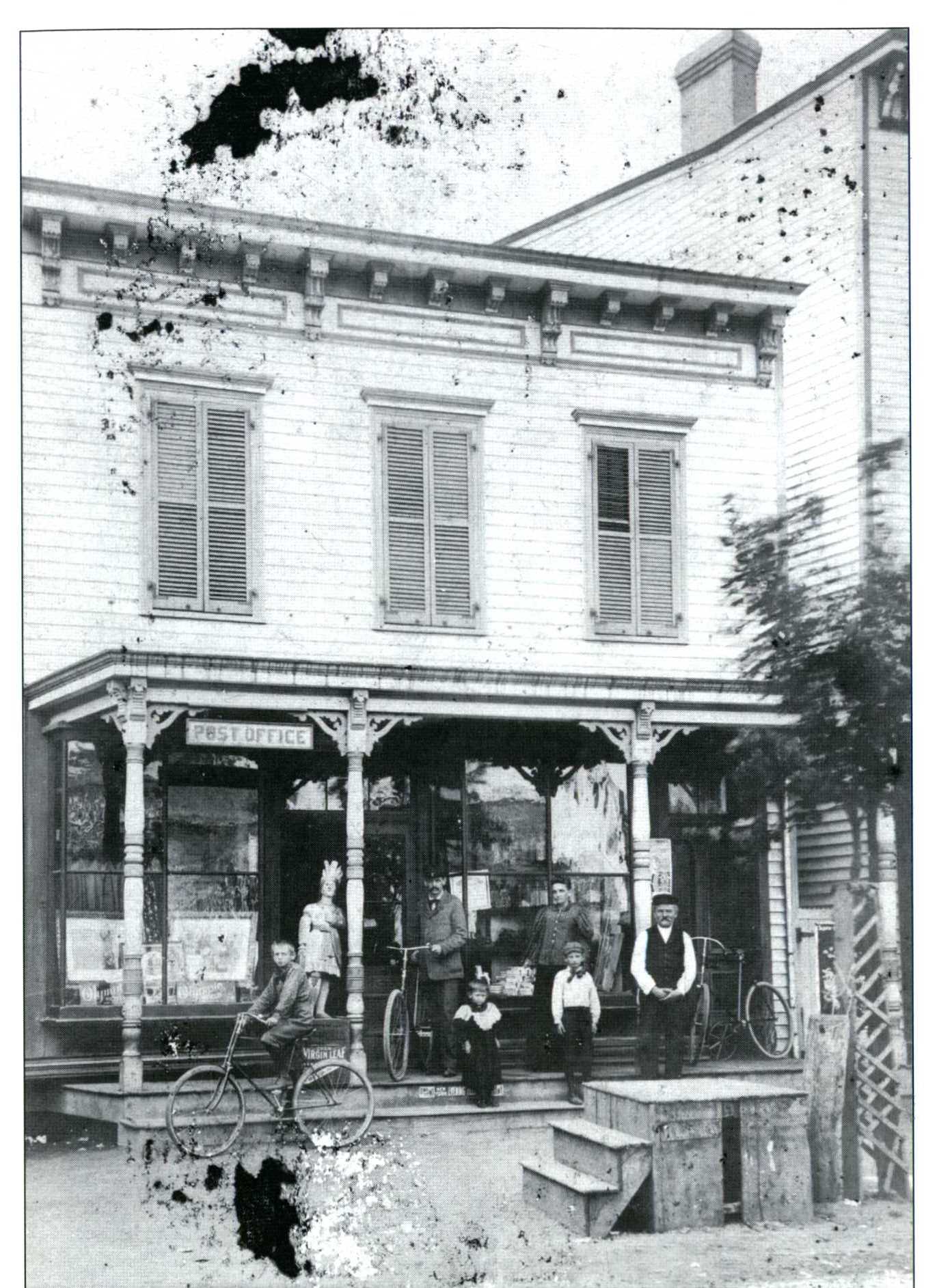
According to former village historian Lorena Frevert, George W. Irmisch, "a life-long Democrat, was elected Justice of the Peace in 1903 & represented this area on the Babylon Town Board long before Lindenhurst became an incorporated village. Because of his long tenure in this position, he was known as 'Judge Irmisch' by every man. woman & child in the community. 'Judge' Irmisch took an opposing stand when plans were being made to incorporate Lindenhurst, believing that the community could not afford to do so. However, when the village became incorporated in 1923, the Judge gave his all to promote its welfare. In 1927 he was elected President of Lindenhurst, the 3rd man to hold that title. Also the last, because the title was changed to Mayor during his administration when Lindenhurst was officially declared a 2nd-class village & the Village Board was increased from 2 to 4 Trustees. The triangular parcel of land located between South Broadway & South 3rd Street is known as Irmisch Historical Park. The property was given to the village in memory of the late George W. Irmisch by his descendants. Irmisch died on October 8, 1937at age 75.
Wild Plumbing & Heating
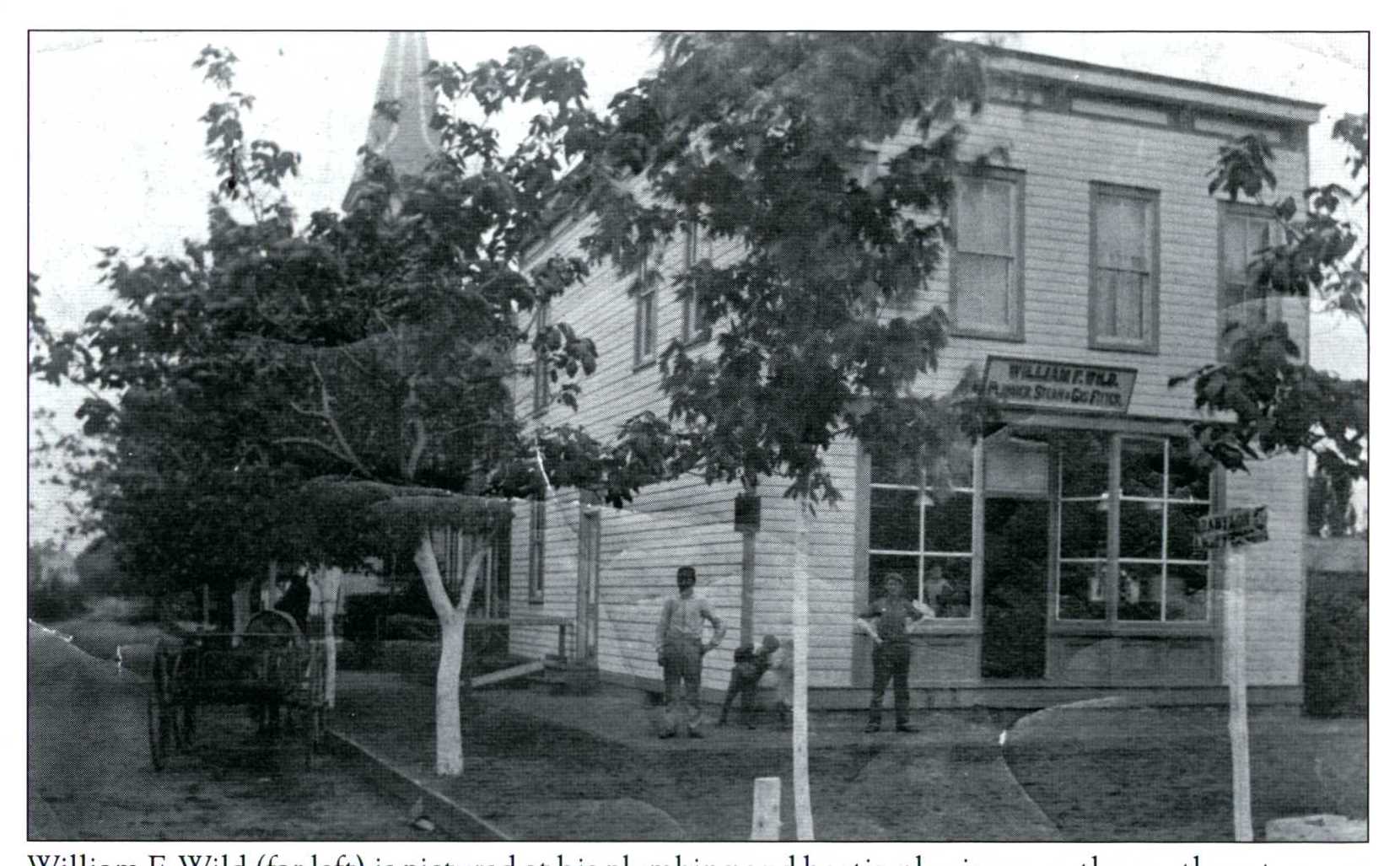
William F. Wild (far left) is pictured at his plumbing & heating business on the northwest corner of Wellwood & John Street. He also operated a bicycle shop & post office at the site. Wild was a 53-year member of Breslau Engine Company #1. After his death in 1949, flags were lowered to half-mast in his memory, & the fire department shield was displayed outside headquarters for 30 days.
Voelker Plumbing & Heating

Carl Voelker built this Hoffman Avenue plumbing & heating shop for himself in 1910. The January 16, 1914 South Side Signal reported, "The cold snap of Monday & Tuesday caused considerable trouble to water pipes here, which has kept boss plumber Carl Voelker & his assistants busy." Voelker sold the shop to Alfred S. Biggs & George B. Perkins in August, 1914 & established a plumbing business in New York City.
Schmalkuche Bakery

Schmalkuche's Bakery & Grocery is pictured in 1892 on West Hoffman Avenue. August Schmalkuche, 2nd from right, was born in Braunschweig, Germany, where he learned the trade of baker. Around 1866, he immigrated to America, operating a boardinghouse before moving to Breslau in 1870. After the 1888 blizzard, Schmalkuche reportedly led a group wearing improved snowshoes across snowdrifts & woods to deliver bread to the Sisters of St. Dominic convent in North Amityville. Schmalkuche operated the post office at his bakery from 1889 to 1893, during which time the name "Lindenhurst" was adopted by the village. This was the 4th location of the village post office.
Town Clerk's Office (Warta Residence)
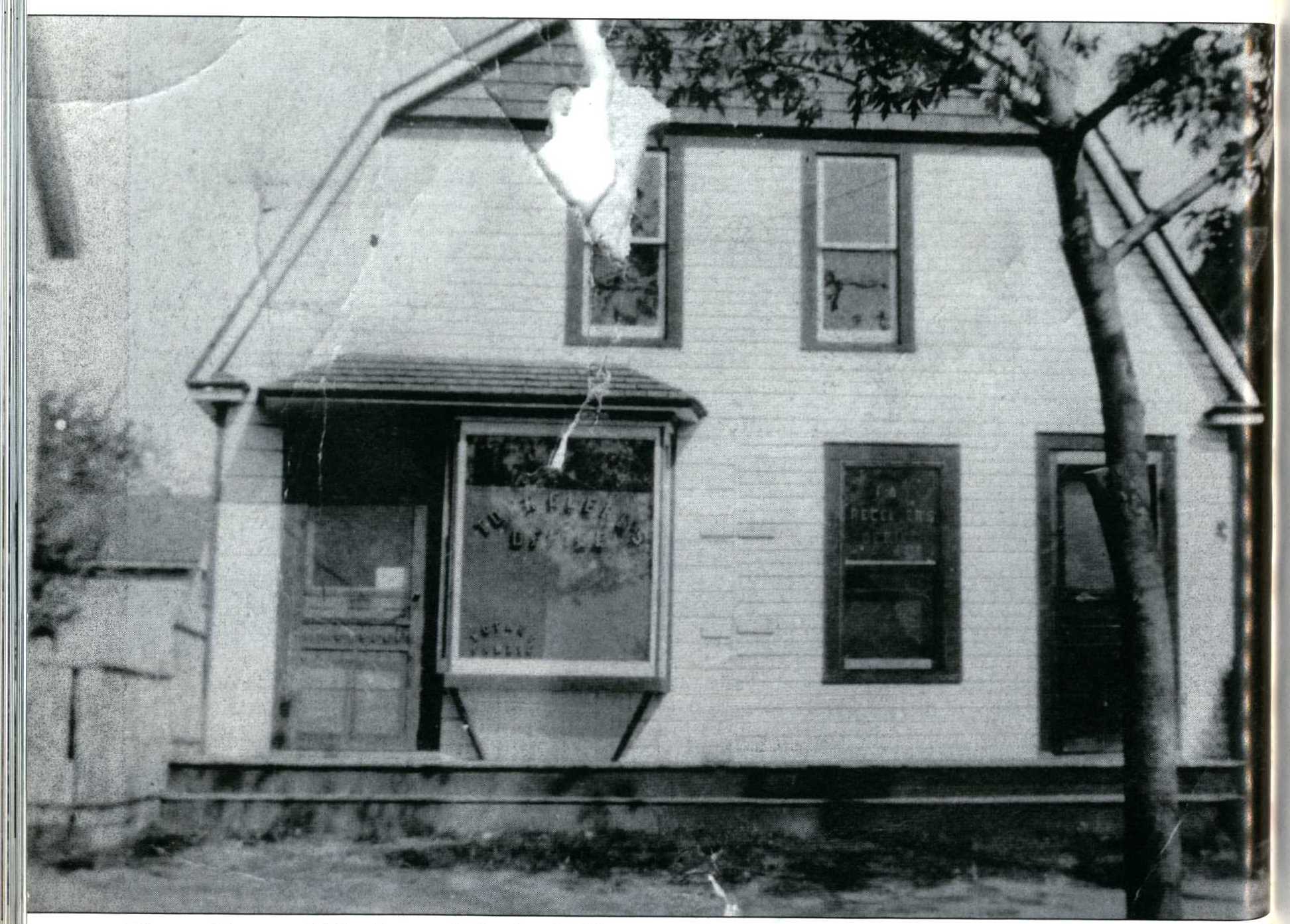
The residence of Charles & Elizabeth Warta on South Wellwood Avenue is pictured around 1911. During Charles Warta's tenure as town clerk of Babylon (1911-1914), the front window was stenciled "Town Clerk's Office", & residents could transact business with him there. Soon after Warta was elected, the South Side Signal alerted residents, "The Town Clerk's office is to be fitted up soon with a 3x6 table, a flat top desk, book-case, 8 chairs & a rug, for the convenience of those having business at the office." From the establishment of the town of Babylon in 1872 until the construction of a permanent Babylon Town Hall in 1918, the town clerks often established offices in their homes of rented office space in local business districts. Additionally, the Babylon Town Board meetings & other local government activities were held at hotels around Babylon, with the schedule & location printed in the local newspapers.
2nd Post Office
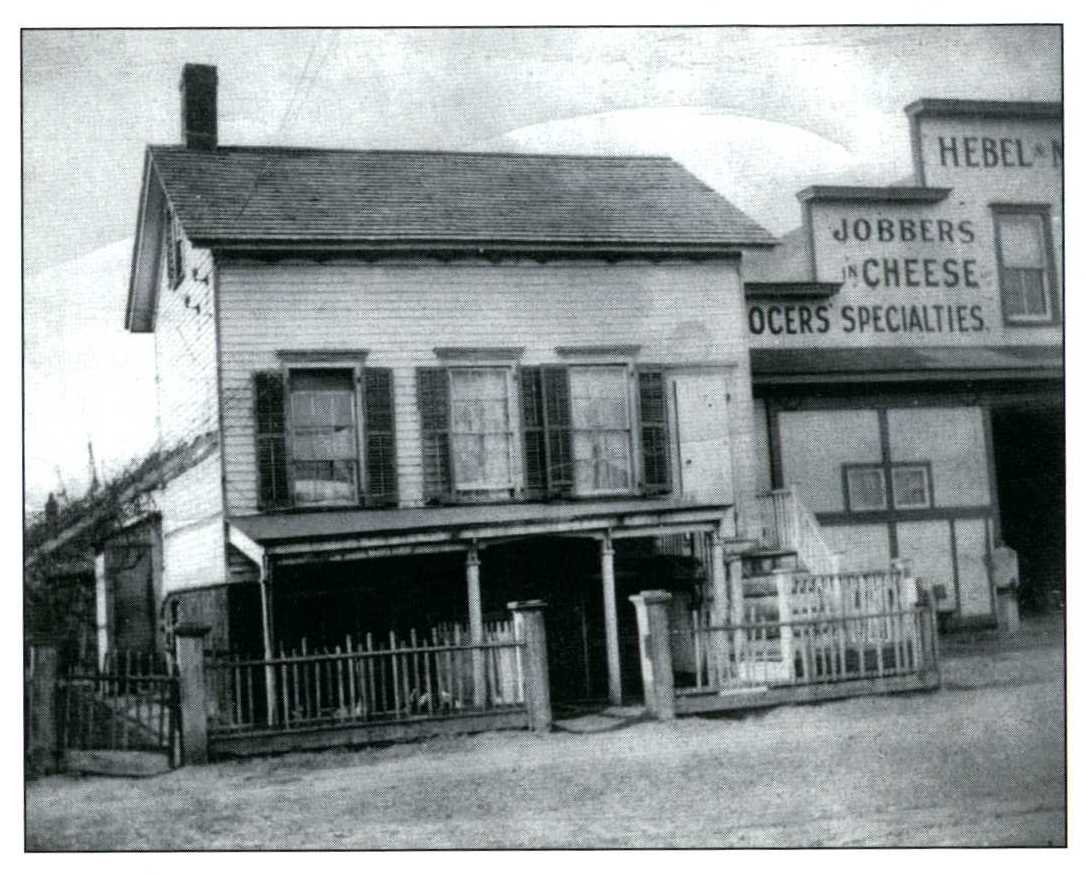
Breslau's 1st post office was located in the original train depot, opening on January 9, 1871, with station agent Gustave Gube as postmaster. In 1879, Ferdinand Beschott was appointed postmaster, & the post office was eventually relocated to the lower level of his residence on East Hoffman Avenue (pictured). Postmaster Beschott served until July 30, 1885. As he began to sort the evening mail that day, Beschott died suddenly of heart failure. Charles Wagner succeeded Beschott & moved the post office to his West Hoffman Avenue residence, next to Nehring's Hotel.
5th Post Office (Irmisch Tobacco Shop)
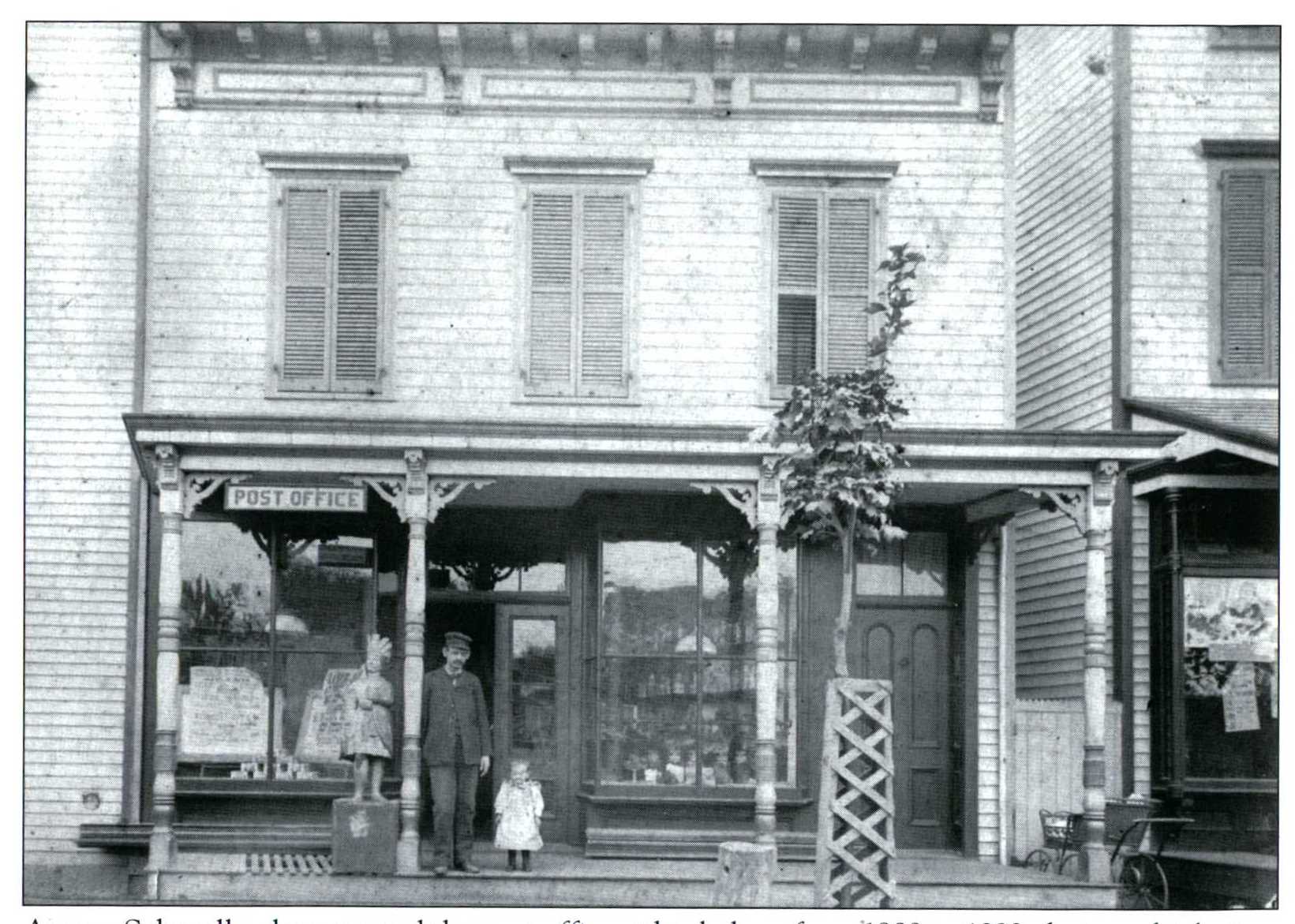
August Schmalkuche operated the post office at his bakery from 1889 to 1893, the 4th location of the post office, during which time the name "Lindenhurst" was adopted. George W. Irmisch became postmaster in December, 1893, & the post office was established at his West Hoffman Avenue cigar shop (pictured). This was the 5th overall location of the village post office. The South Side Signal reported, "He has a new outfit, consisting of 112 call boxes & 8 lock boxes. It is a very neat outfit, & Mr. Irmisch is quite proud of it."
Wild Bicycle Shop (8th Post Office)
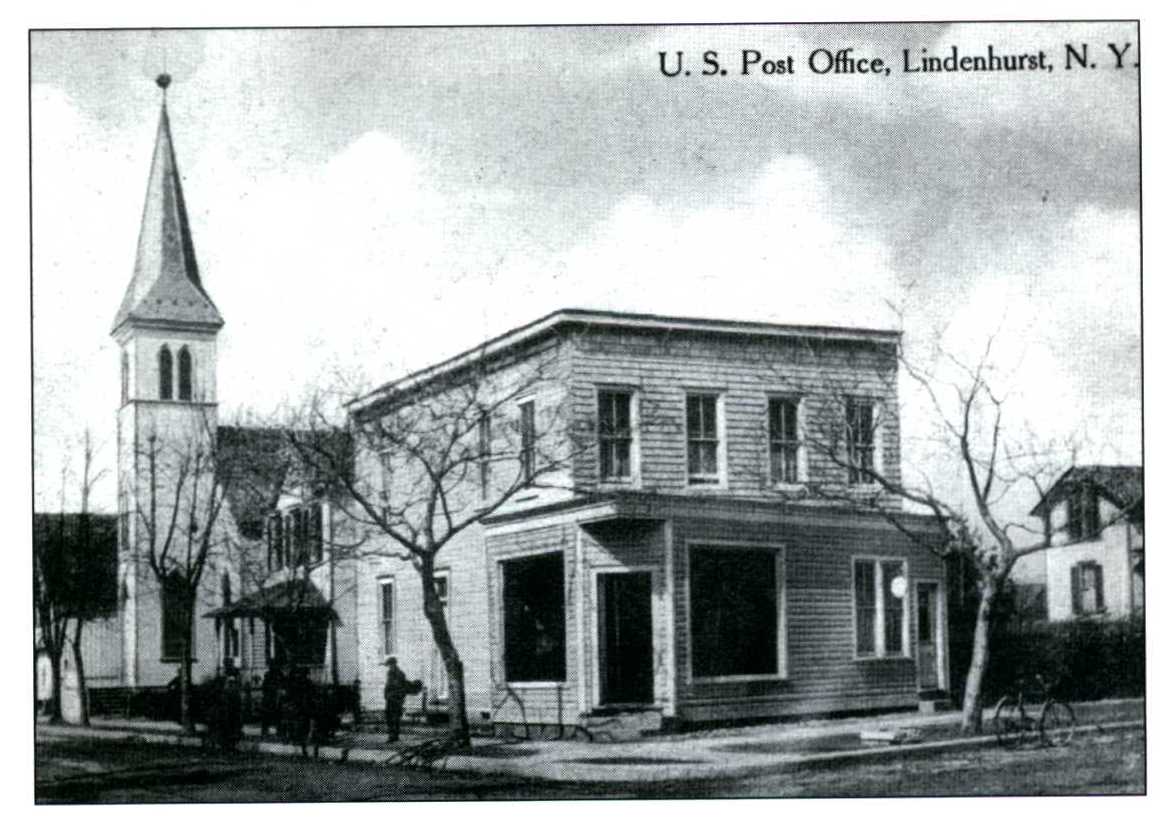
Frederick Torns, Sr. became postmaster in 1897, operating 1st from his butcher shop & later at the home of his son George. William F. Wild was appointed postmaster in 1913, using his bicycle shop (pictured) at the northwest corner of West John Street & Wellwood Avenue as the post office. Wild held the position until 1922, serving nearly twice as long as the local postmasters before him.
10th Post Office, 1928
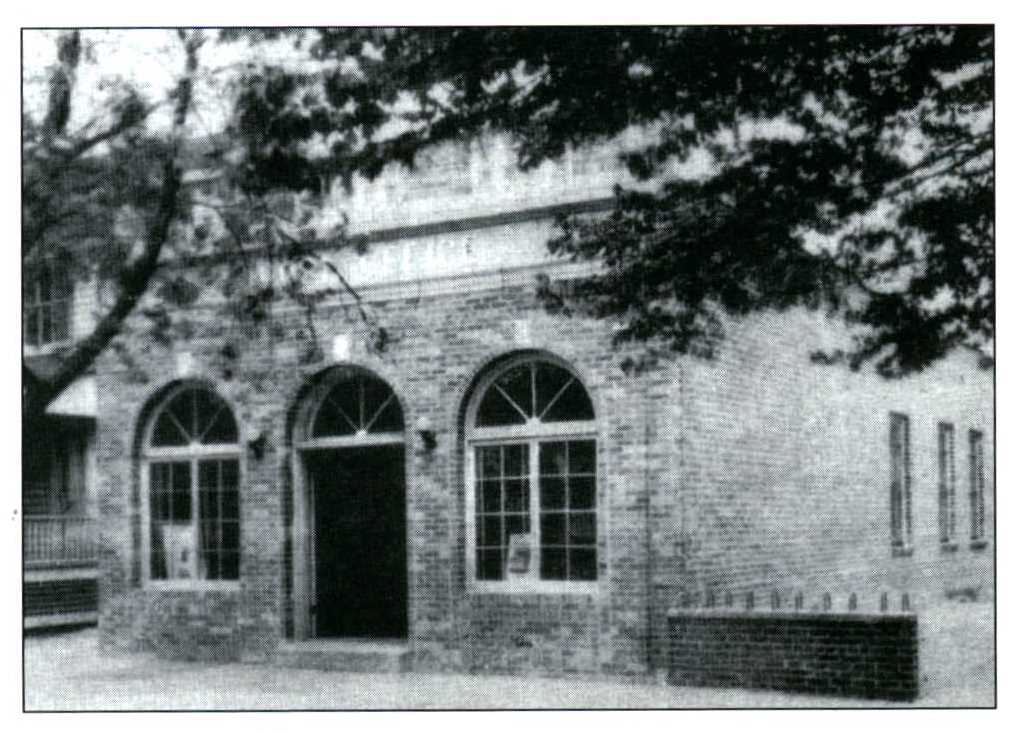
Clarence E. Hirsch was postmaster from 1922 to 1929, conducting the post office from his South Wellwood Avenue store until this brick post office was opened in 1928 just north of the Catholic church on Wellwood Avenue. In 1929, Herbert Torns, grandson of previous postmaster Frederick Torns, Sr., succeeded Hirsch. Herbert initiated the campaign for home mail delivery & served on a commission to rename many local streets & assign house numbers to facilitate the delivery service.
Ramsauer Plumbing & Building
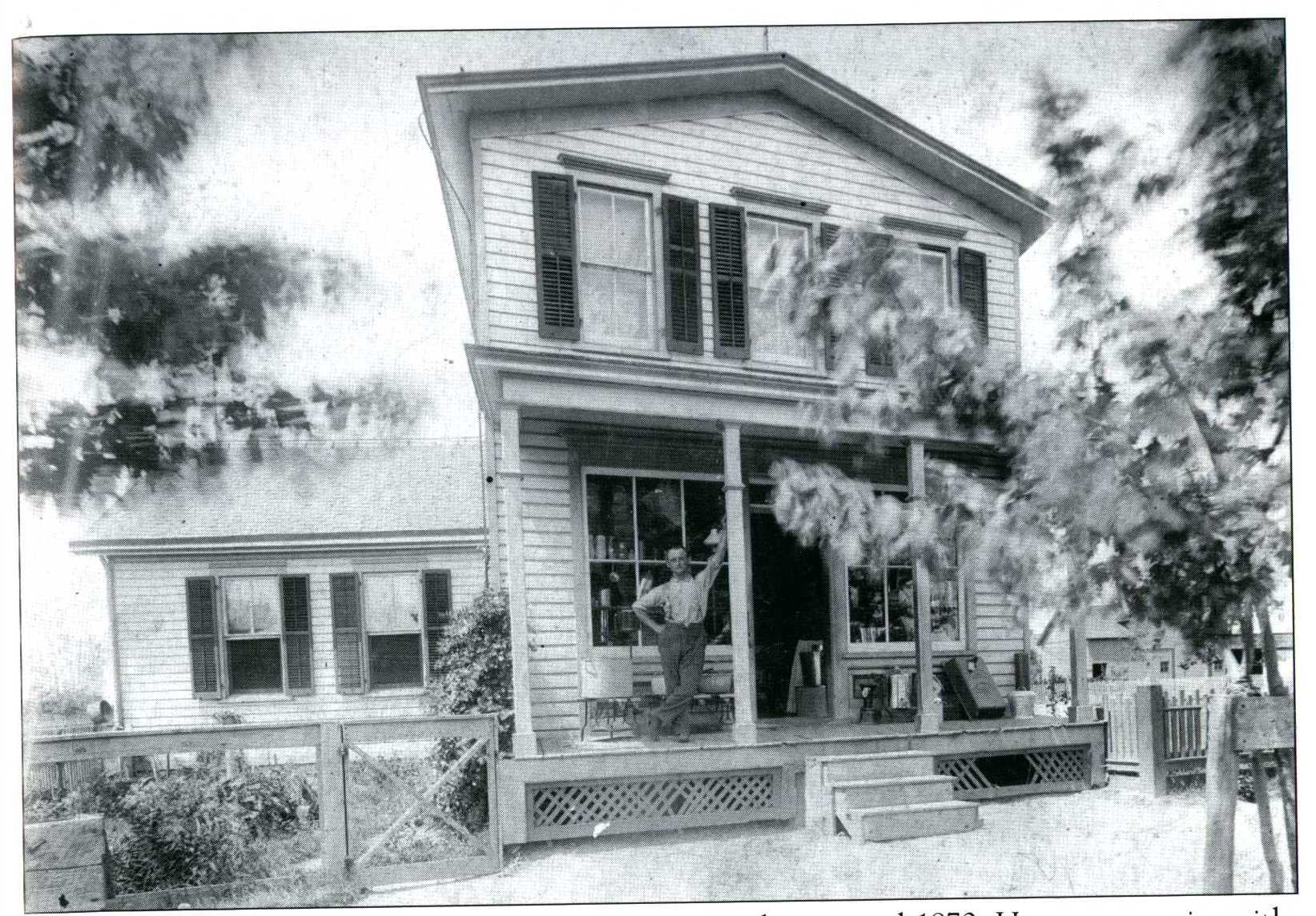
Swiss natives Henry & Rosa Ramsauer came to Breslau around 1870. Henry was a tinsmith, plumber & builder. He is pictured at his Wellwood Avenue shop around 1890. After his death, Rosa operated a hardware store. Her 1918 obituary in the South Side Signal recalled, "Mrs Ramsauer offered her store for a meeting room...(and) took an active part in the Red Cross work often sitting with the members knitting articles for the boys at the front", during World War One.
John Knecht, Cobbler
Edelman Clothing & Department Store
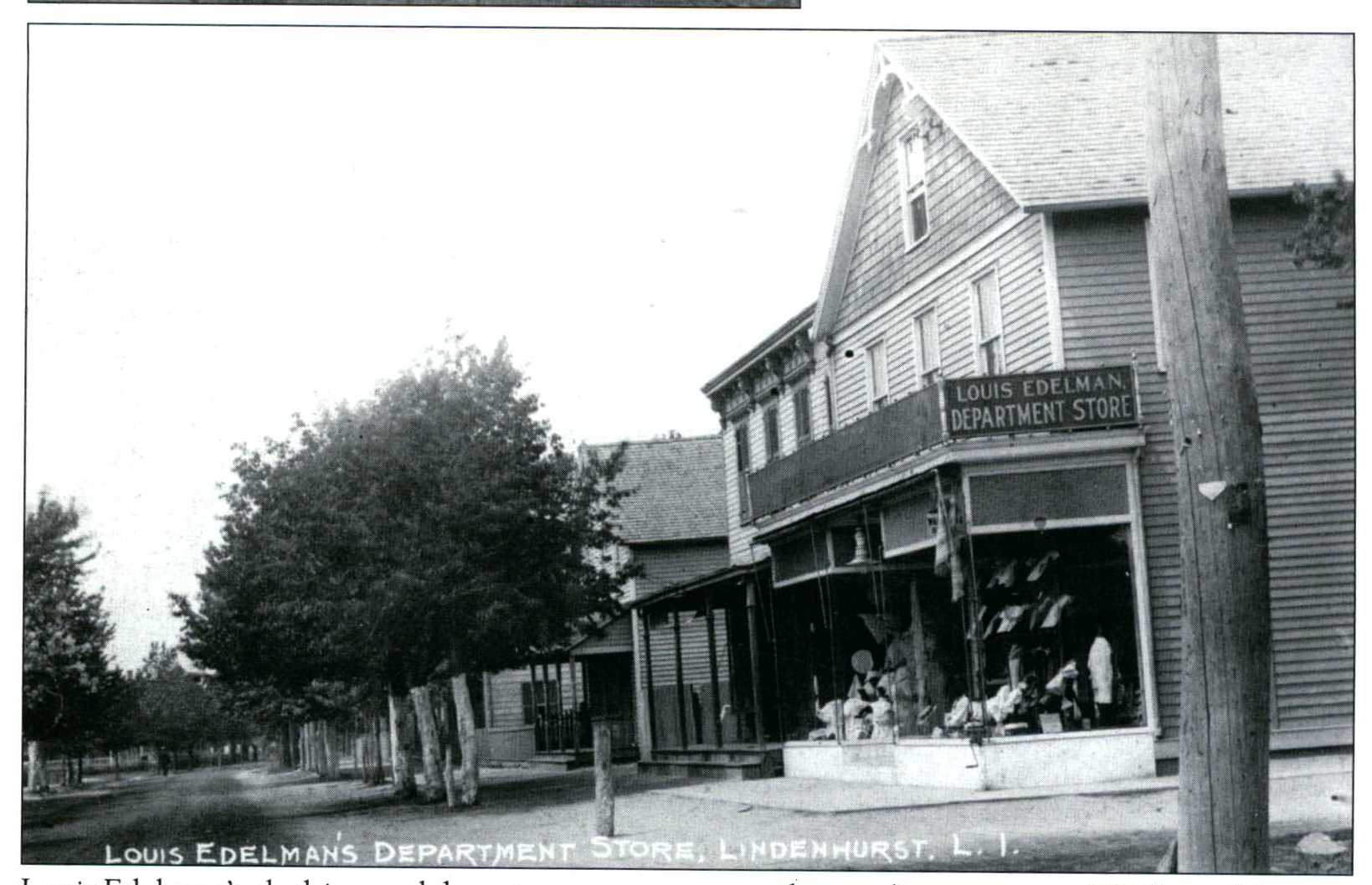
Louis Edelman's clothing & department store was on the northeast corner of Wellwood Avenue & East John Street. In 1913, Edelman erected a 2-story building behind the store for an embroidery factory. The addition of Edelman's 4 machines reportedly brought the total number of embroidery machines in the village to nearly 100. Edelman purchased Louis Liebl's embroidery plant in 1916.
National Theatre Ground Breaking
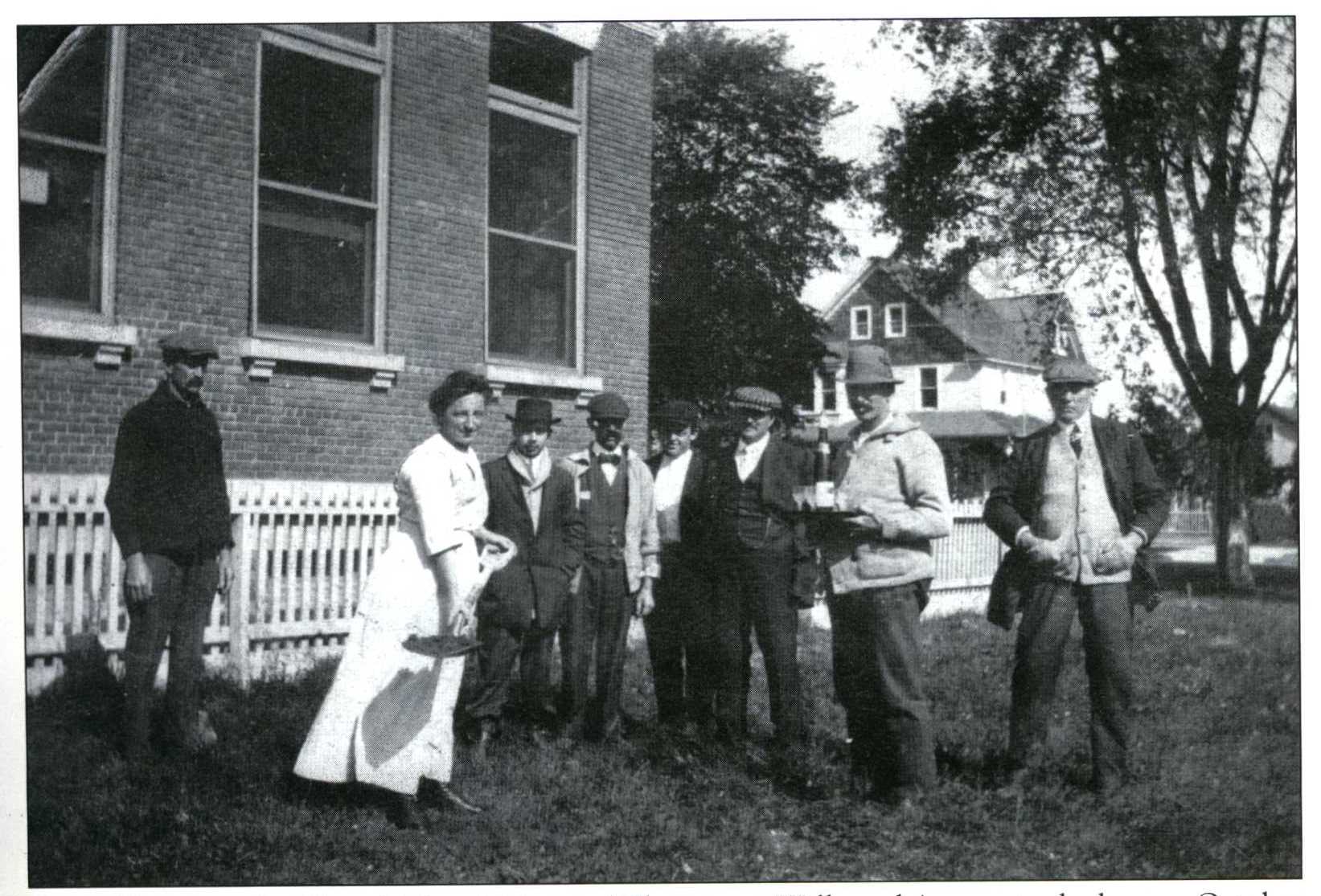
Ground breaking for Edward Gleste's National Theatre on Wellwood Avenue took place on October 13, 1913. Presented with a spade by contractor George Weierter, Edward's wife, Flora Gnilka Gleste (2nd from left), "removed the 1st earth, when a number of friends extended to Mine Host Gleste all kinds of good luck in the new venture," reported the South Side Signal. The grand opening took place on December 27, 1913, with 2 shows featuring music by Wrieth's orchestra.
National Theatre & First National Bank

The west side of Wellwood Avenue is pictured on July 5, 1915, showing the National Theatre, First National Bank, Kienle's Dry Goods Store, & Lindenhurst Candy Kitchen. The whitewashed tree trunks were part of the recent Pfingst celebration. During World War I, the National Theatre hosted shows benefiting the local Red Cross. The entertainment hall was also the site of local Democratic rallies, as Republicans typically met at Washington Hall.
Button Factory (Lindenhurst Manufacturing Company)
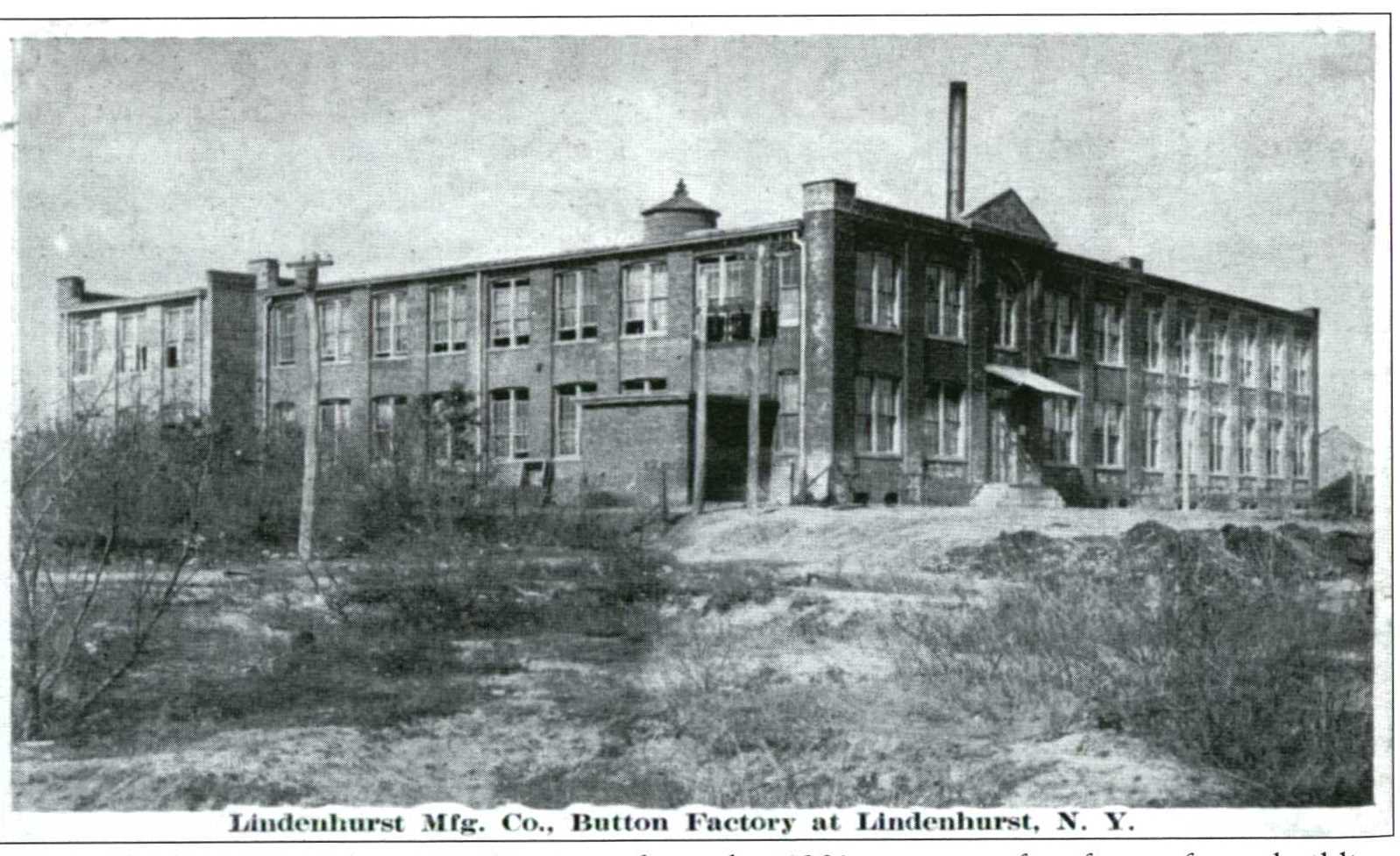
The Lindenhurst Manufacturing Company formed in 1901, operating 1st from a frame building purchased from Frederick Henke on Travis Avenue. It moved into a new brick factory known as the Button Shop on Smith Street in 1909. The factory produced buttons from animal hooves & horns. When the Vulcanite factory discontinued making buttons in 1904, Lindenhurst Manufacturing purchased its dies & machines. Automatic machines were installed in the late 1920's.
Handkerchief Factory (2nd School Building)
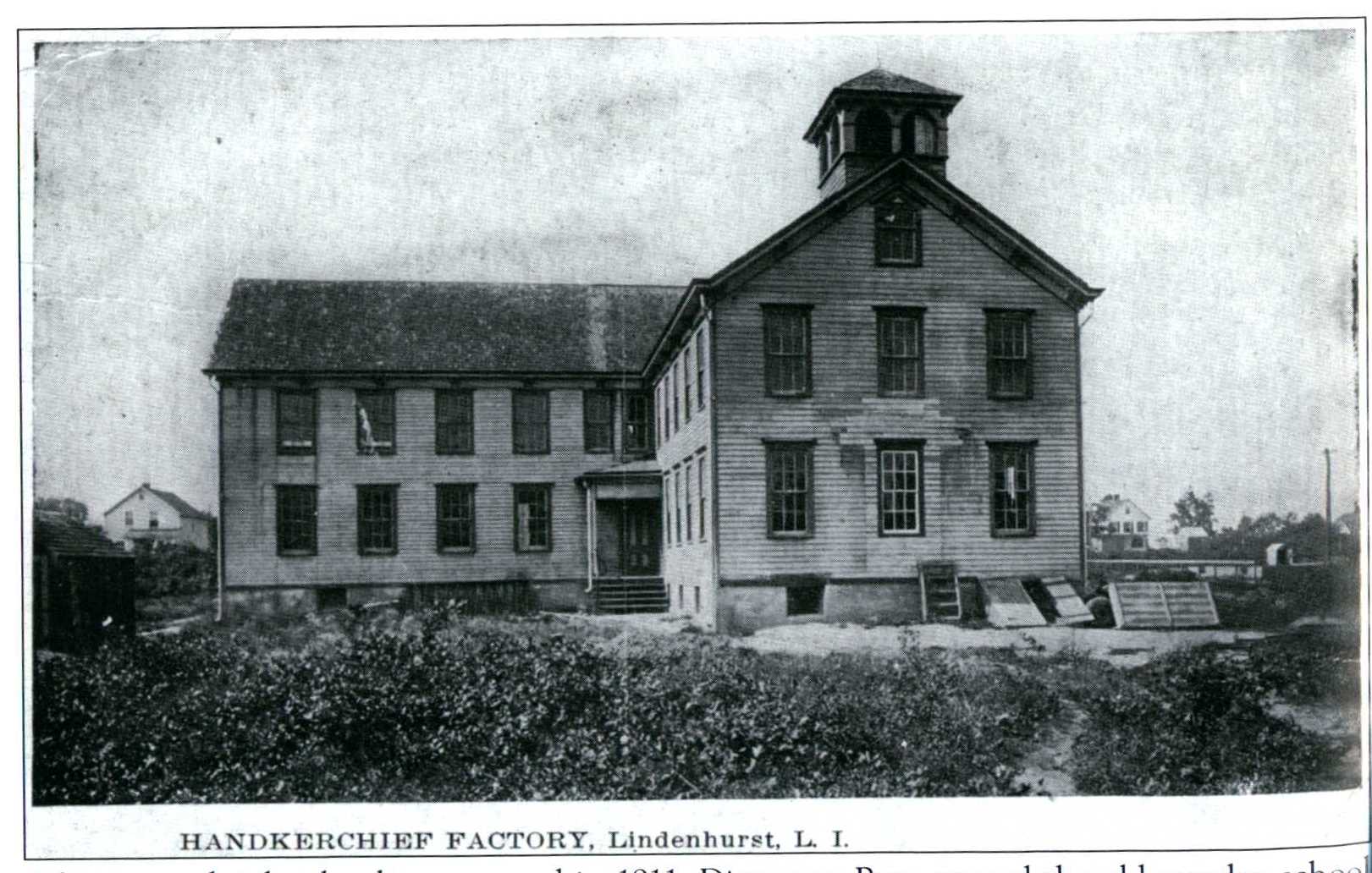
After a new brick school was opened in 1911, Dittmann Bros. moved the old wooden school facing 4th Street for use by the Lindenhurst Shoe Company. The shoe factory was short-lived, closing in 1913, not long after violations of child labor laws. The Long Island Embroidery Company quickly took occupancy, & the building was known as the Handkerchief Factory. In 1913, Lindenhurst had 80 embroidery machines operating in 23 factories. The old timber building succumbed to fire on January 6, 1960. Its last occupant was the Staple Coat Retail Outlet.
Hohlbein Carpentry Shop
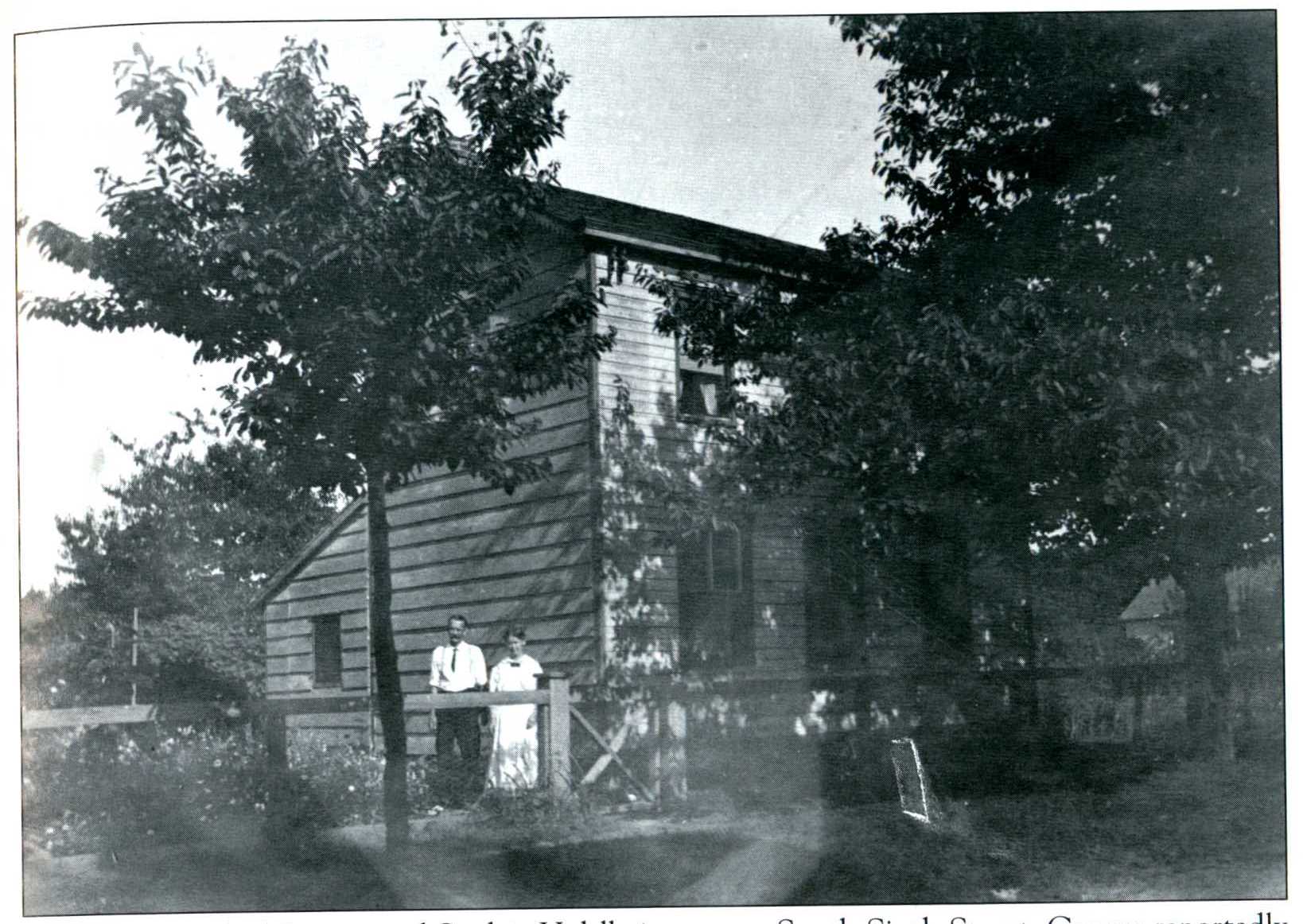
The homestead of George & Sophia Hohlbein was on South 6th Street. George reportedly opened the 1st carpenter shop in Breslau in 1870. An 1882 advertisement boasted "G.J.E. Hohlbein, Manufacturer & Dealer in Fine Furniture, Hoffman Ave., 4th door west of Nehring's Hotel...Upholstering in all of its branches. Mattresses made & overhauled. Furniture neatly repaired." Son Charles continued the furniture business. He is pictured with his wife, Minnie, around the 1920's.
Strack Hardware & Dry Goods Store.
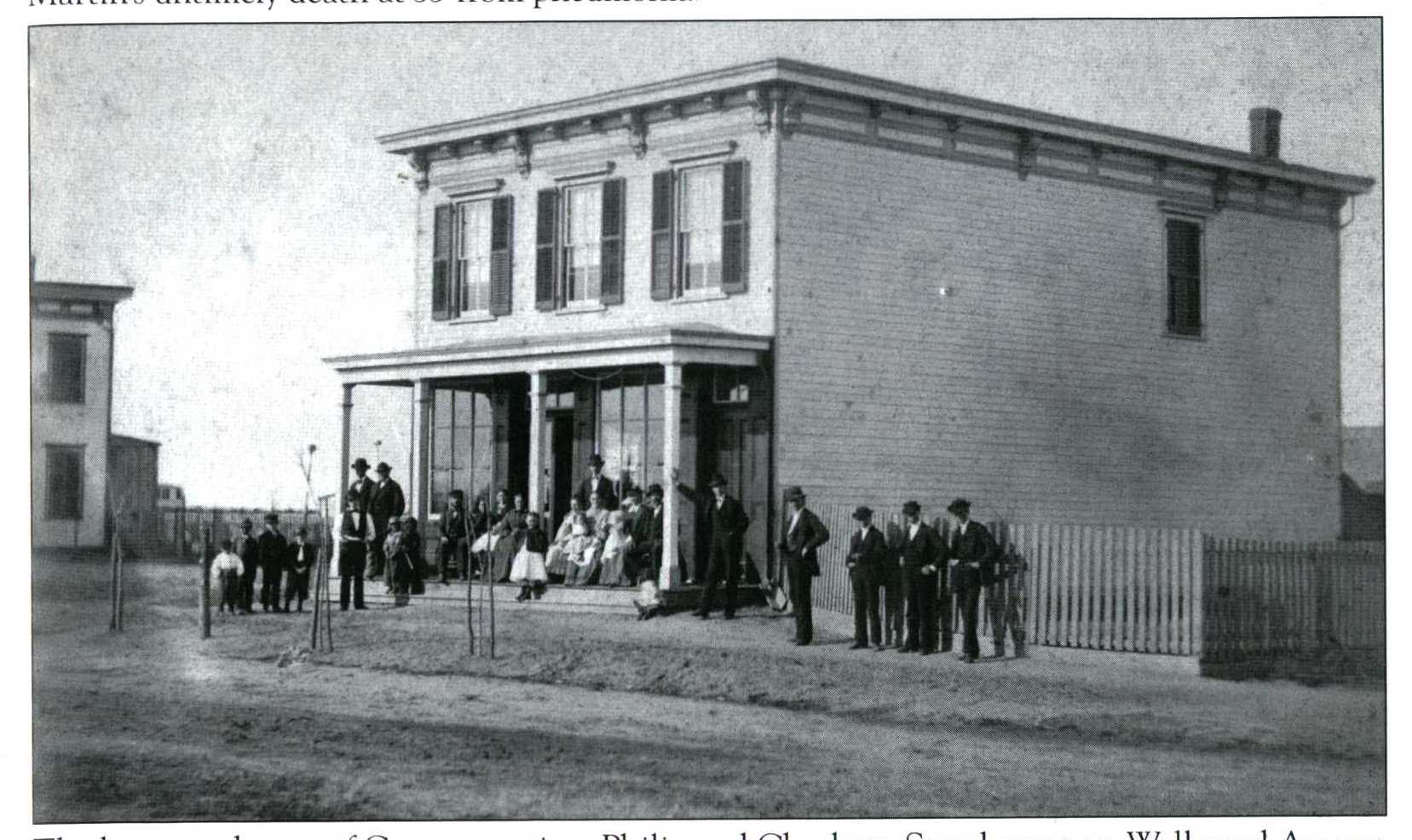
The home & store of German natives Philip & Charlotte Strack were on Wellwood Avenue between Easton & Dover Streets. In 1861, 2 years after his arrival in America, Philip enlisted in the Navy, & served 3 years during the Civil War aboard the frigate USS Potomac. After arriving in Breslau in 1871, he operated a hardware & dry goods store, later conducted by his daughter Louise & her husband, Charles Riehl.
1915 Factories Map

This 1915 map shows the neighboring Vulcanite Manufacturing Company & Lindenhurst Manufacturing Company (The "Button Factory") on either side of South Smith Street, formerly Dougherty Avenue. The factories were points of pride for the community, not only for the workmanship of their products but also because the facilities represented the growth of the community & success as a modern town that combined residential living & industrial employment. The Lindenhurst Manufacturing Company closed its doors in 1971, & the building was destroyed by fire in 1983. The Vulcanite Manufacturing Company went out of business in 1937. The following year, the building was acquired by Lakeville Industries, which started manufacturing kitchen & bathroom cabinets in 1935. The company relocated after 80 years & the old Vulcanite Factory building was demolished in 2019, replaced by the Wel apartment complex.
